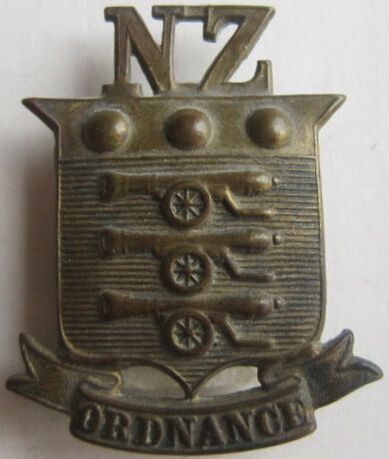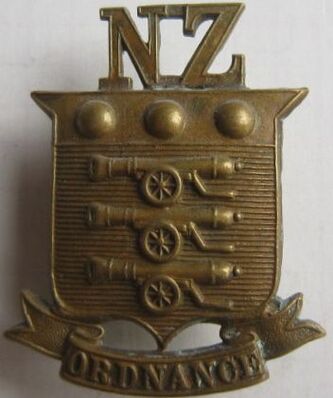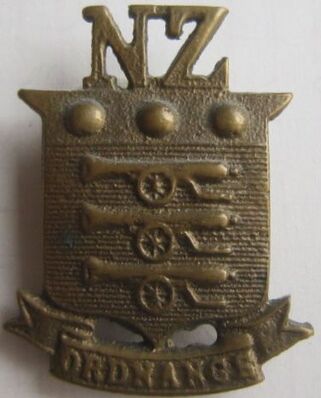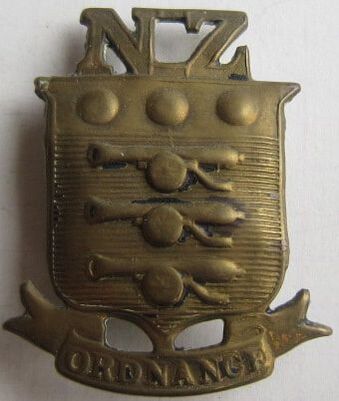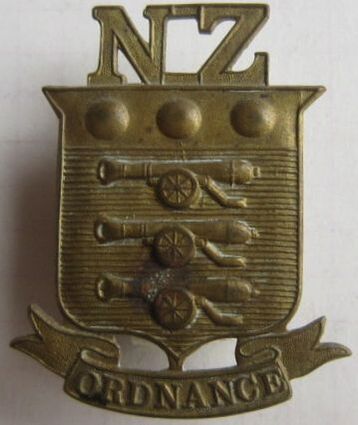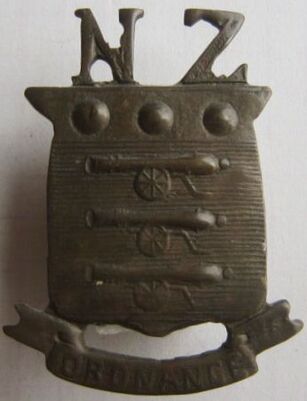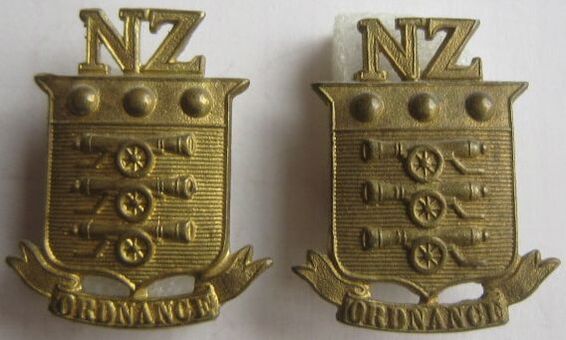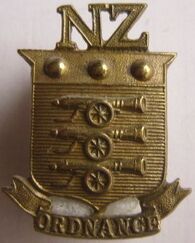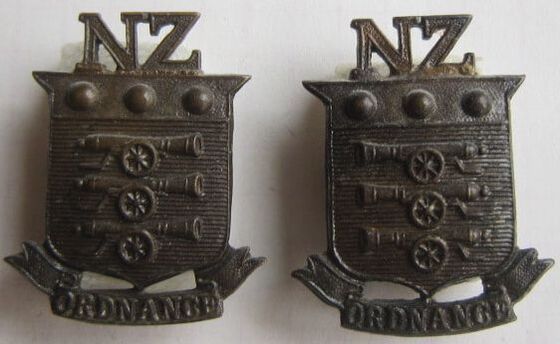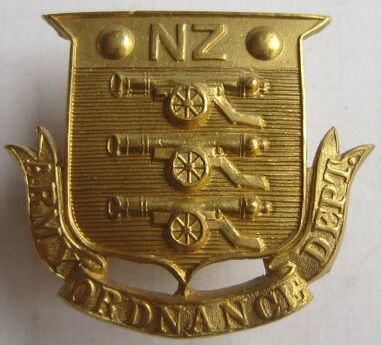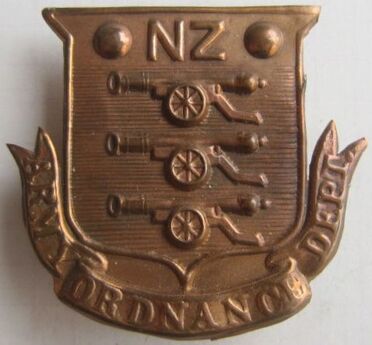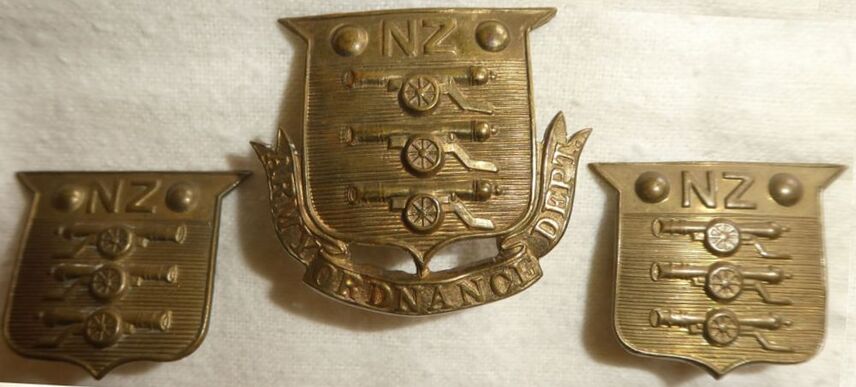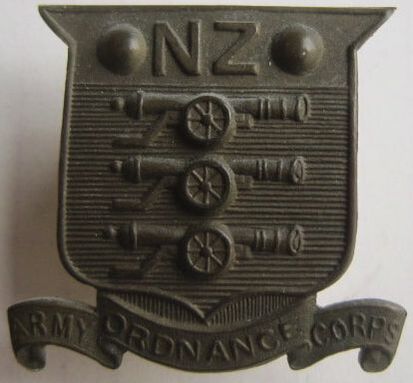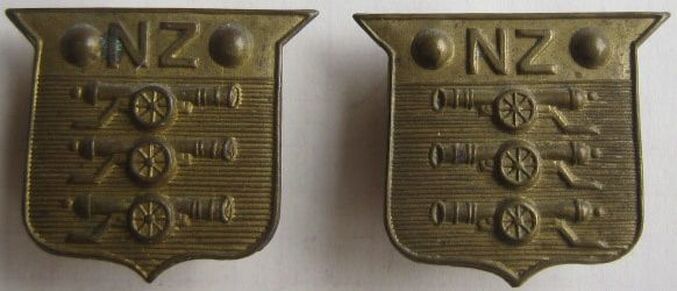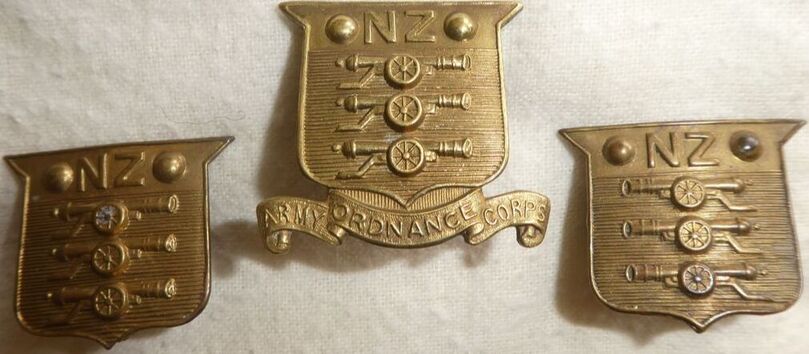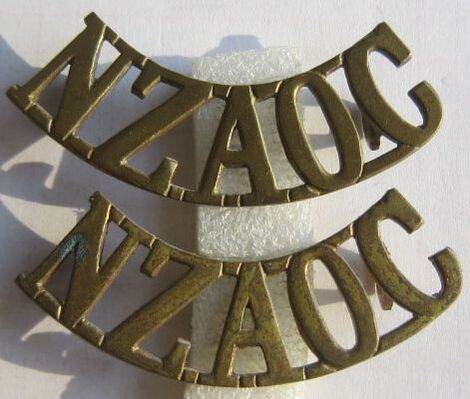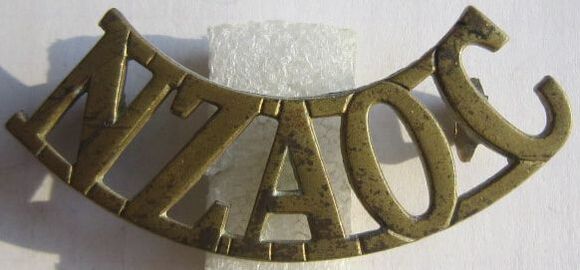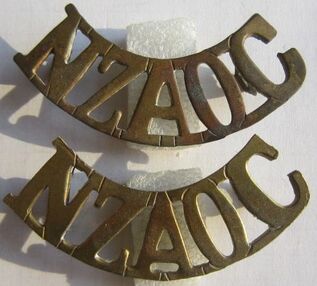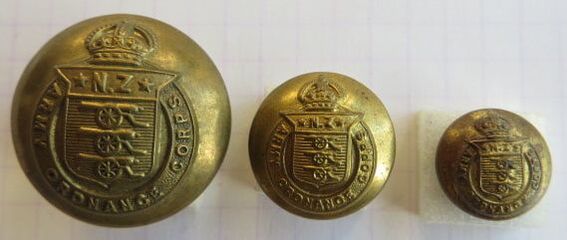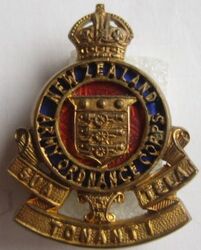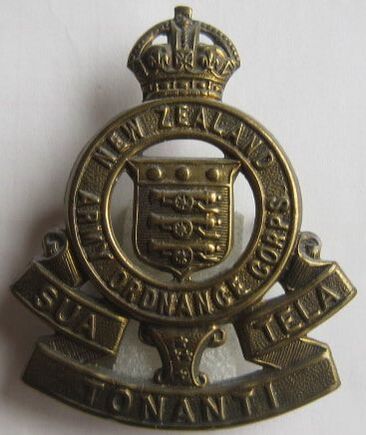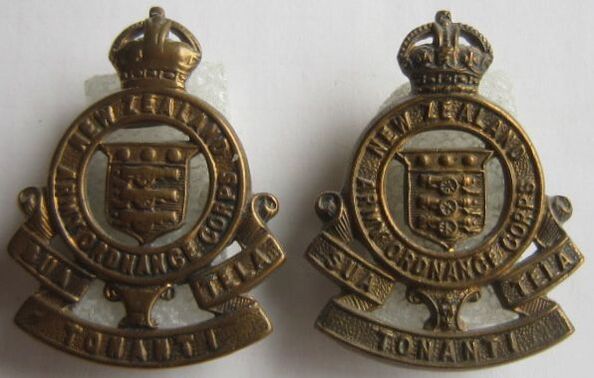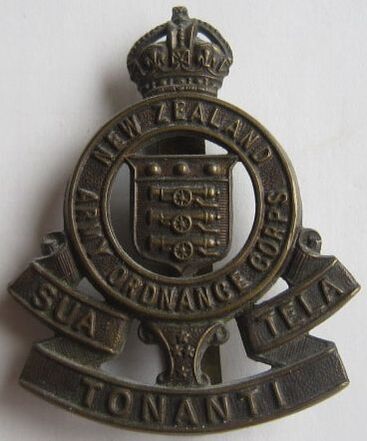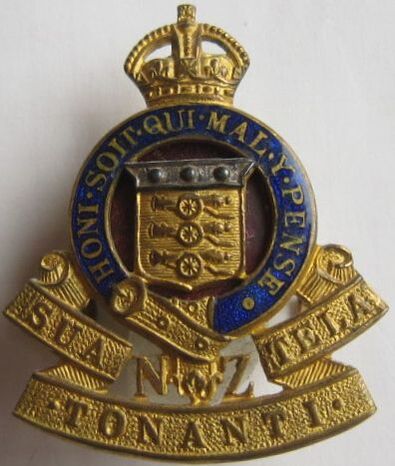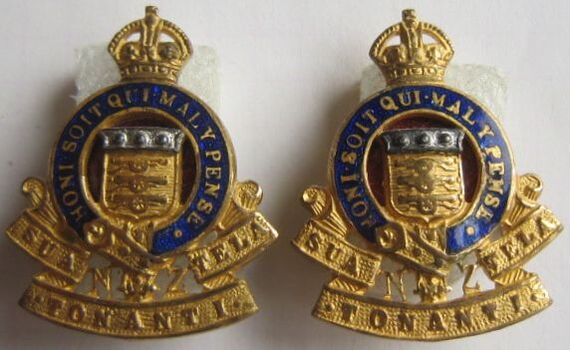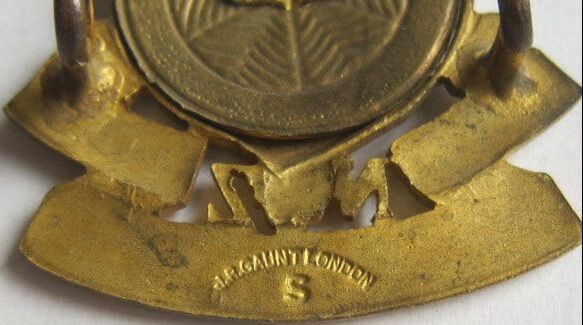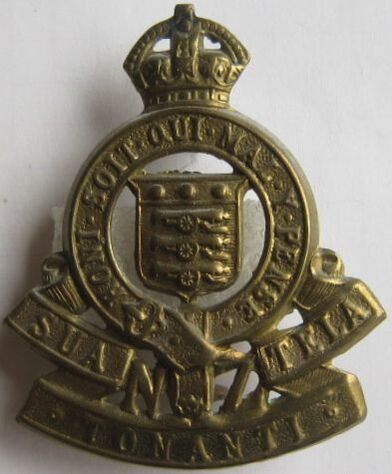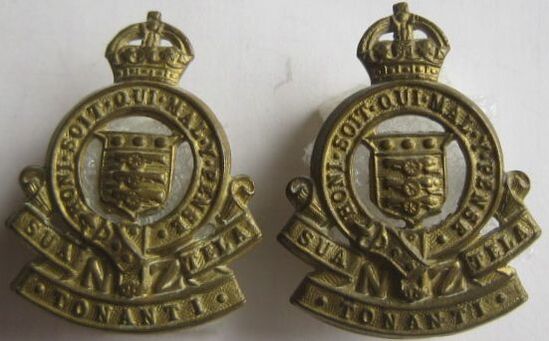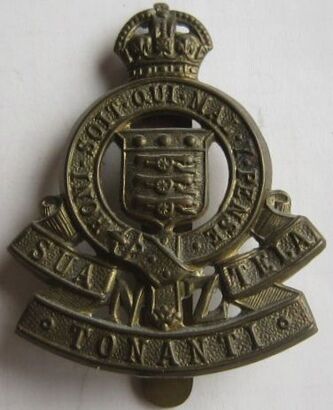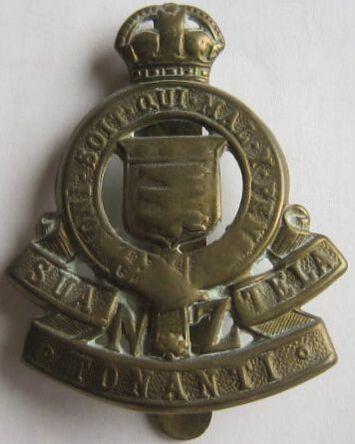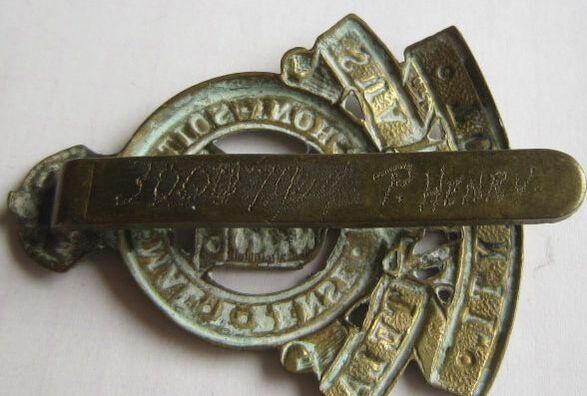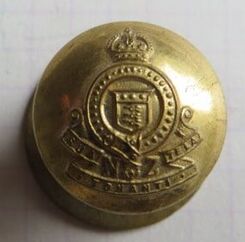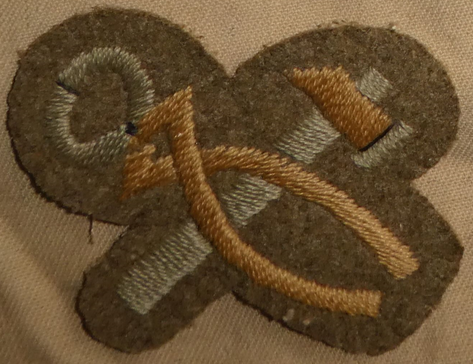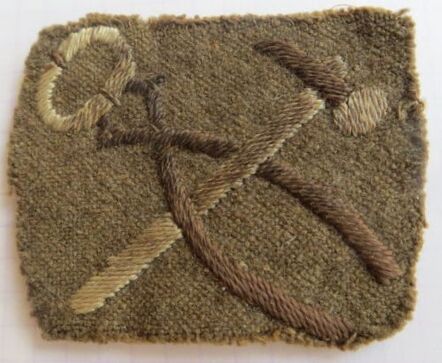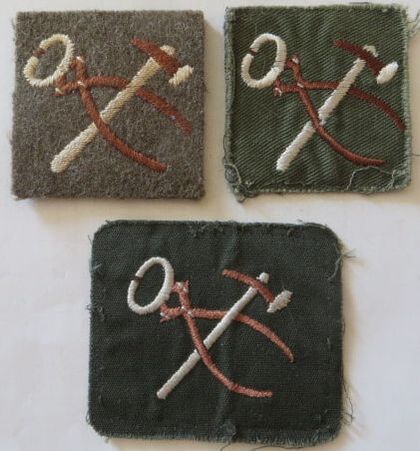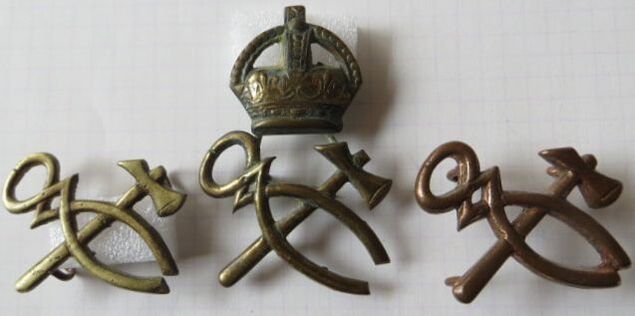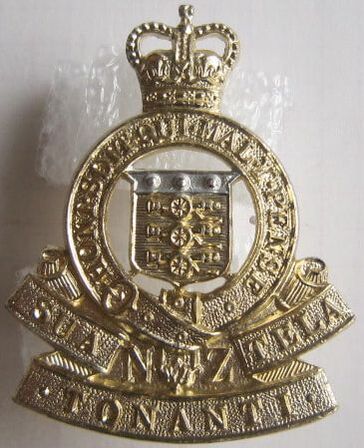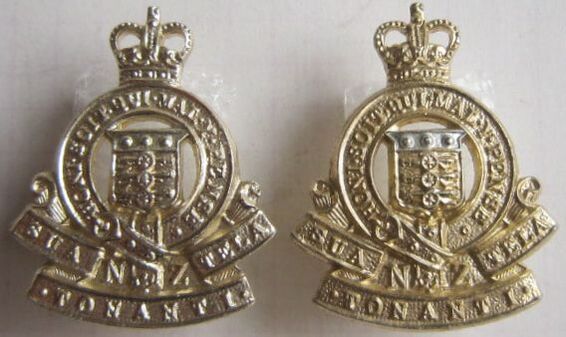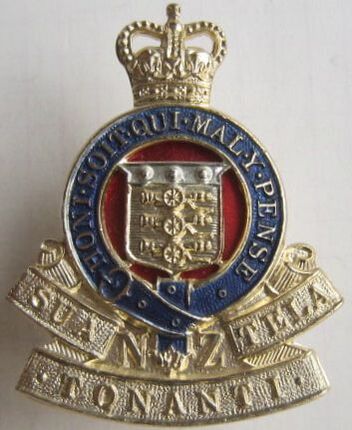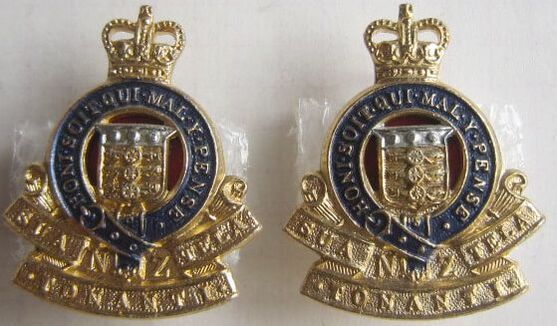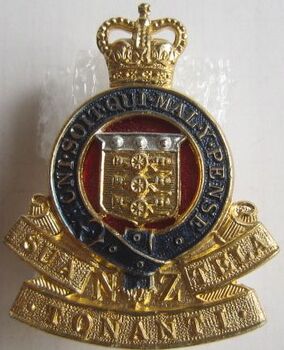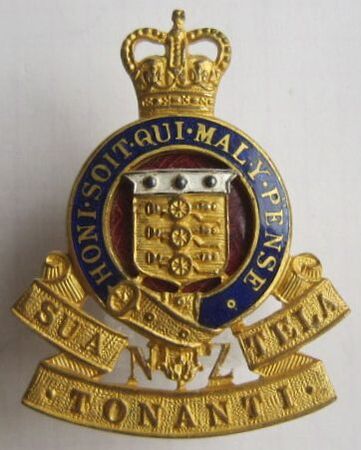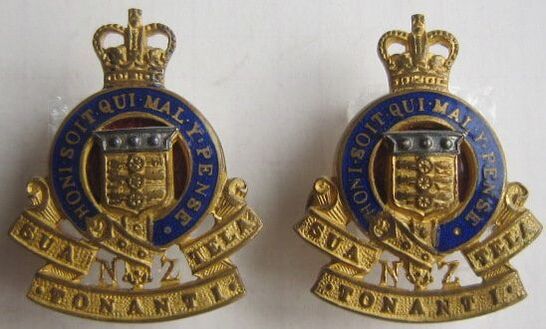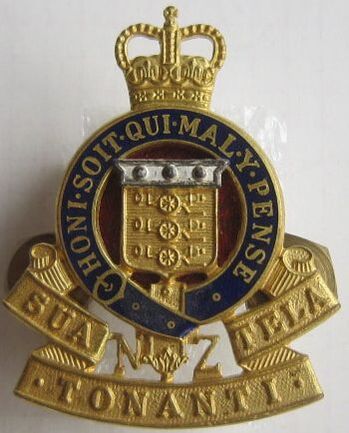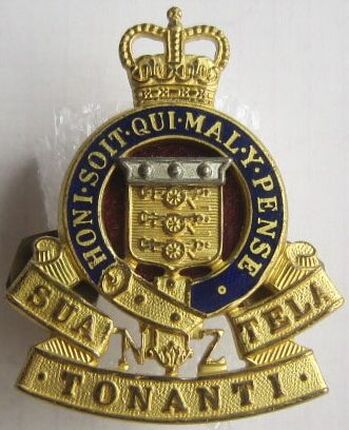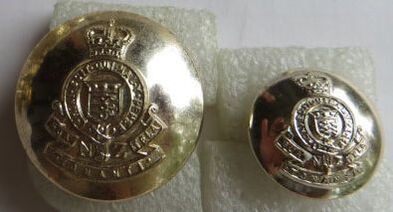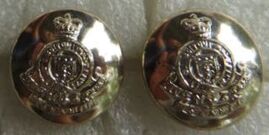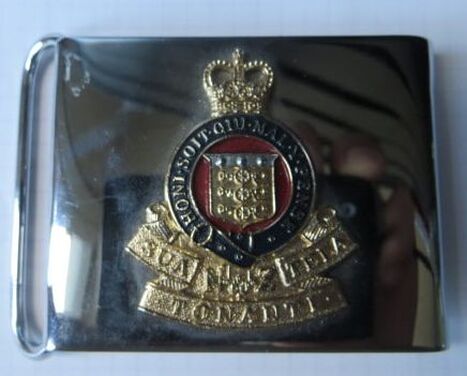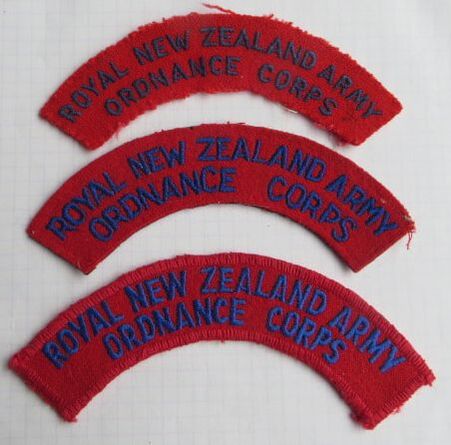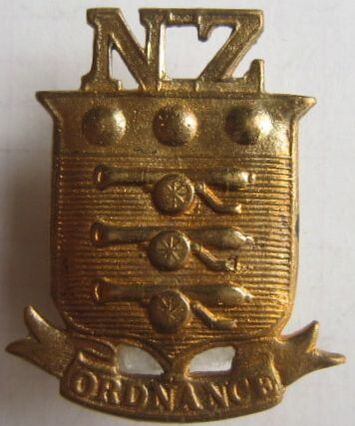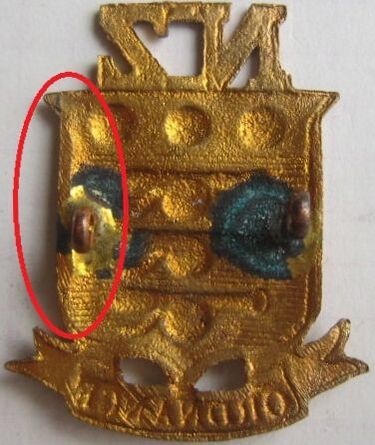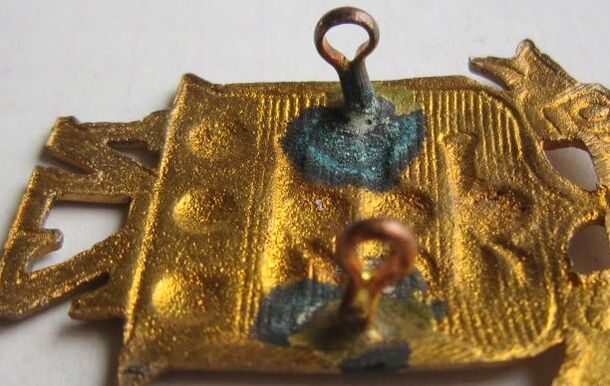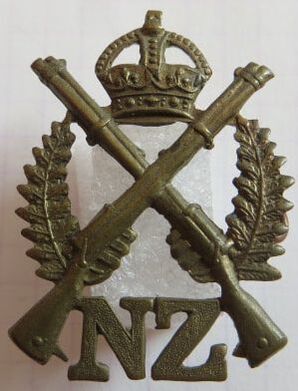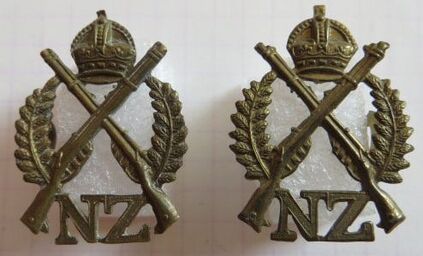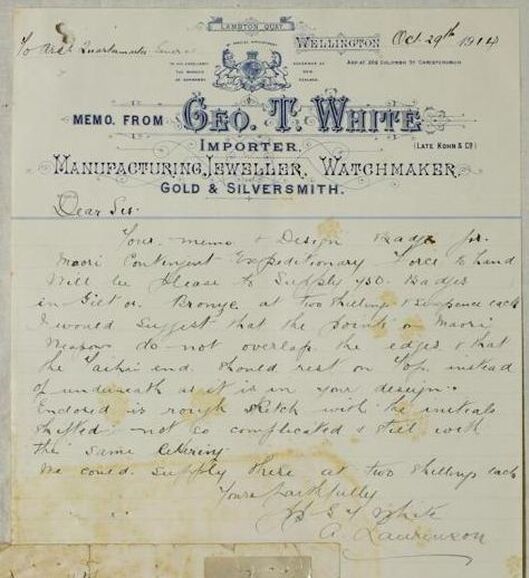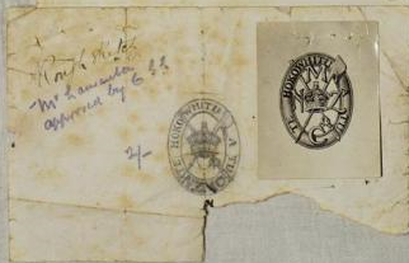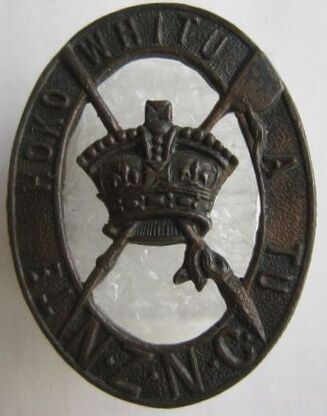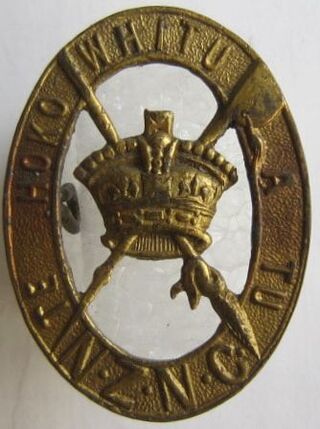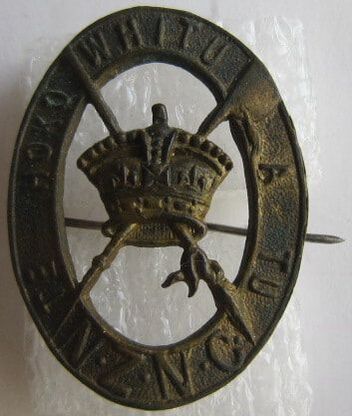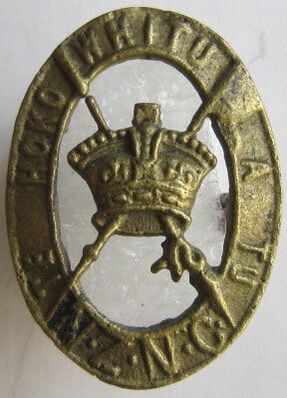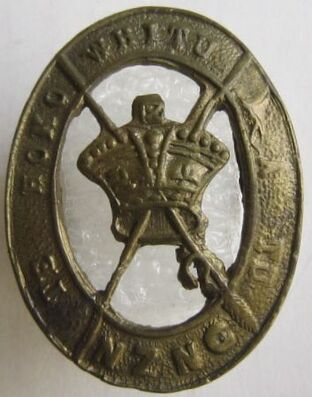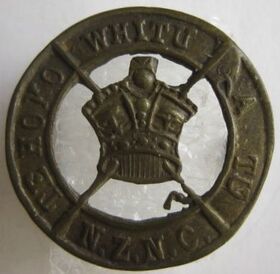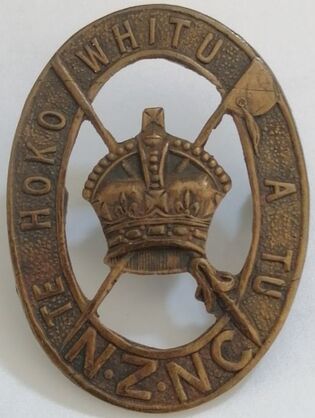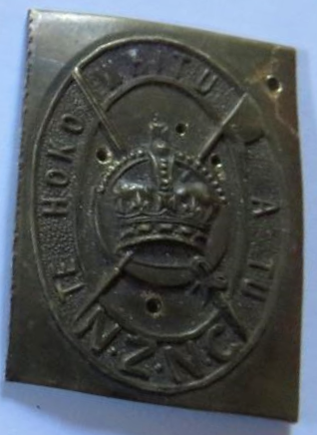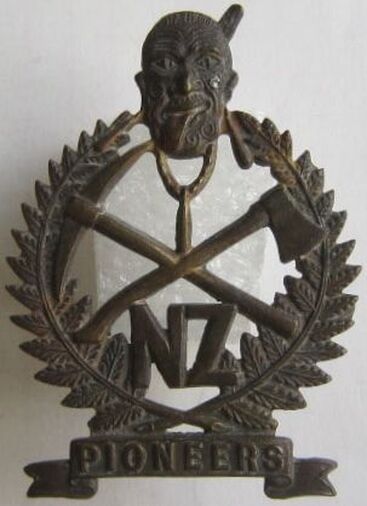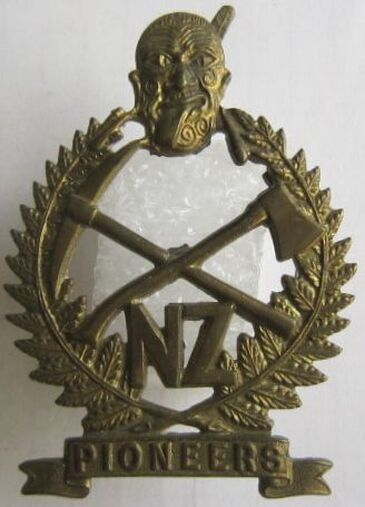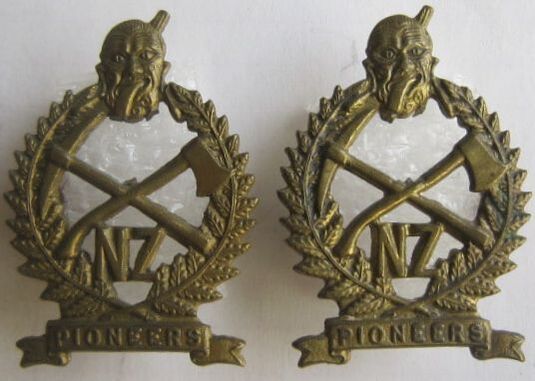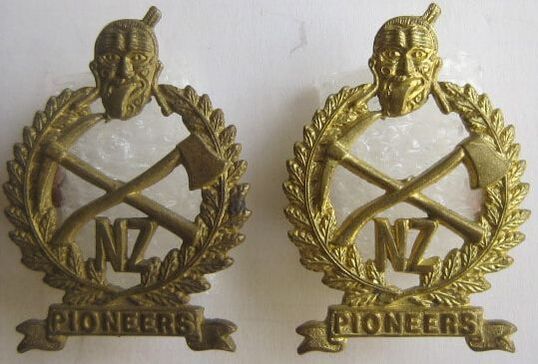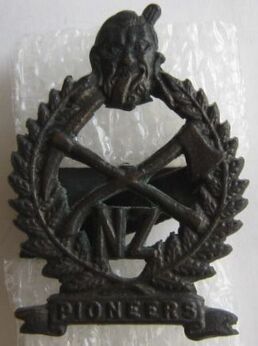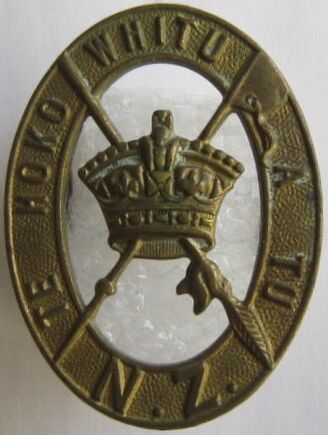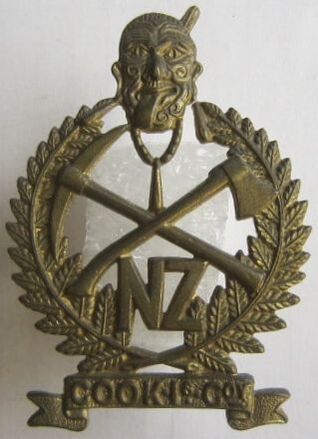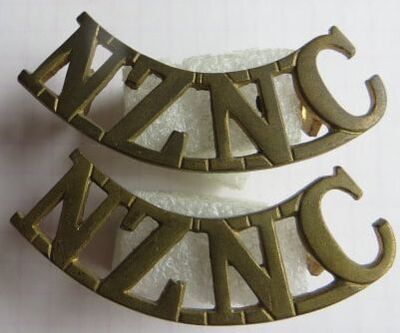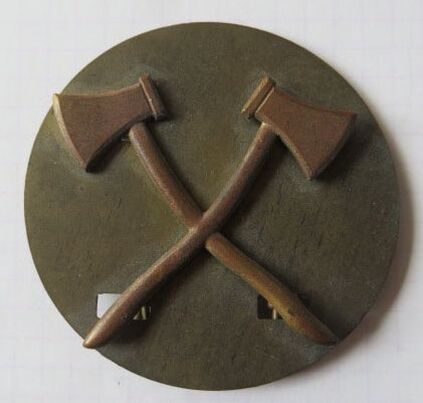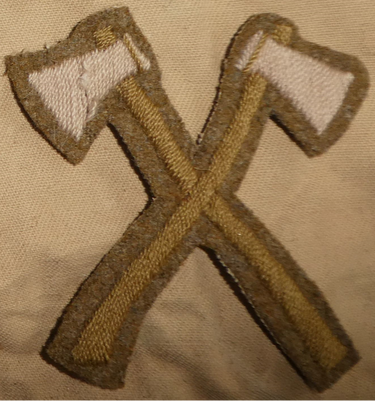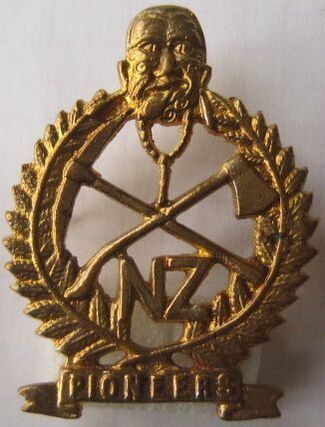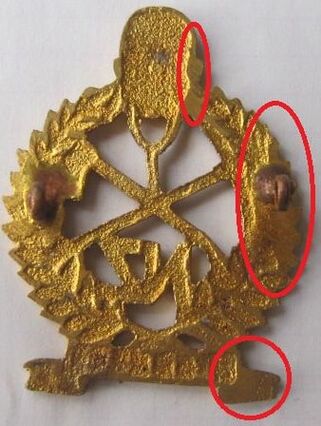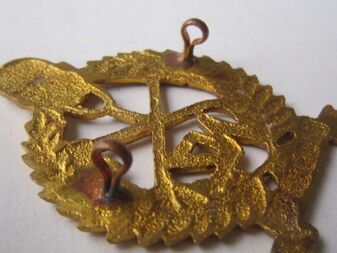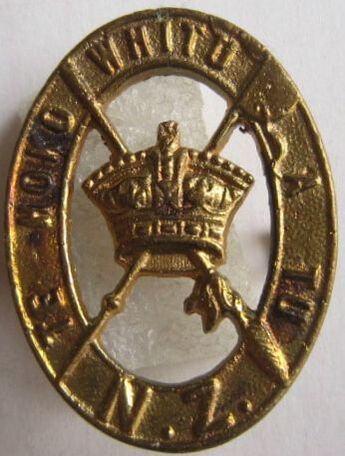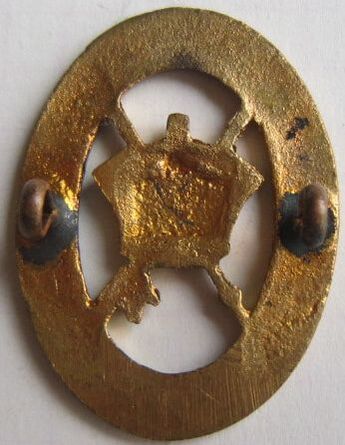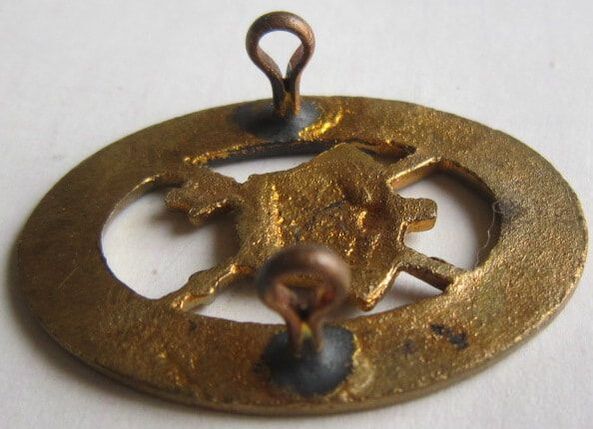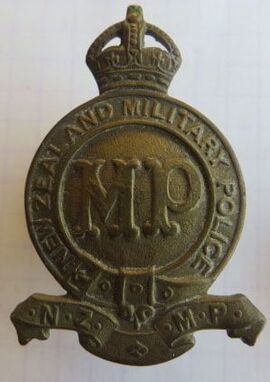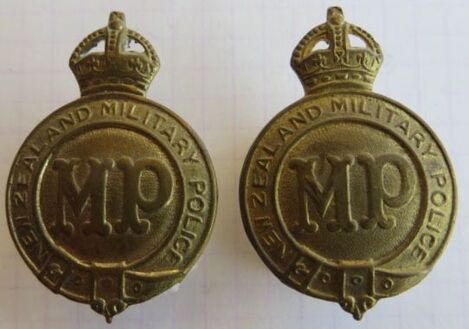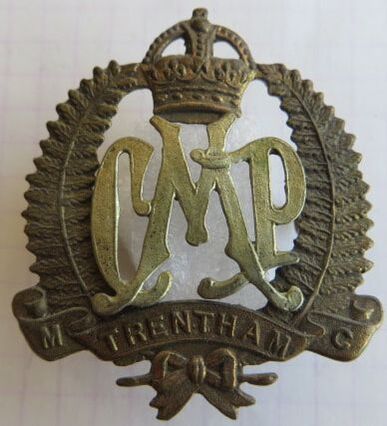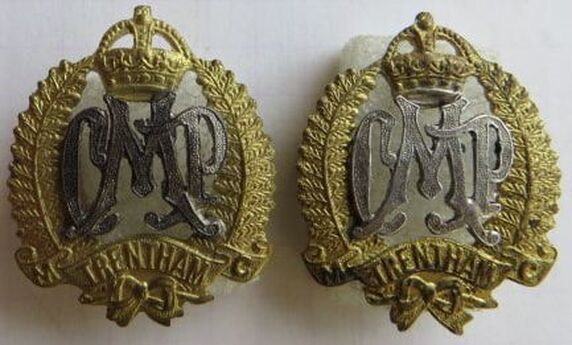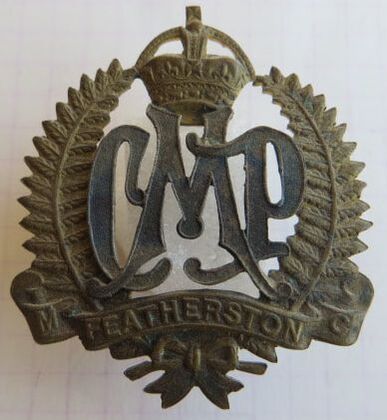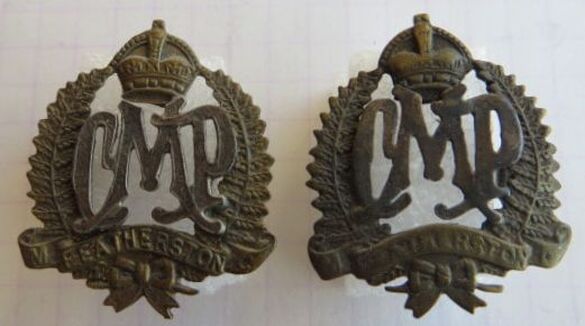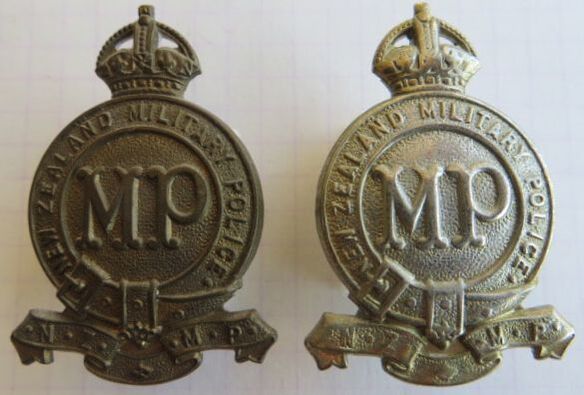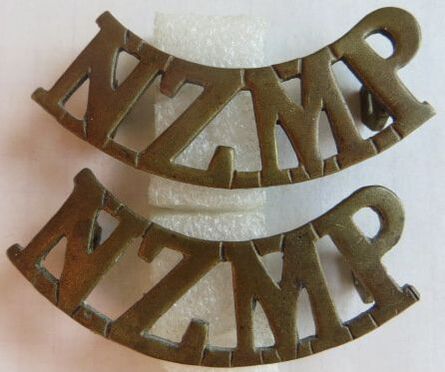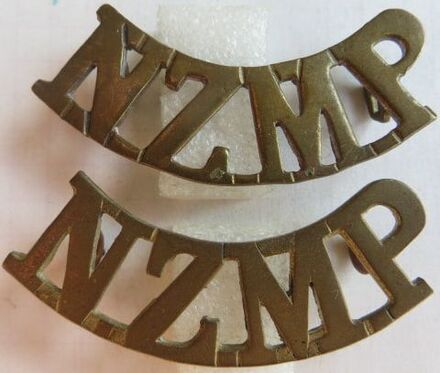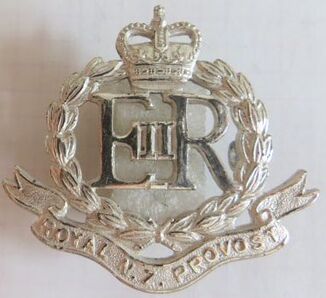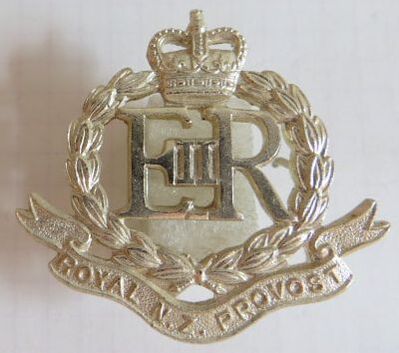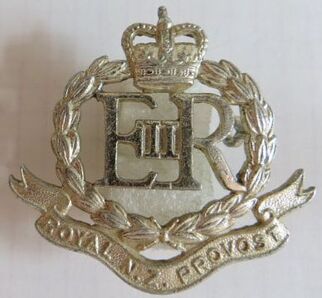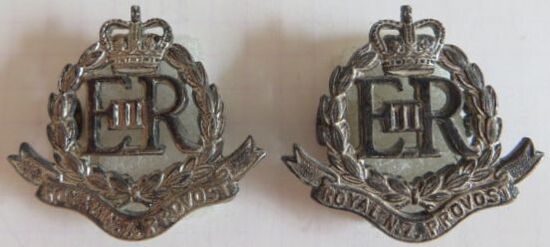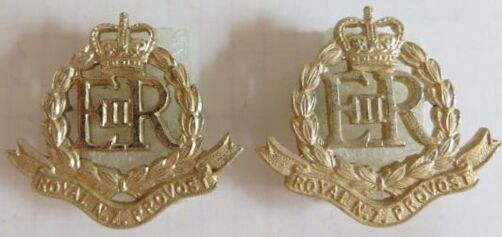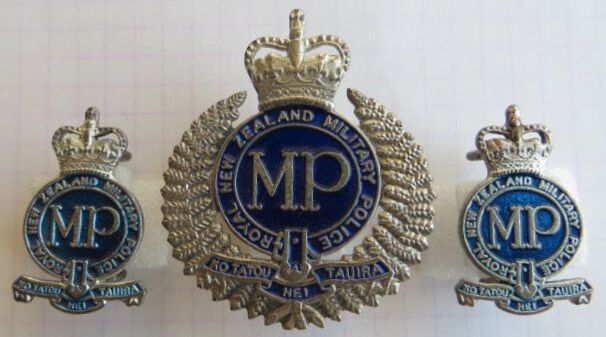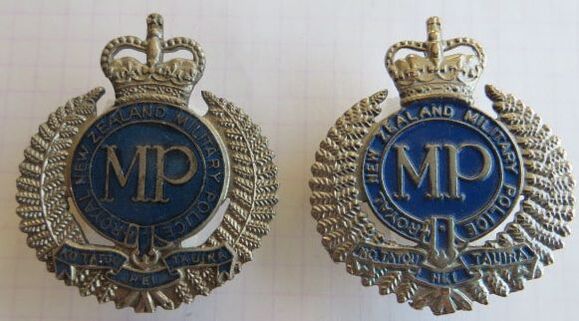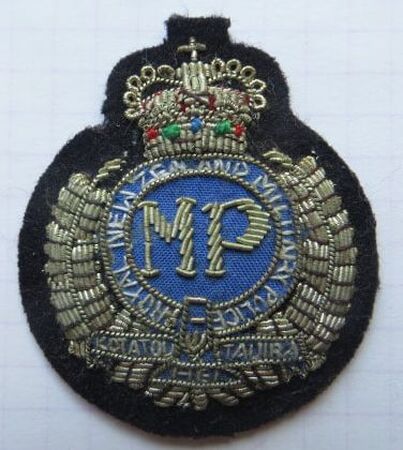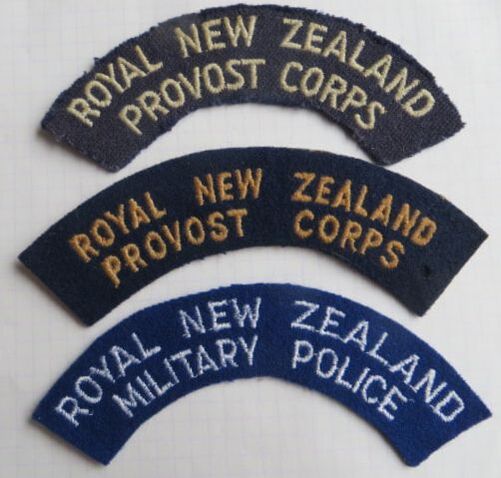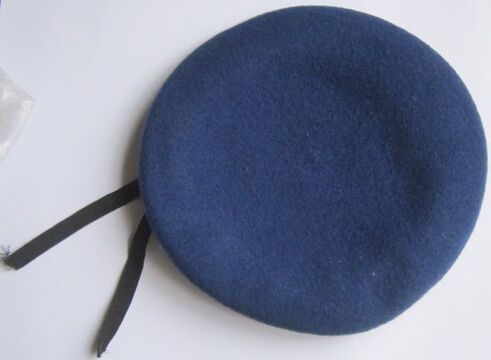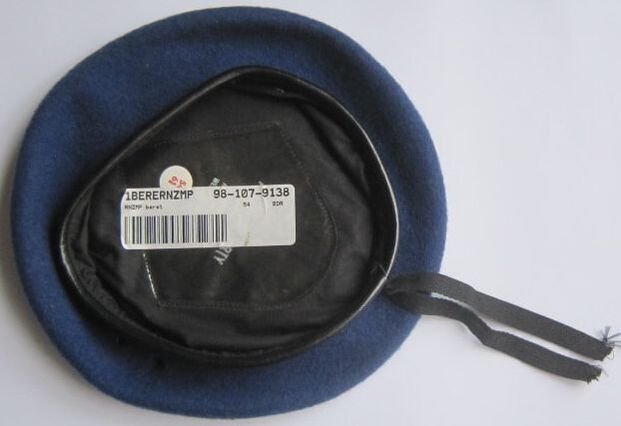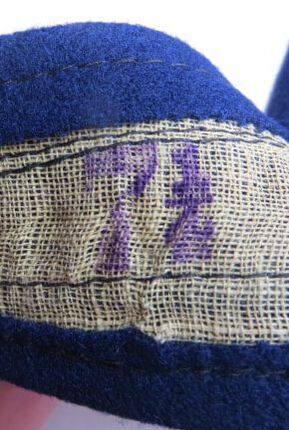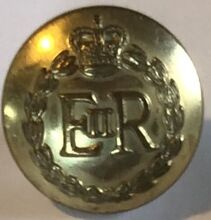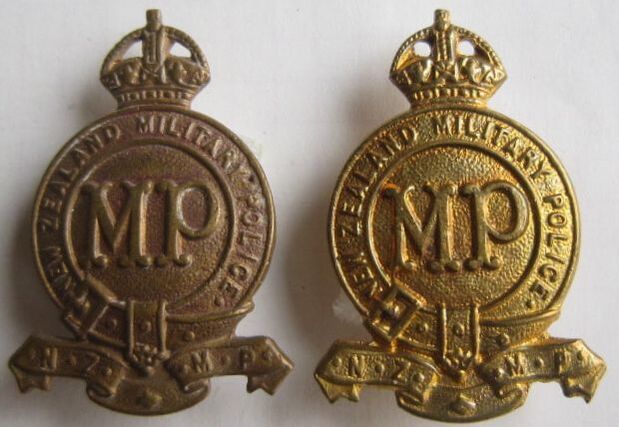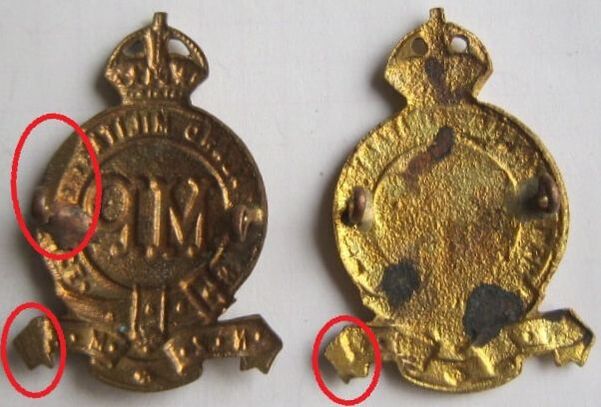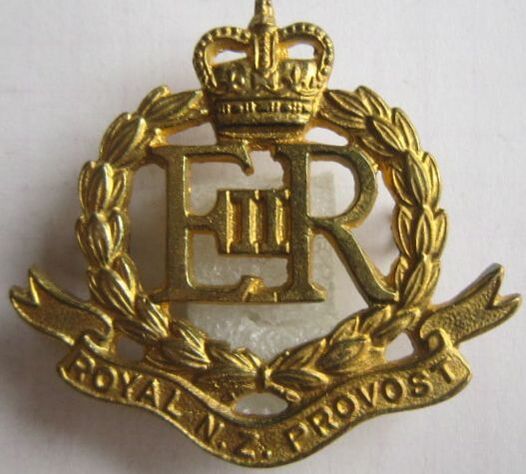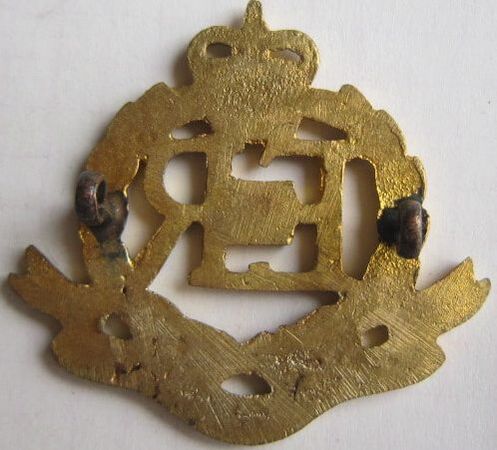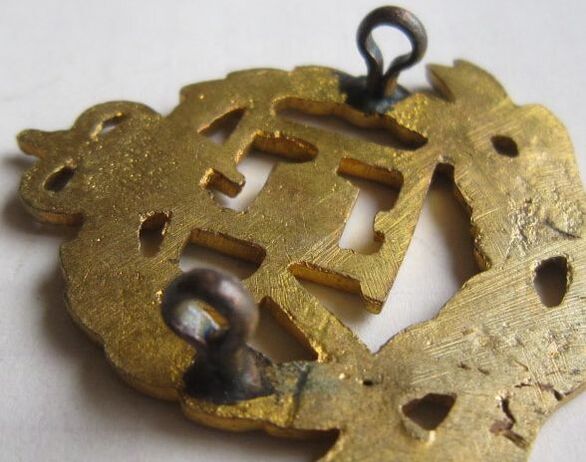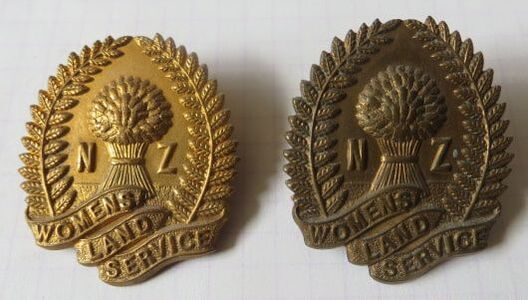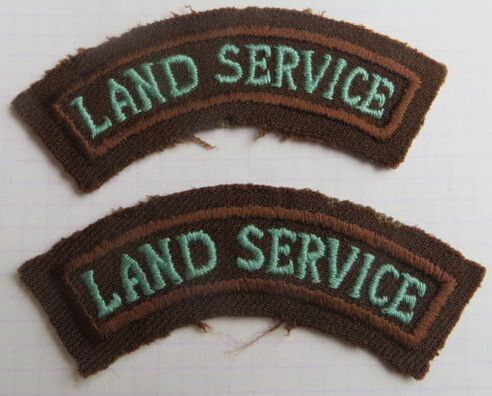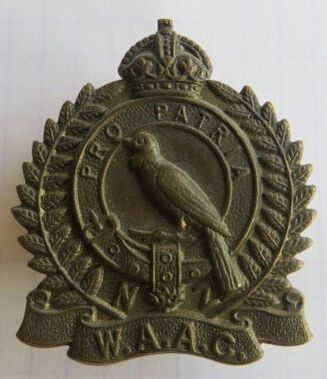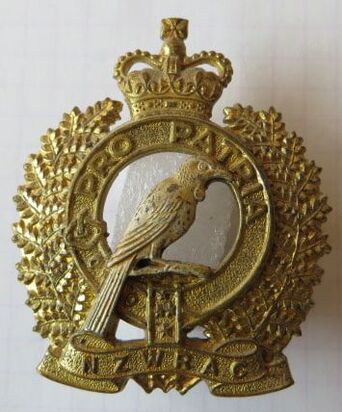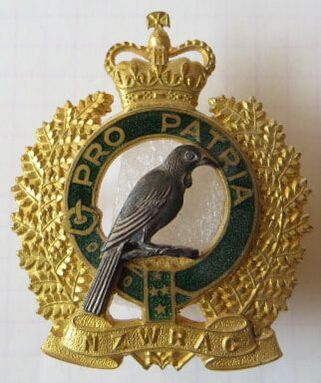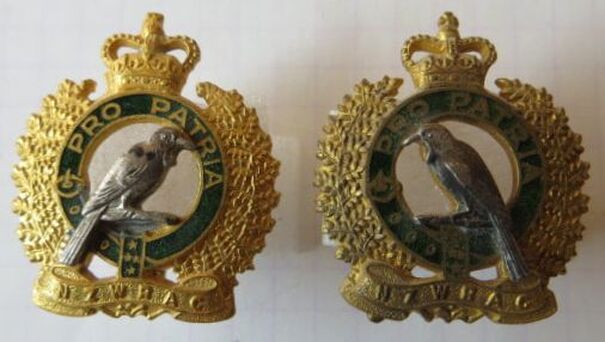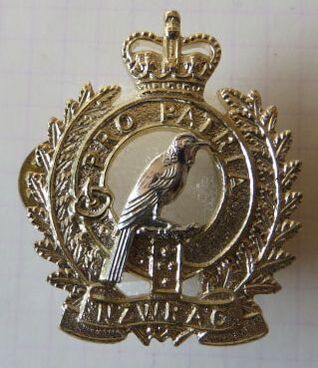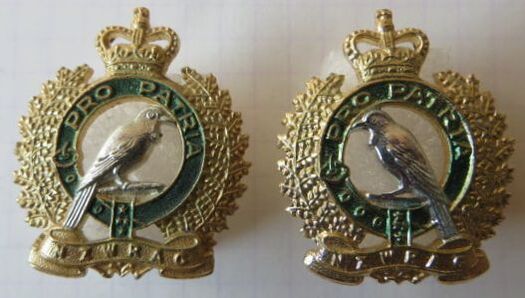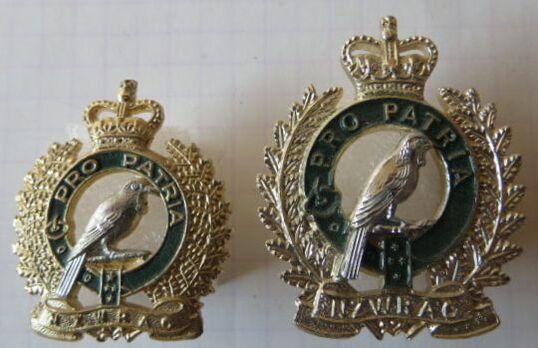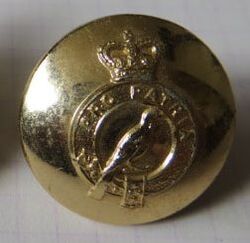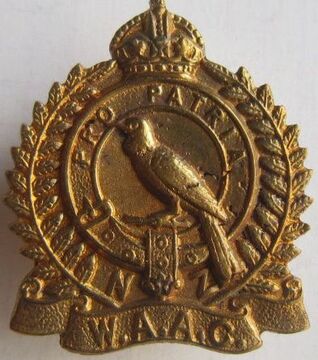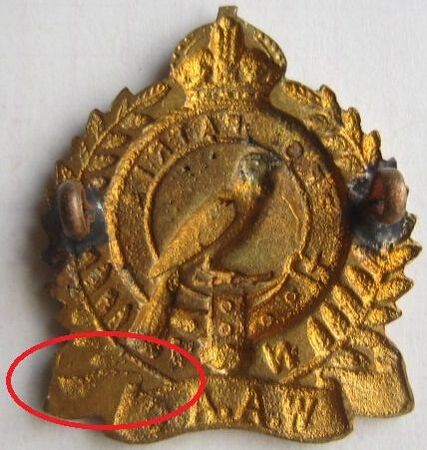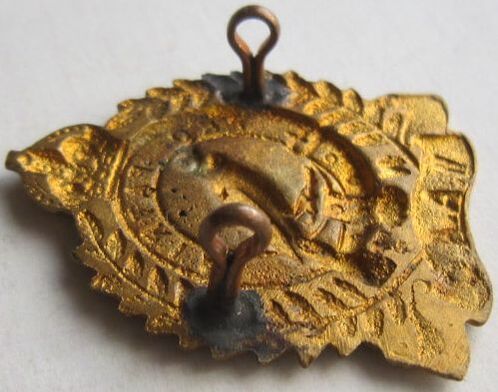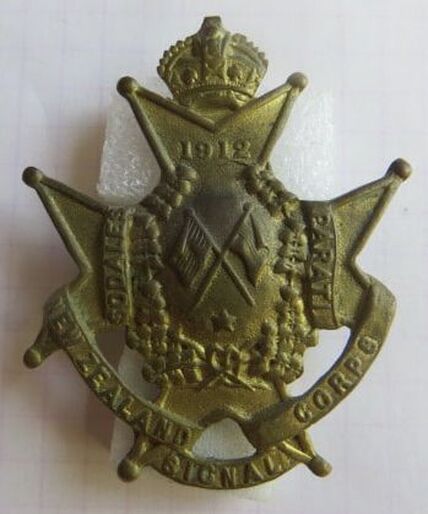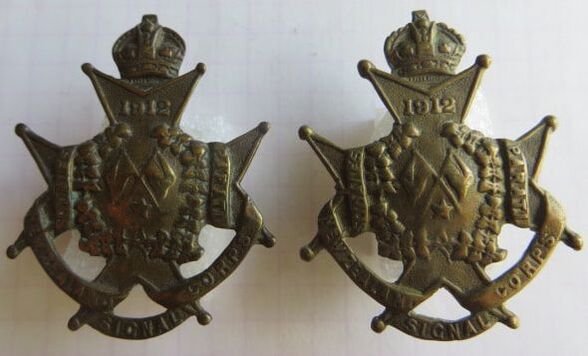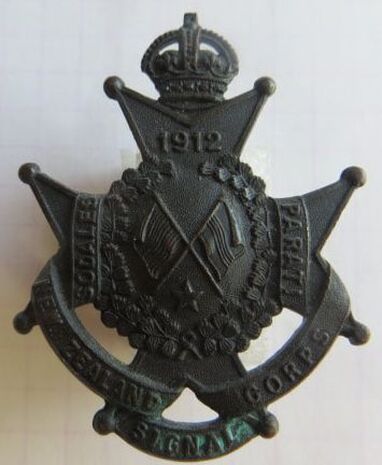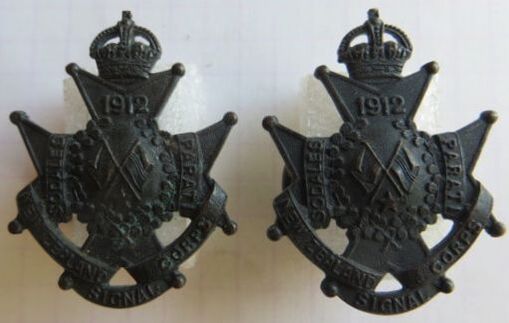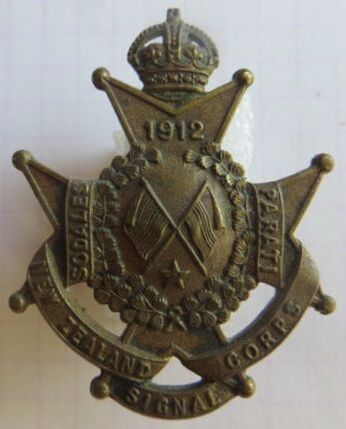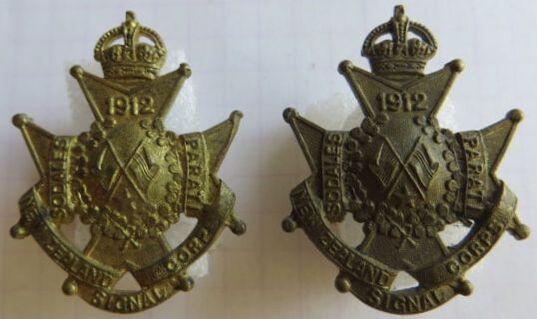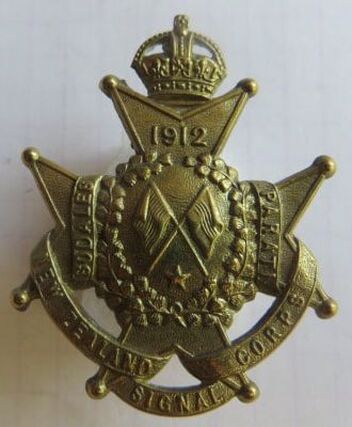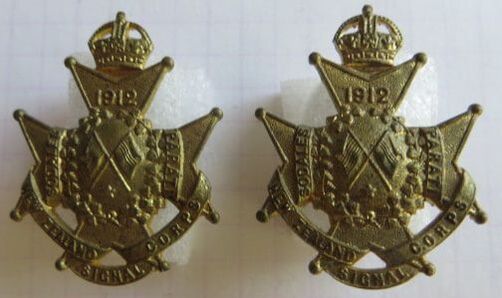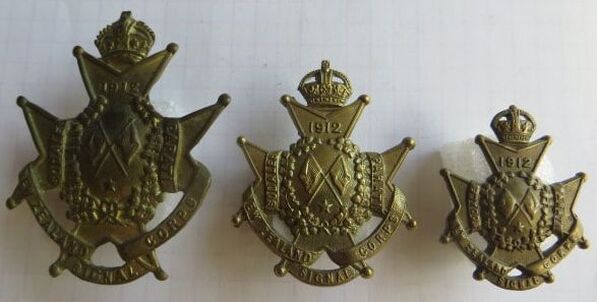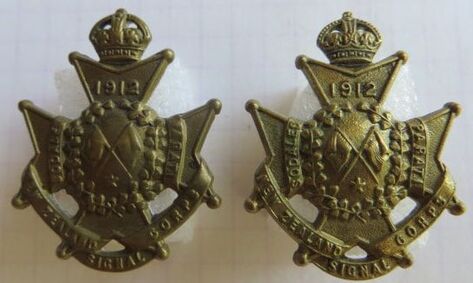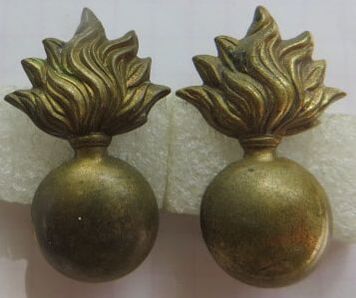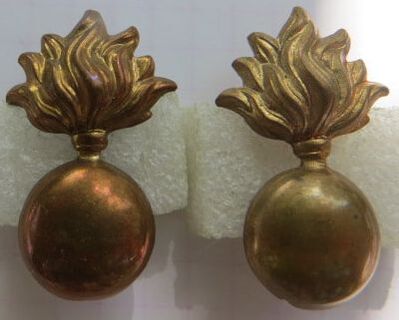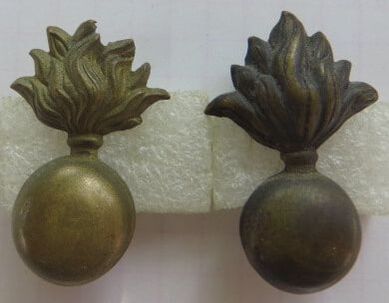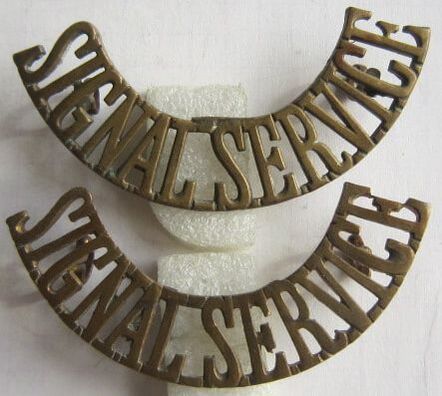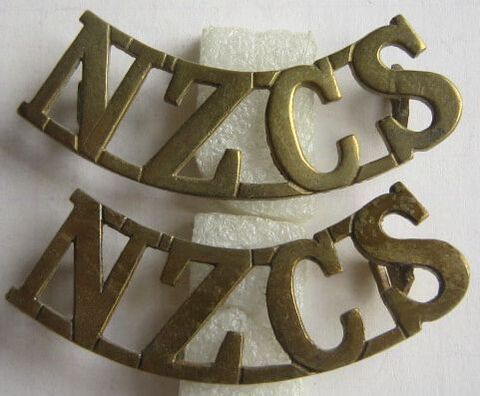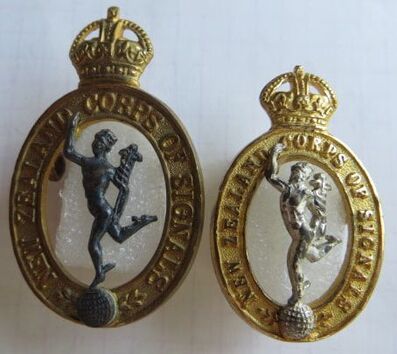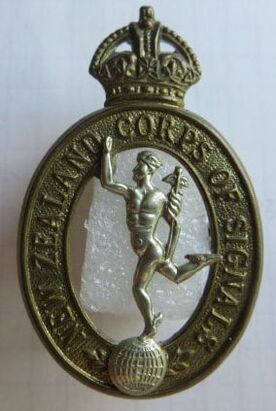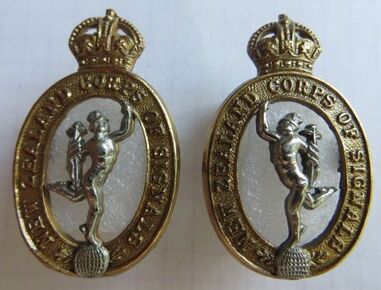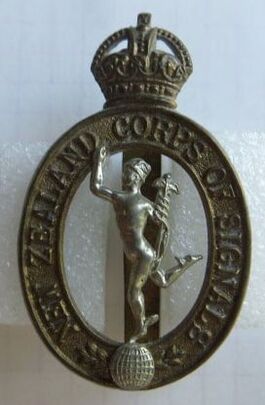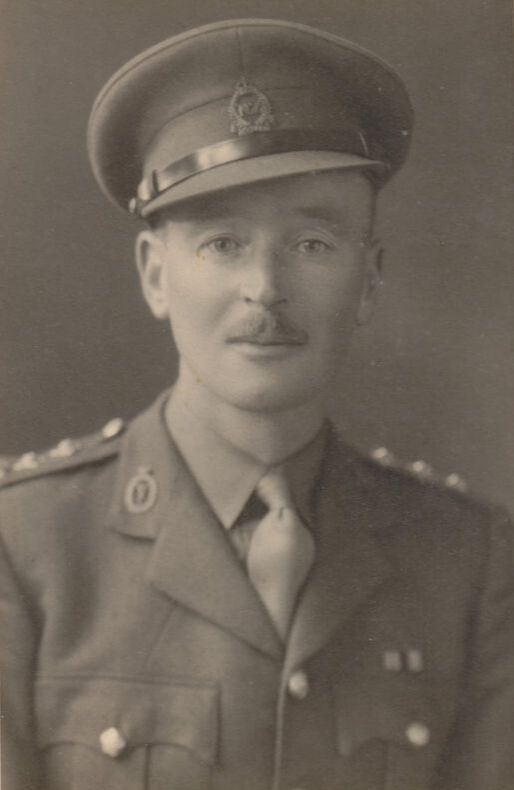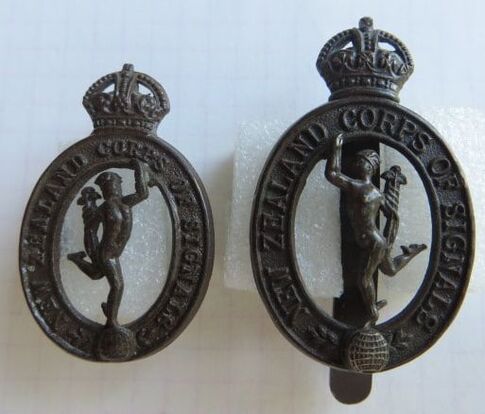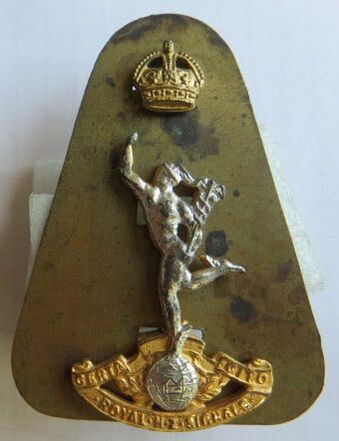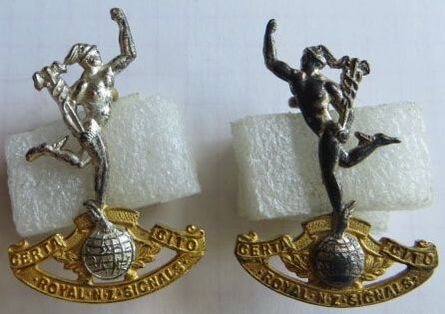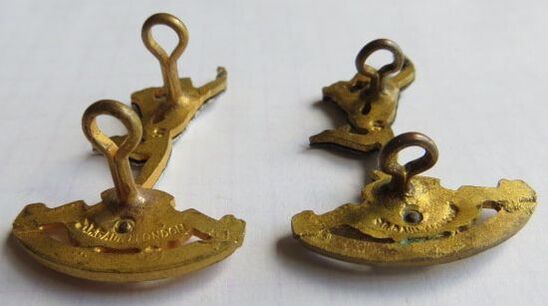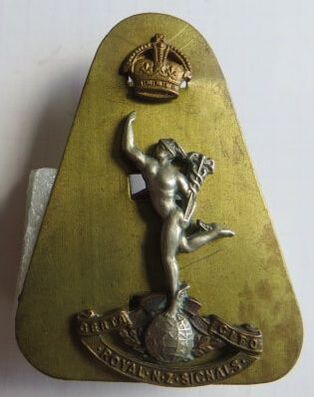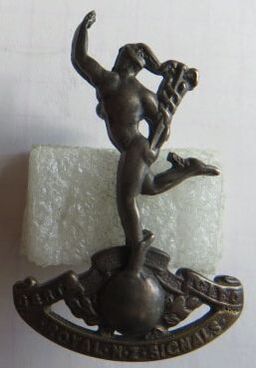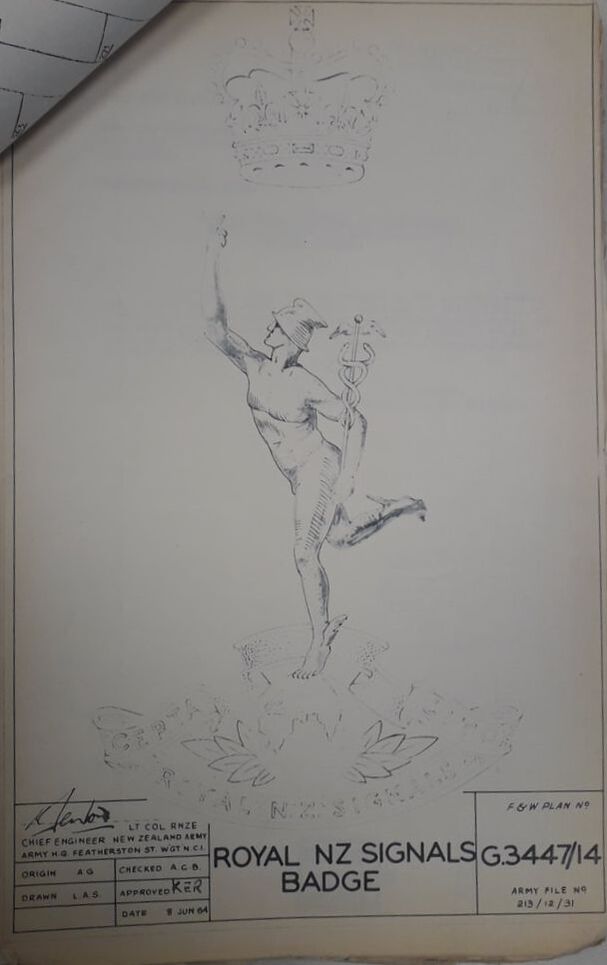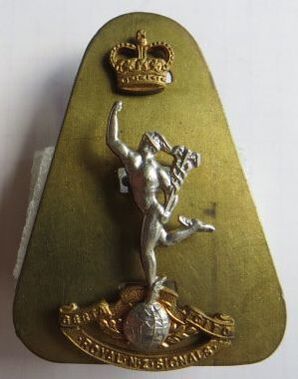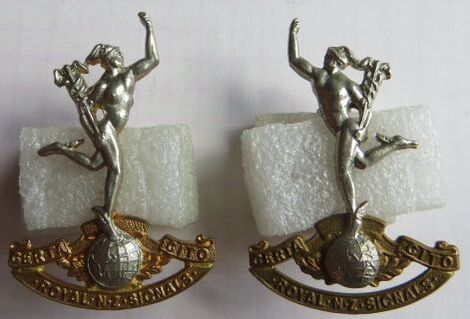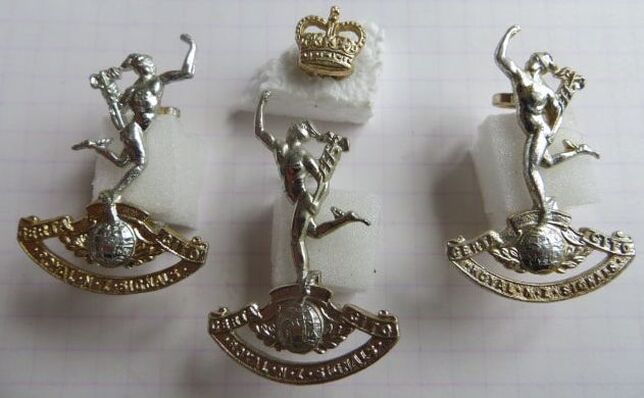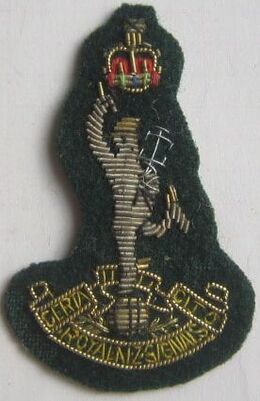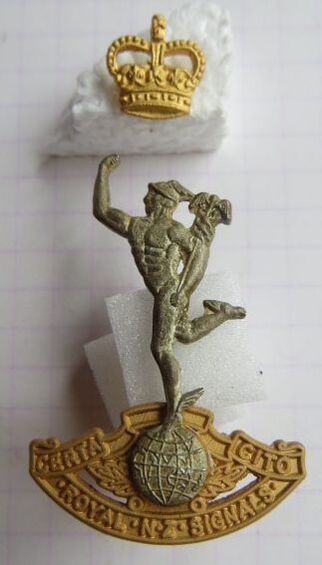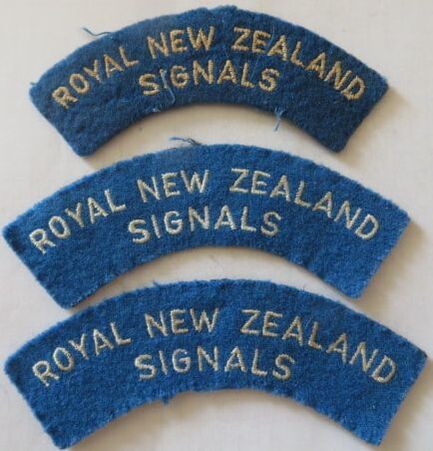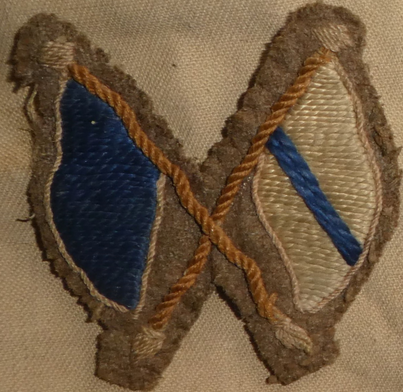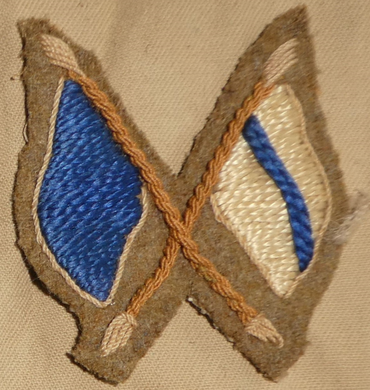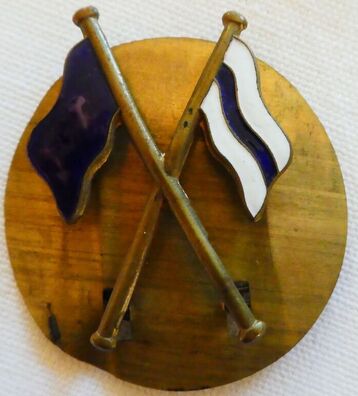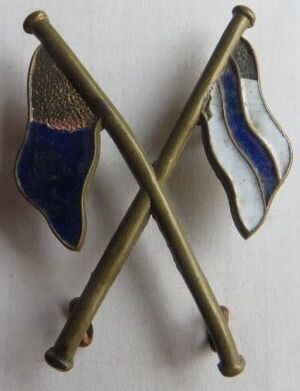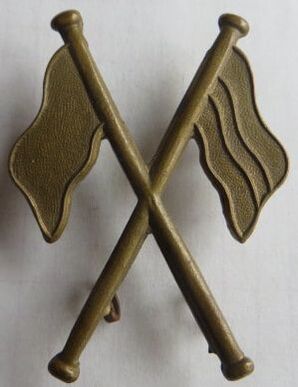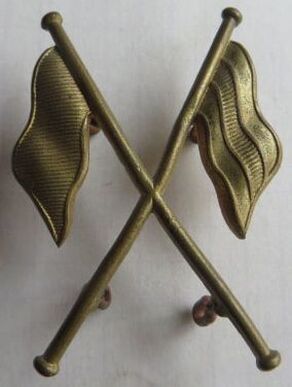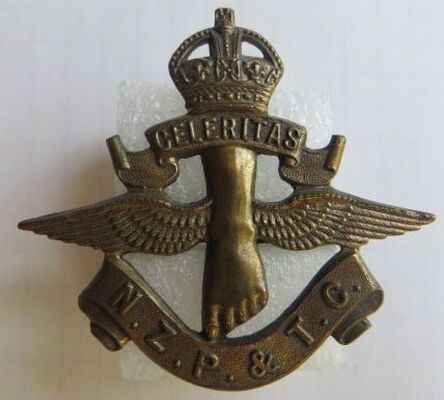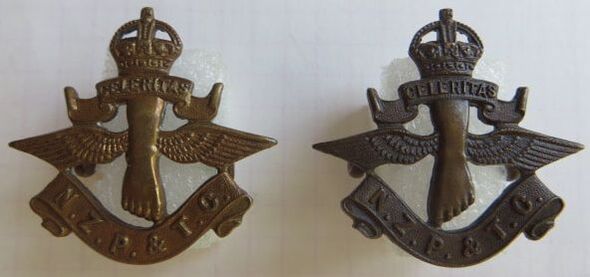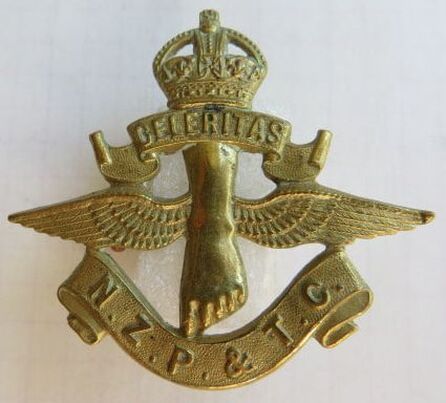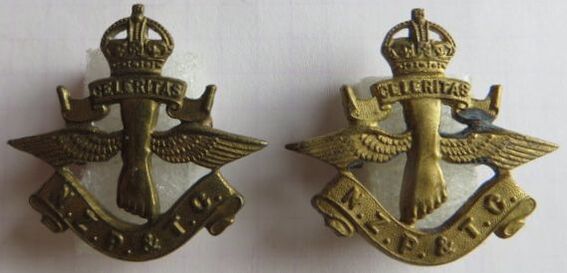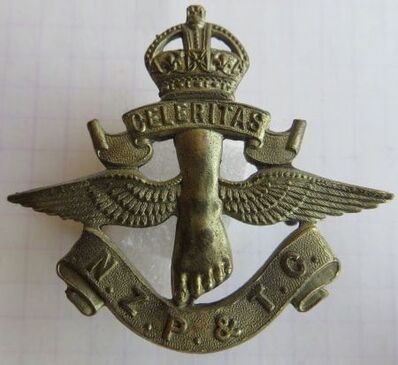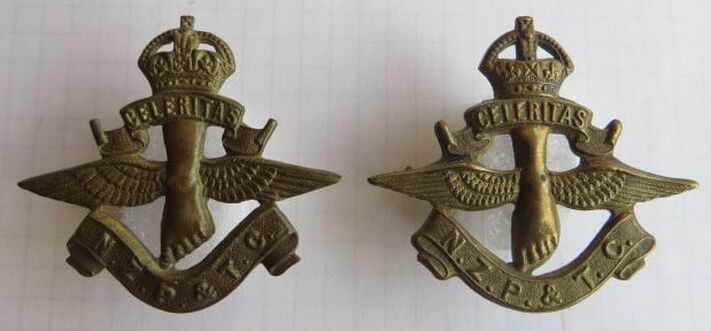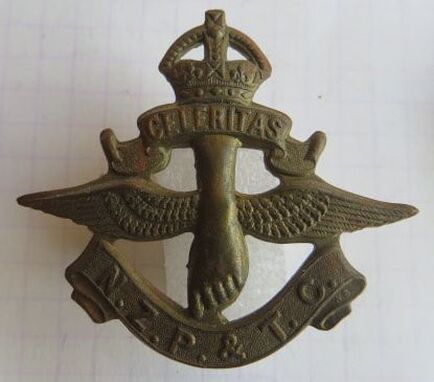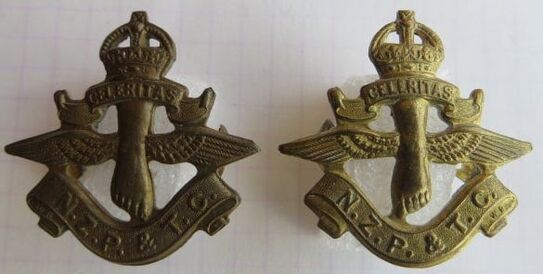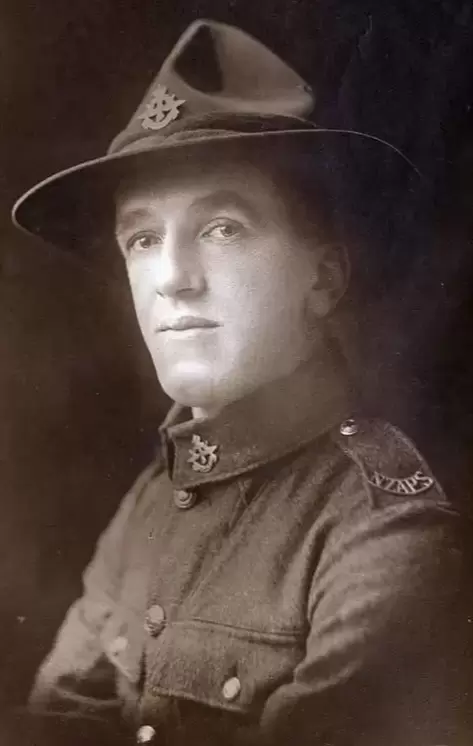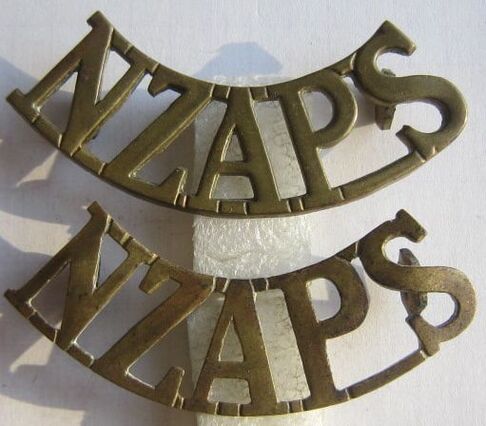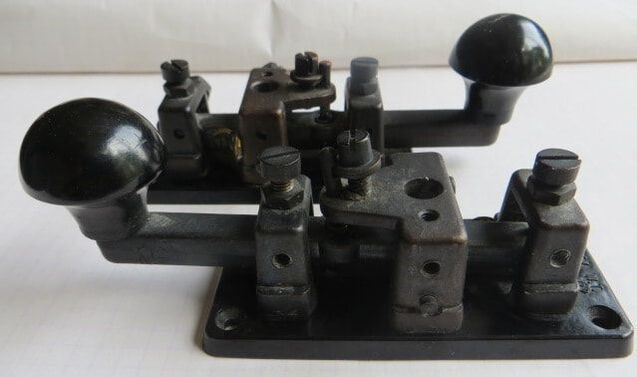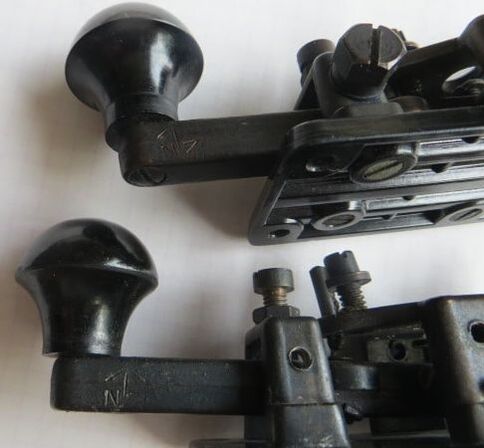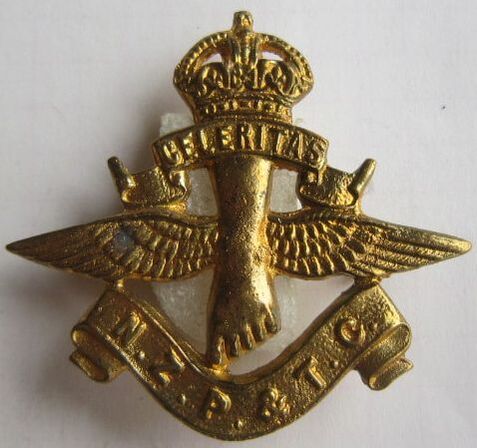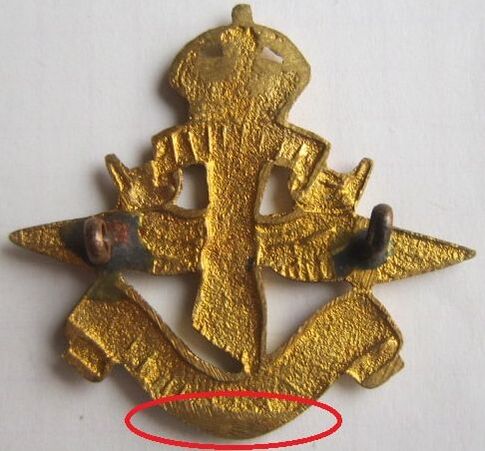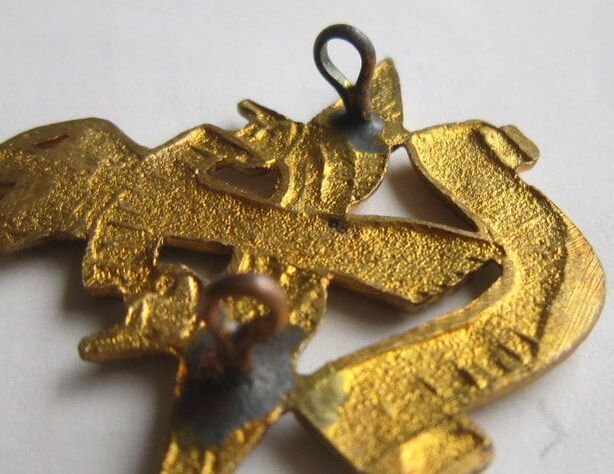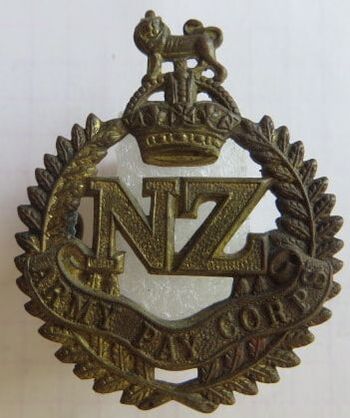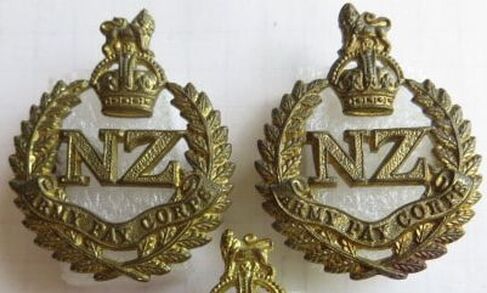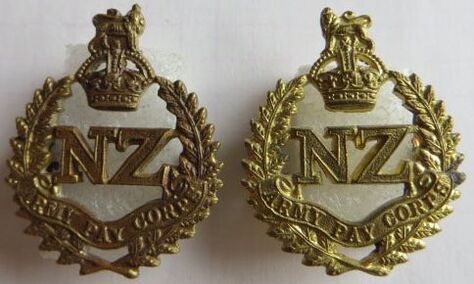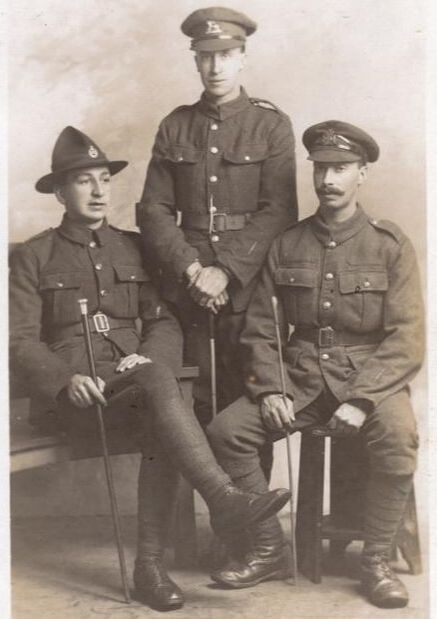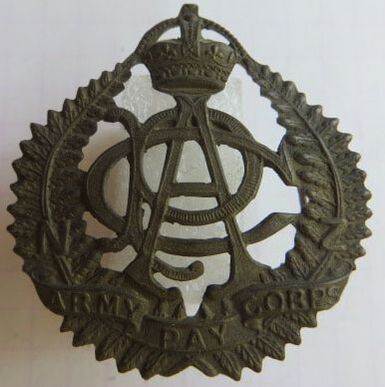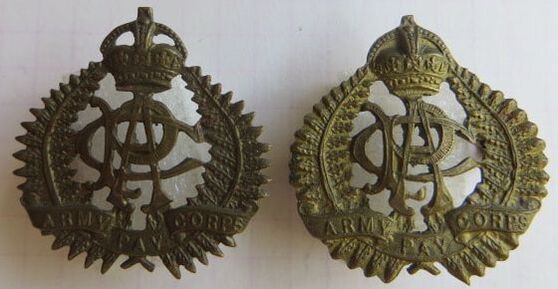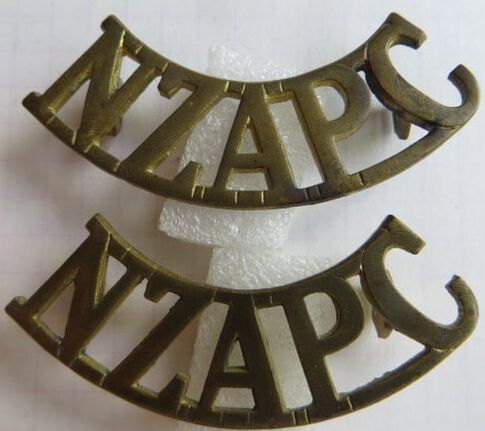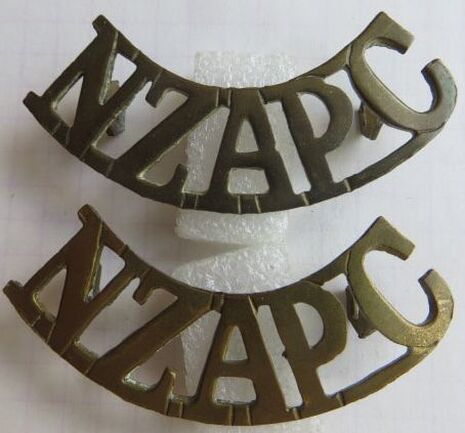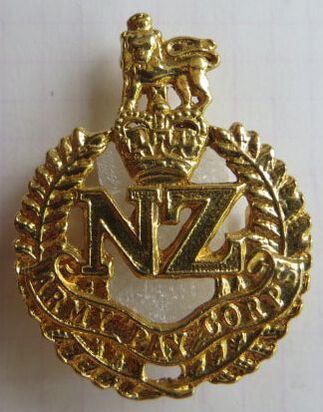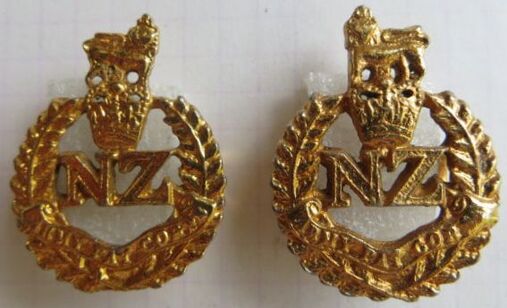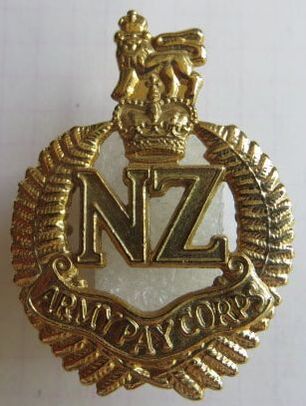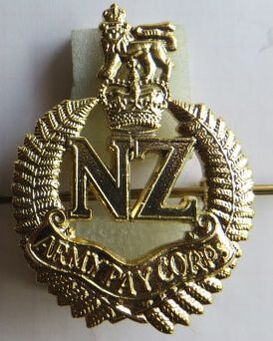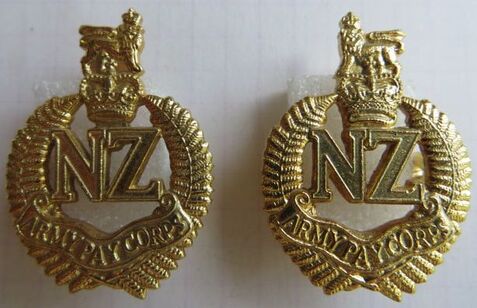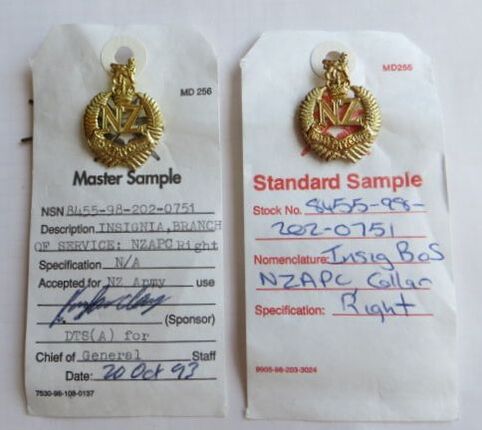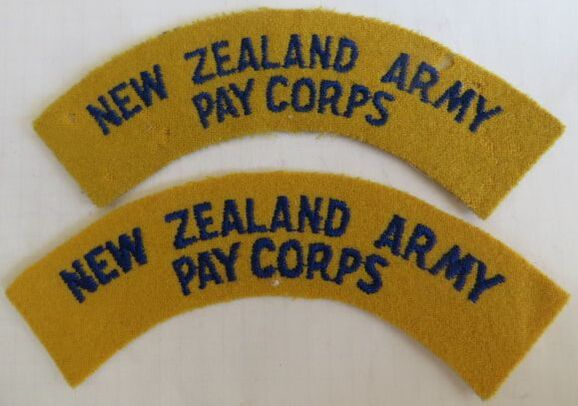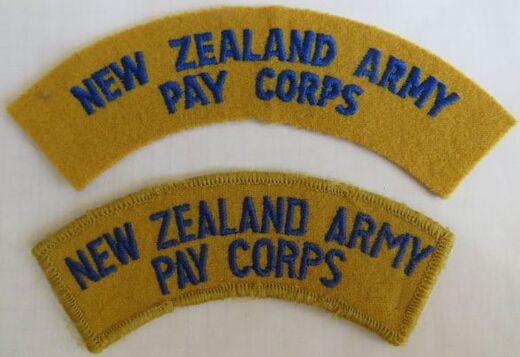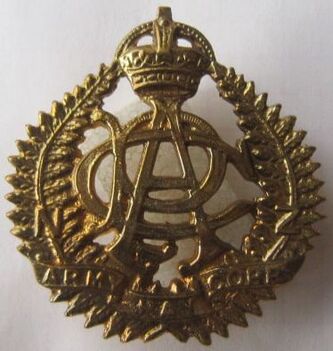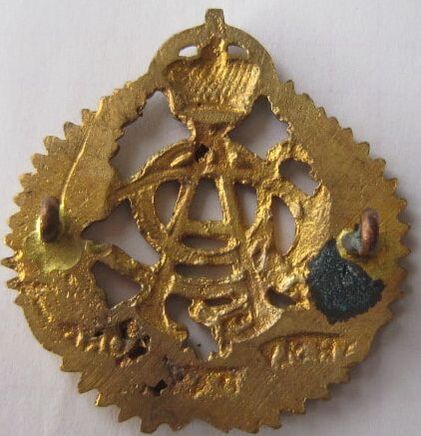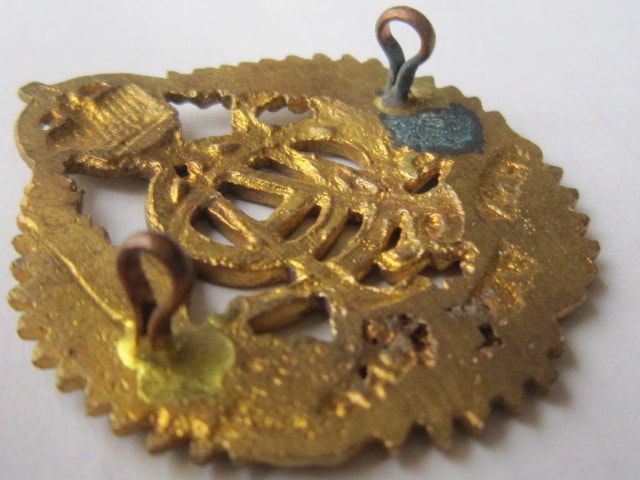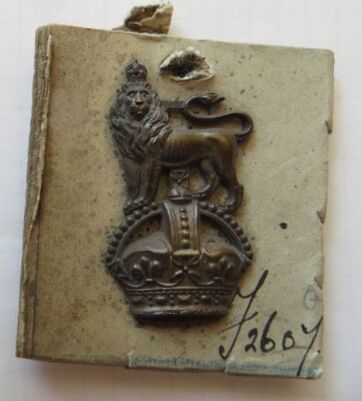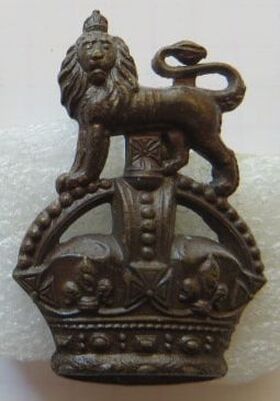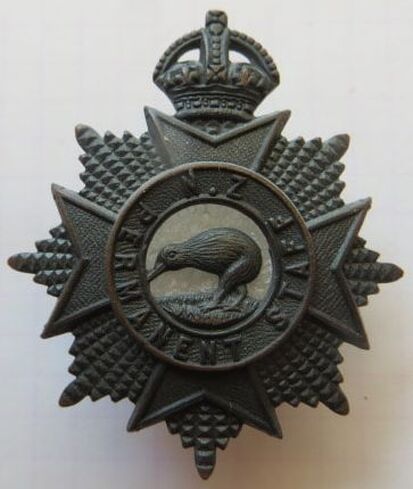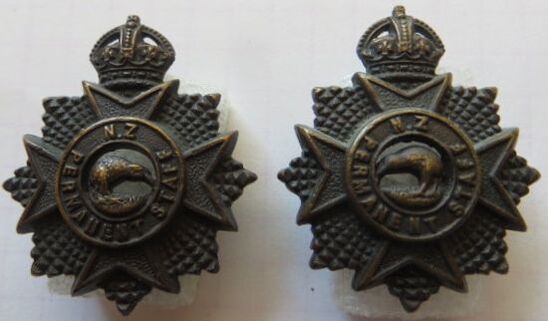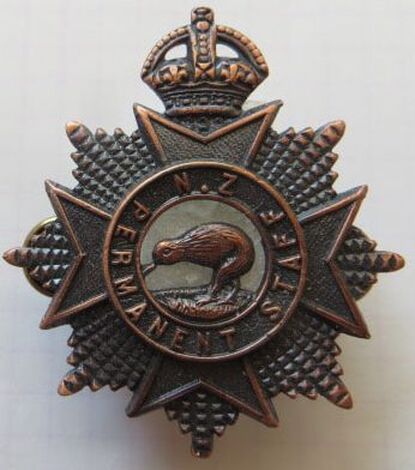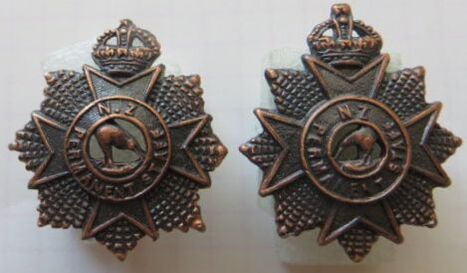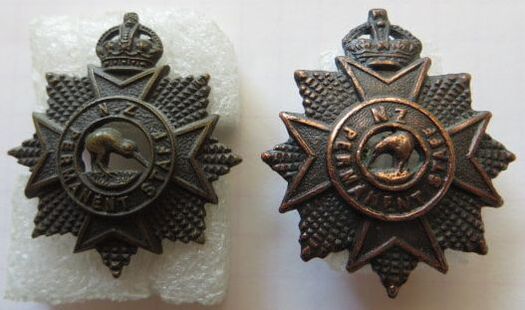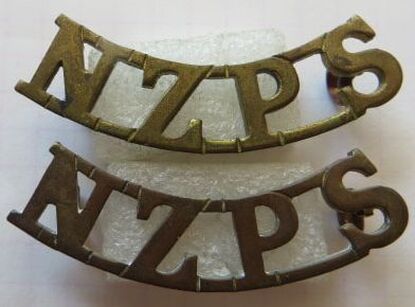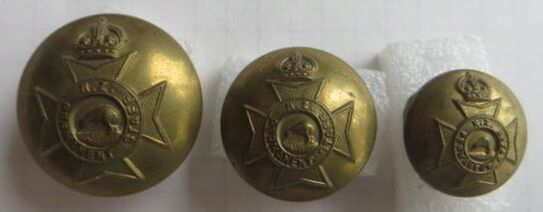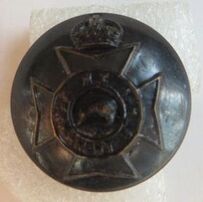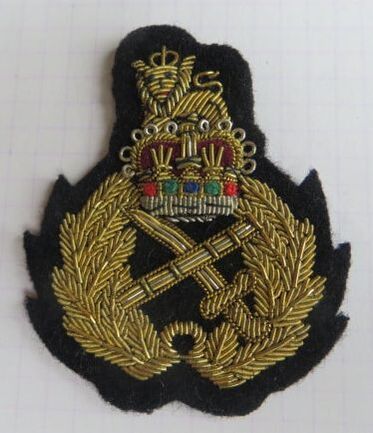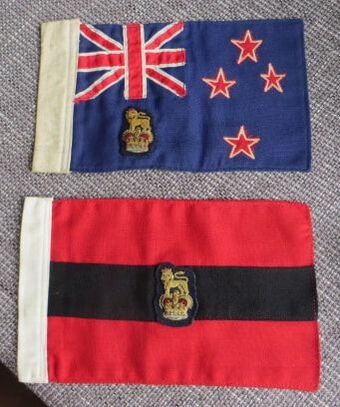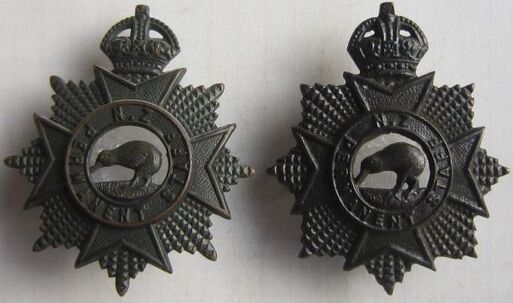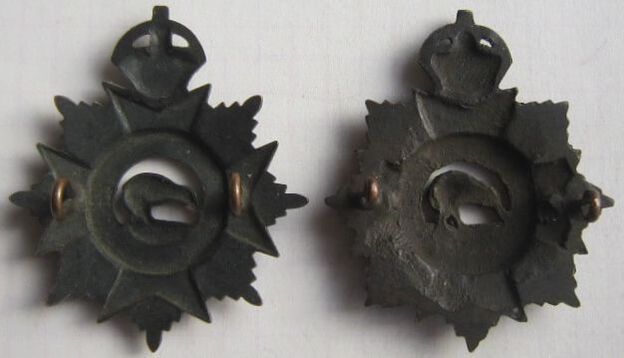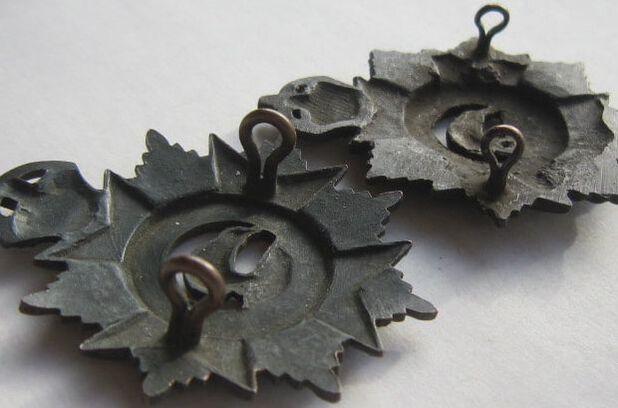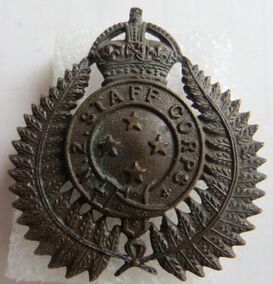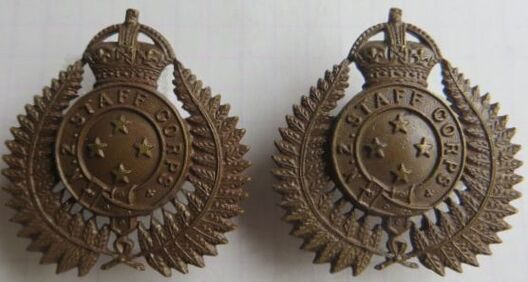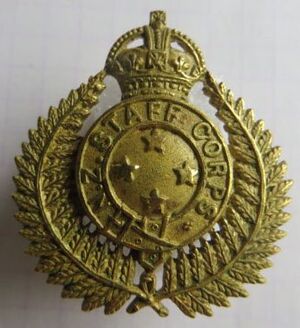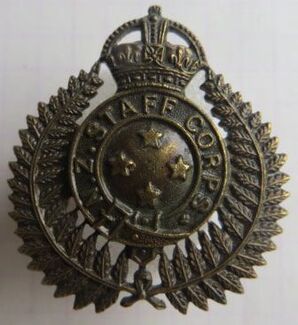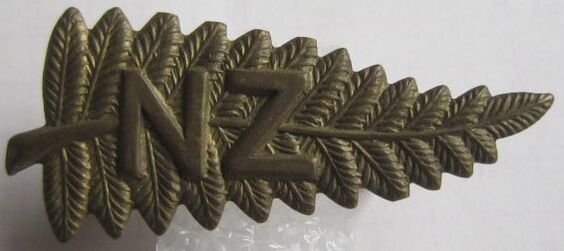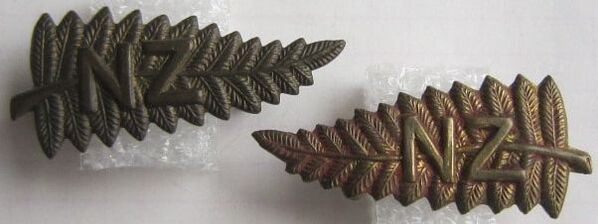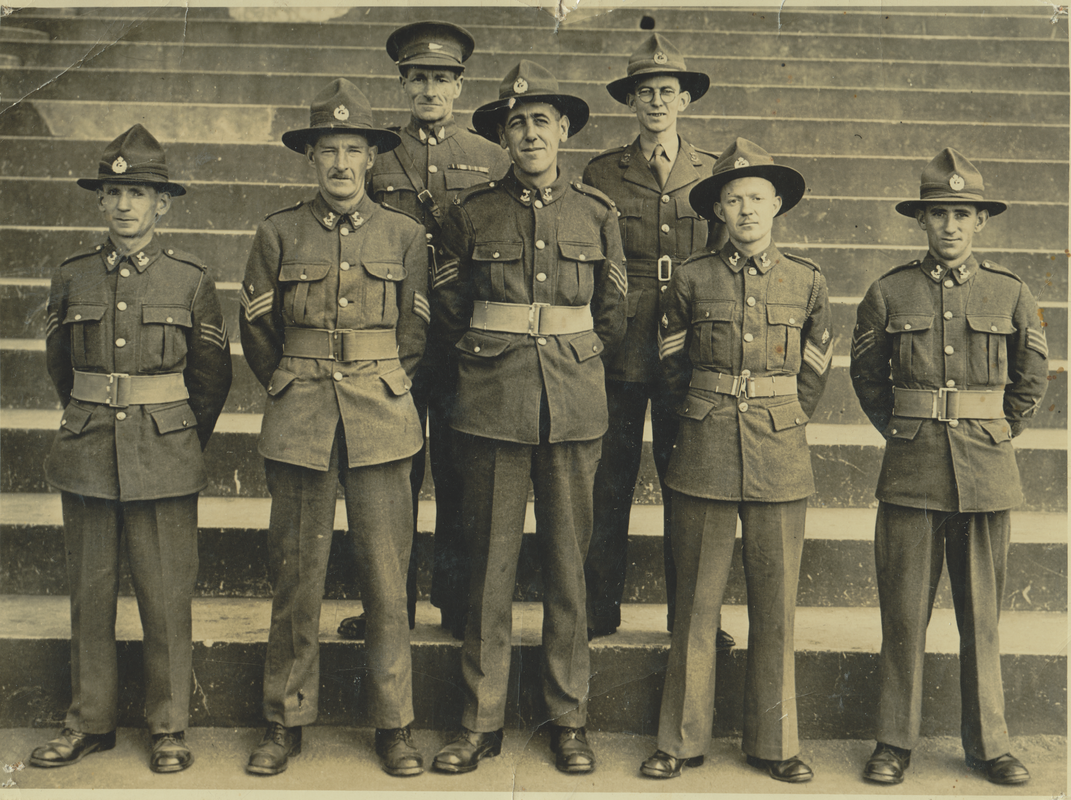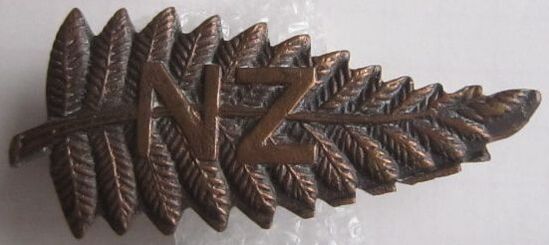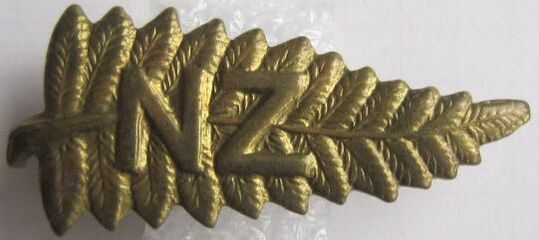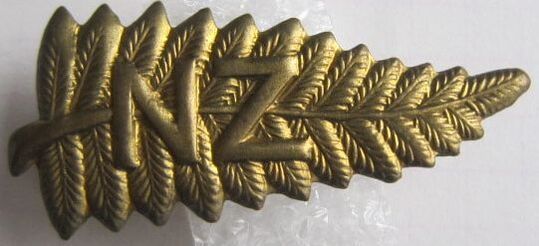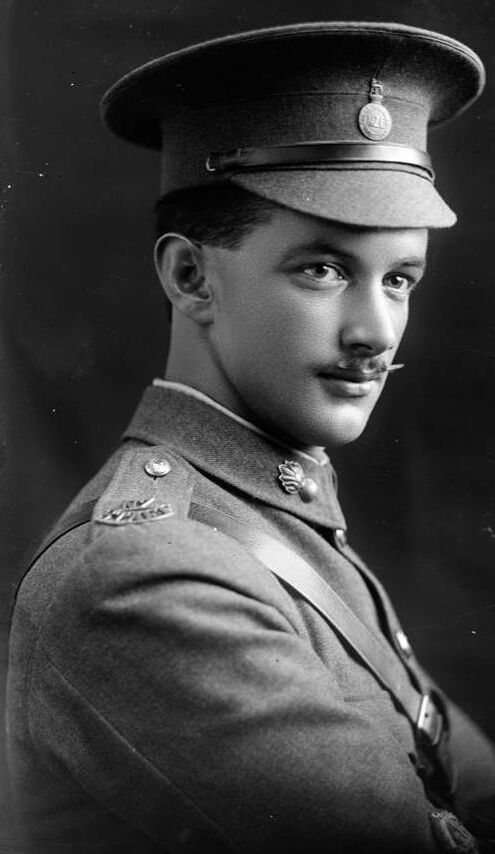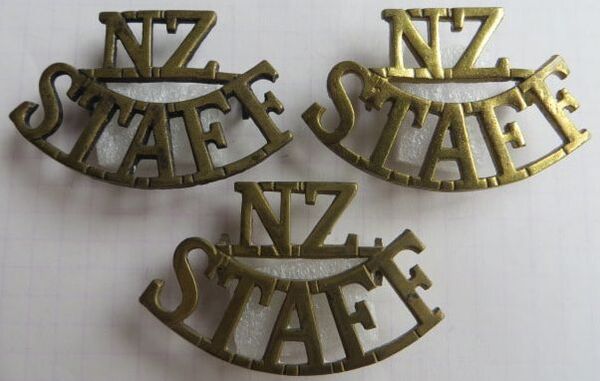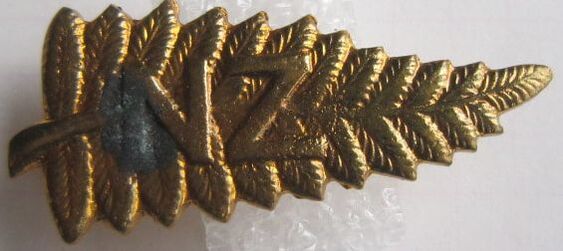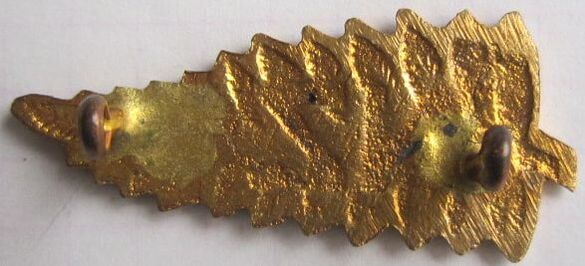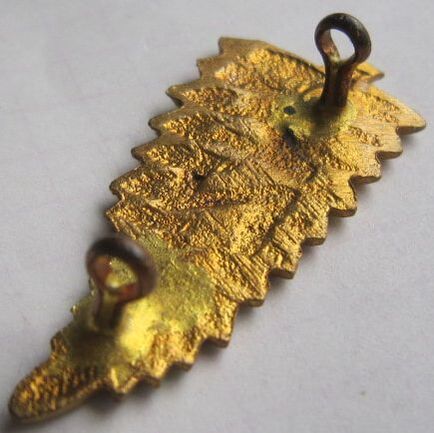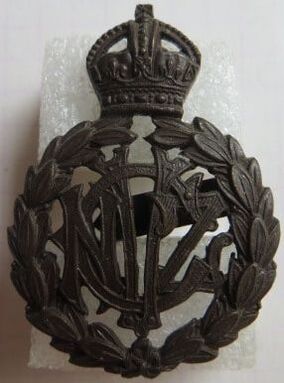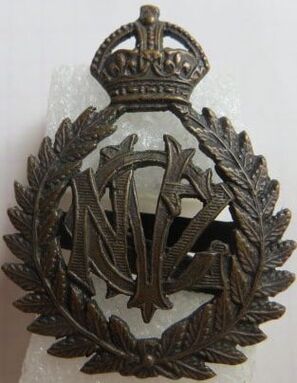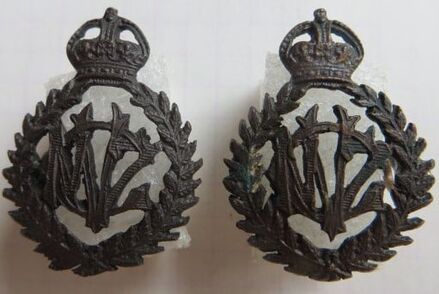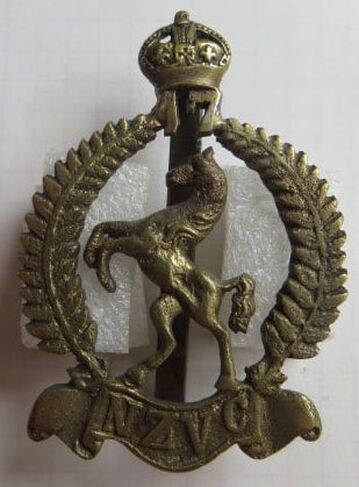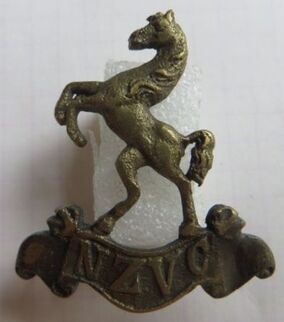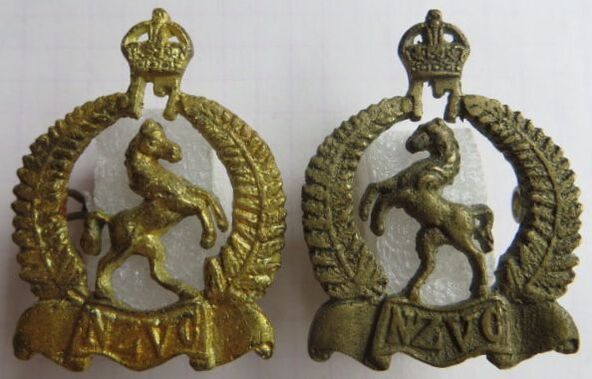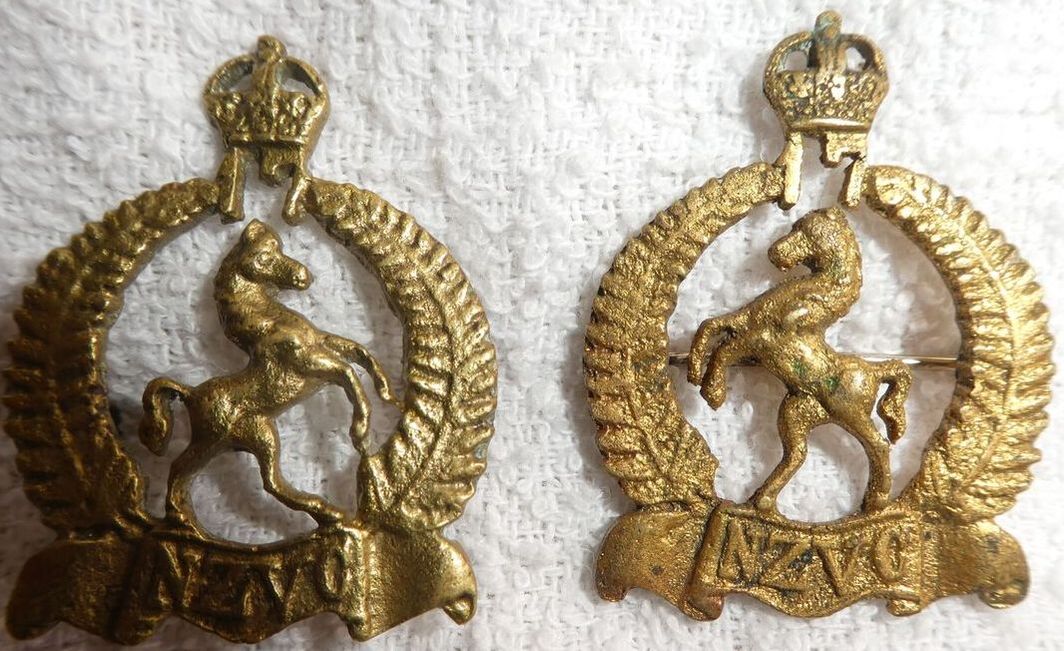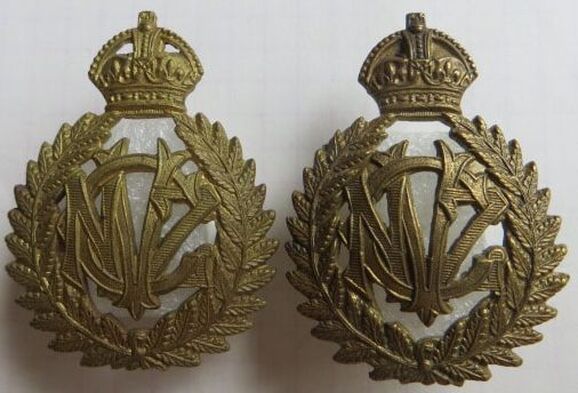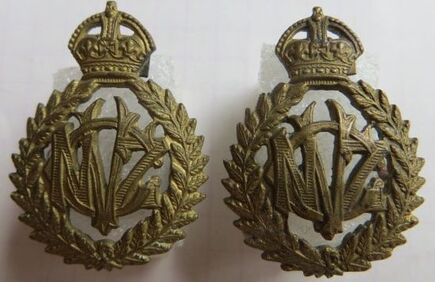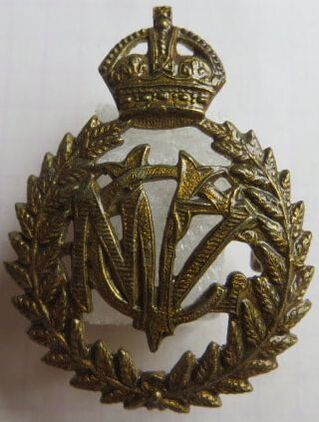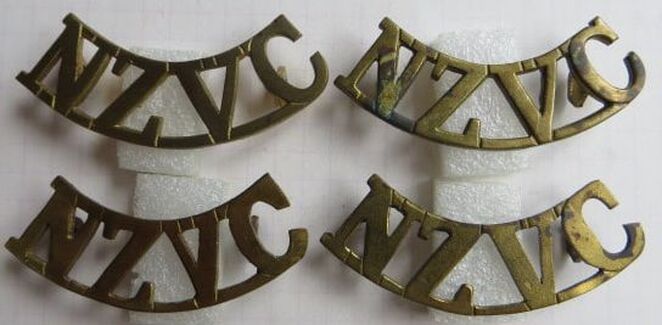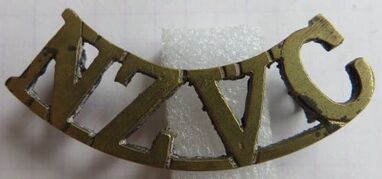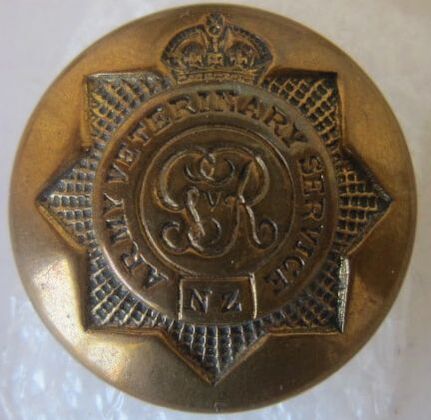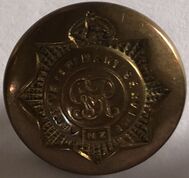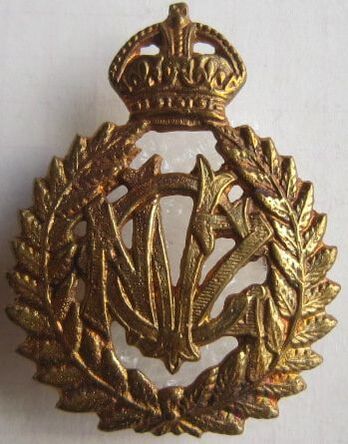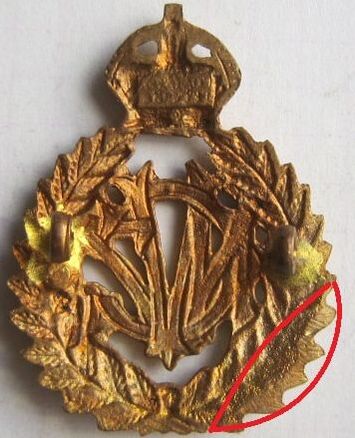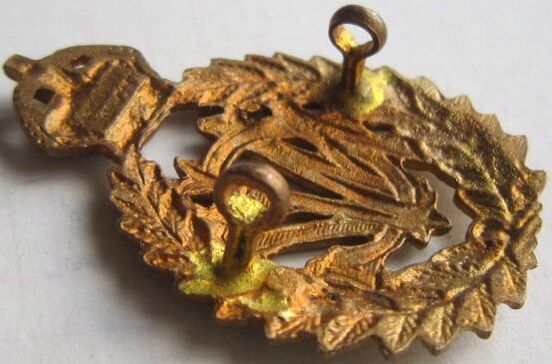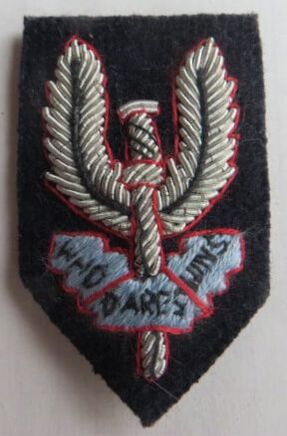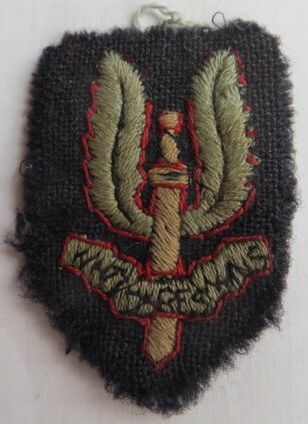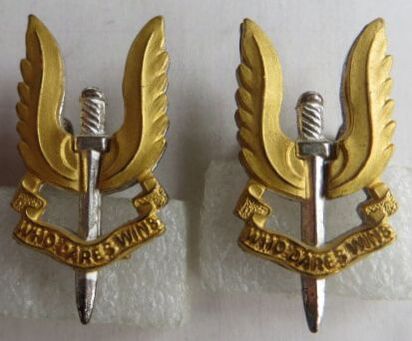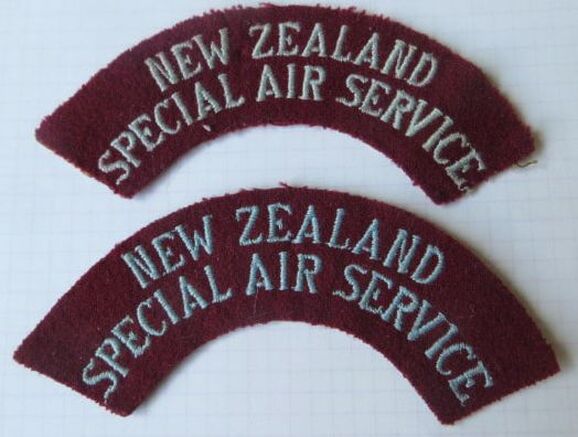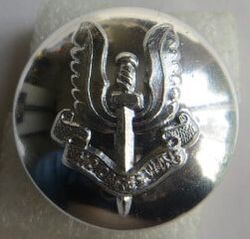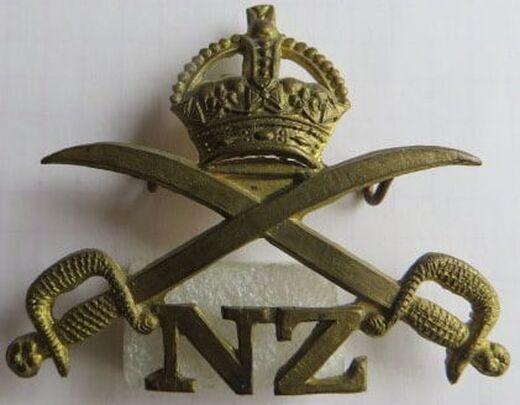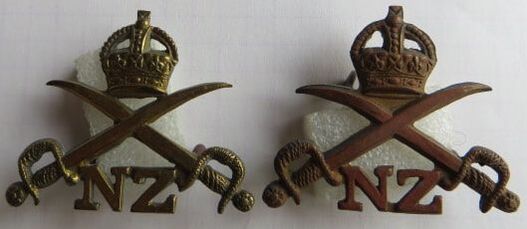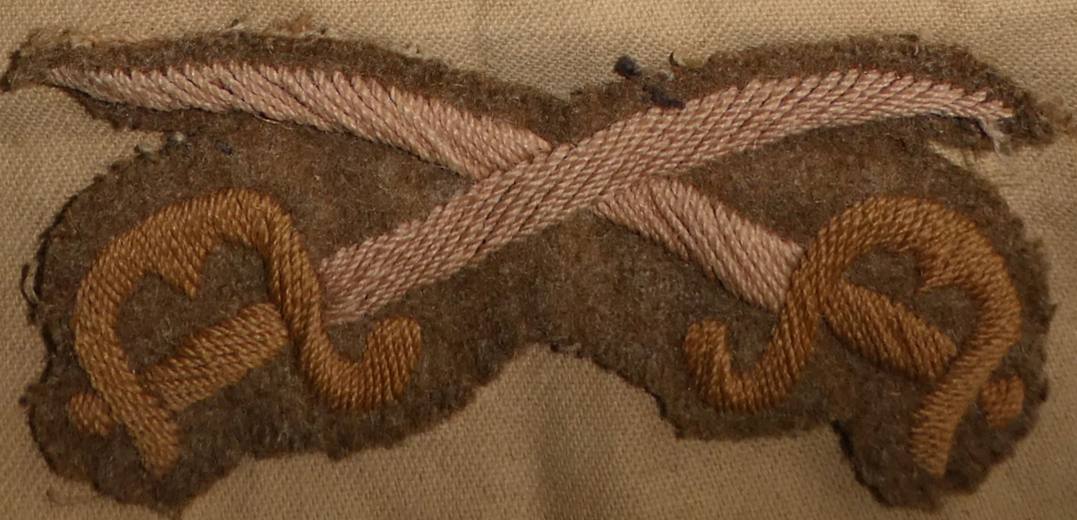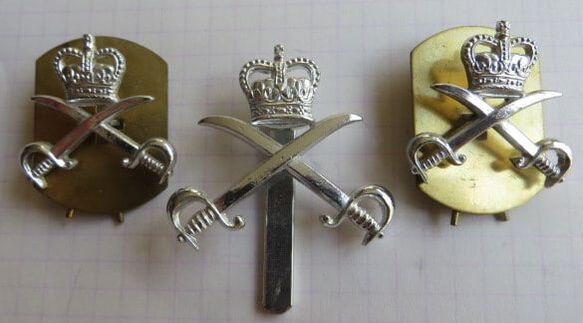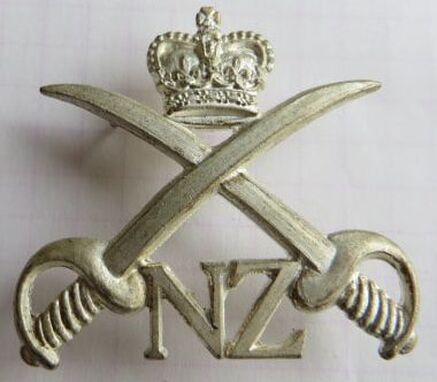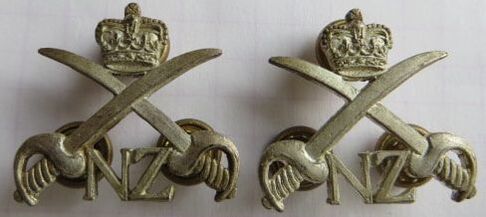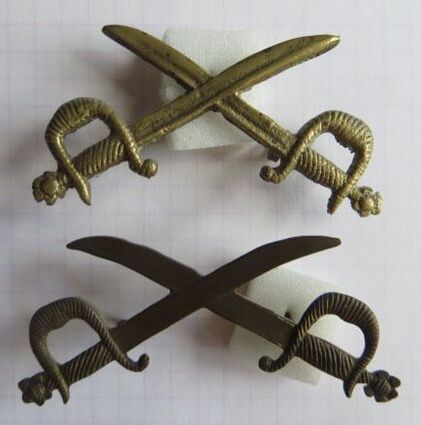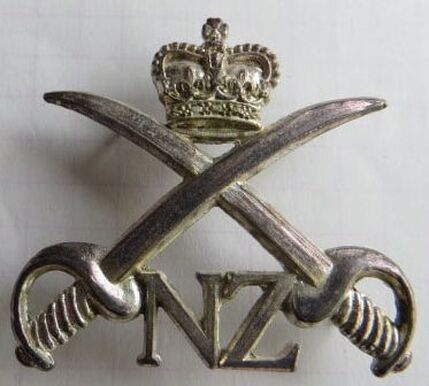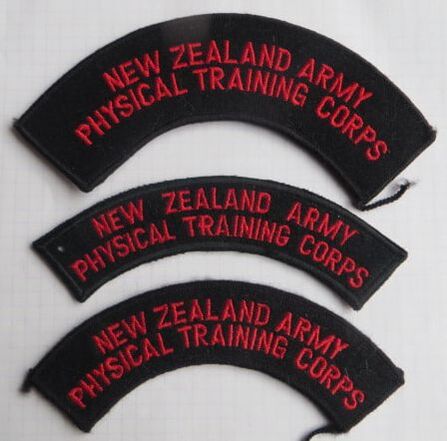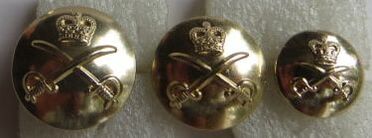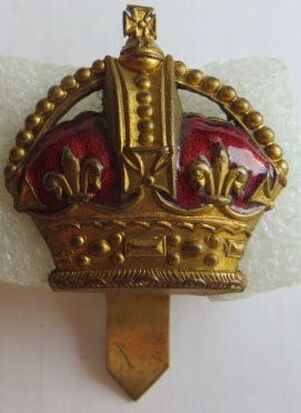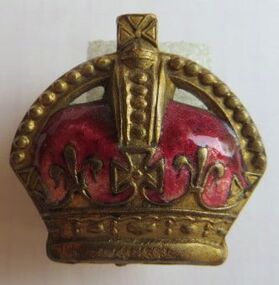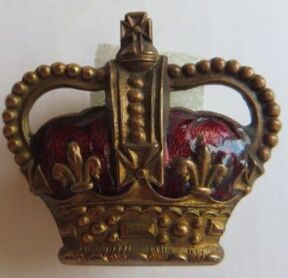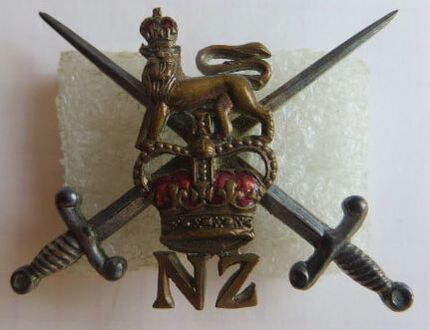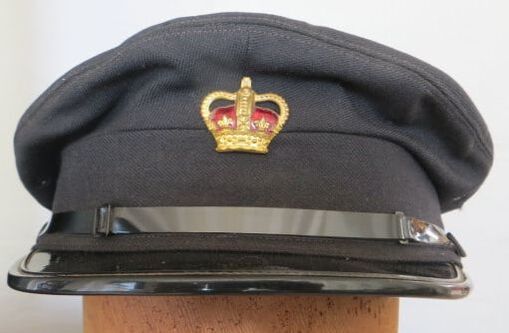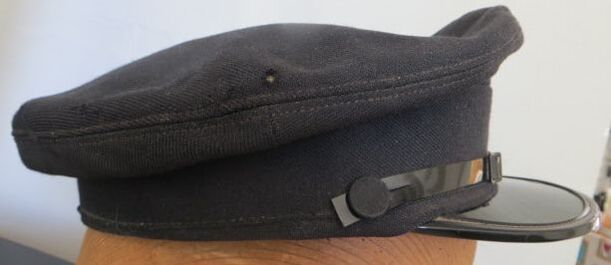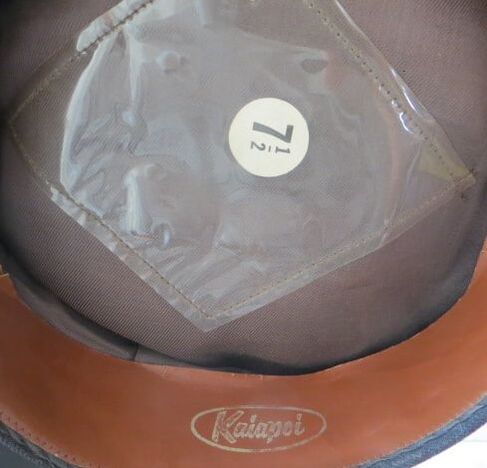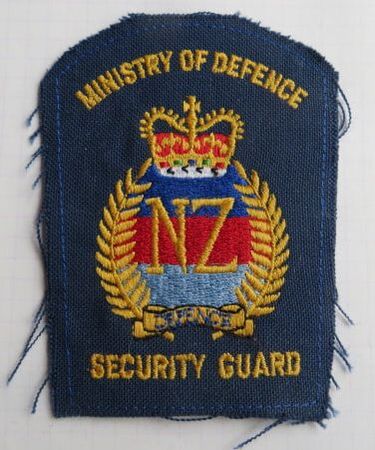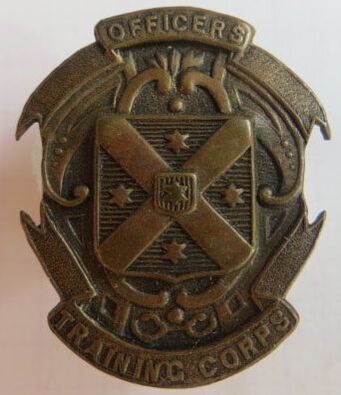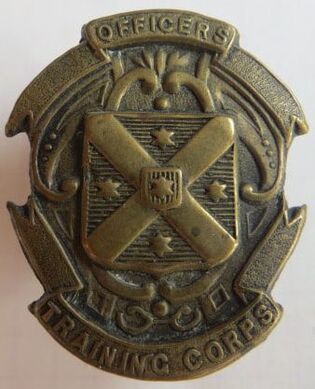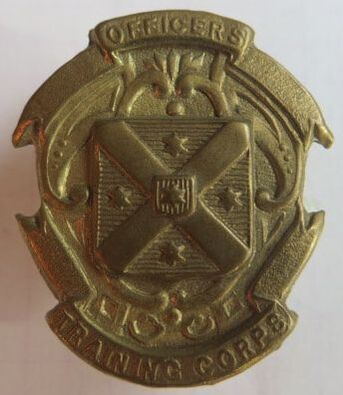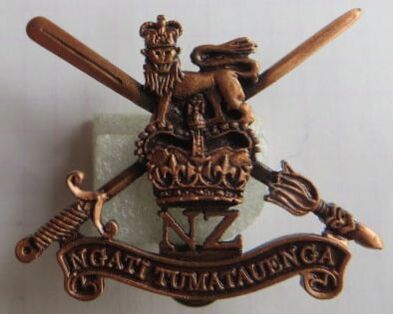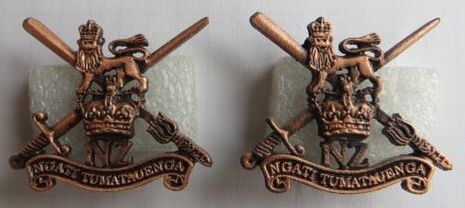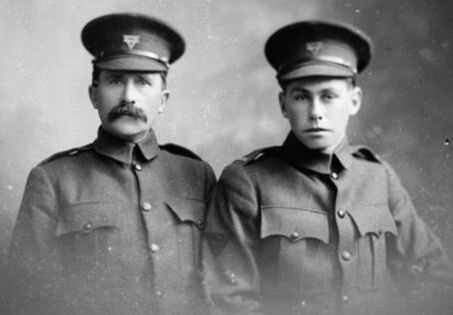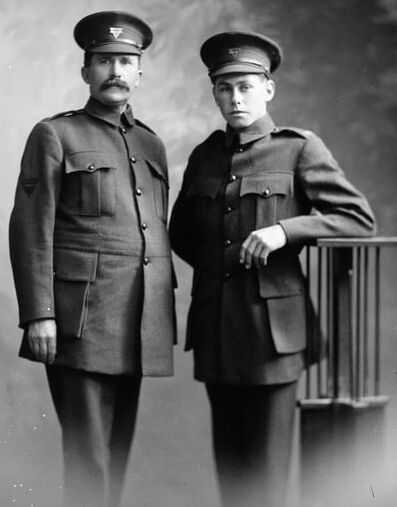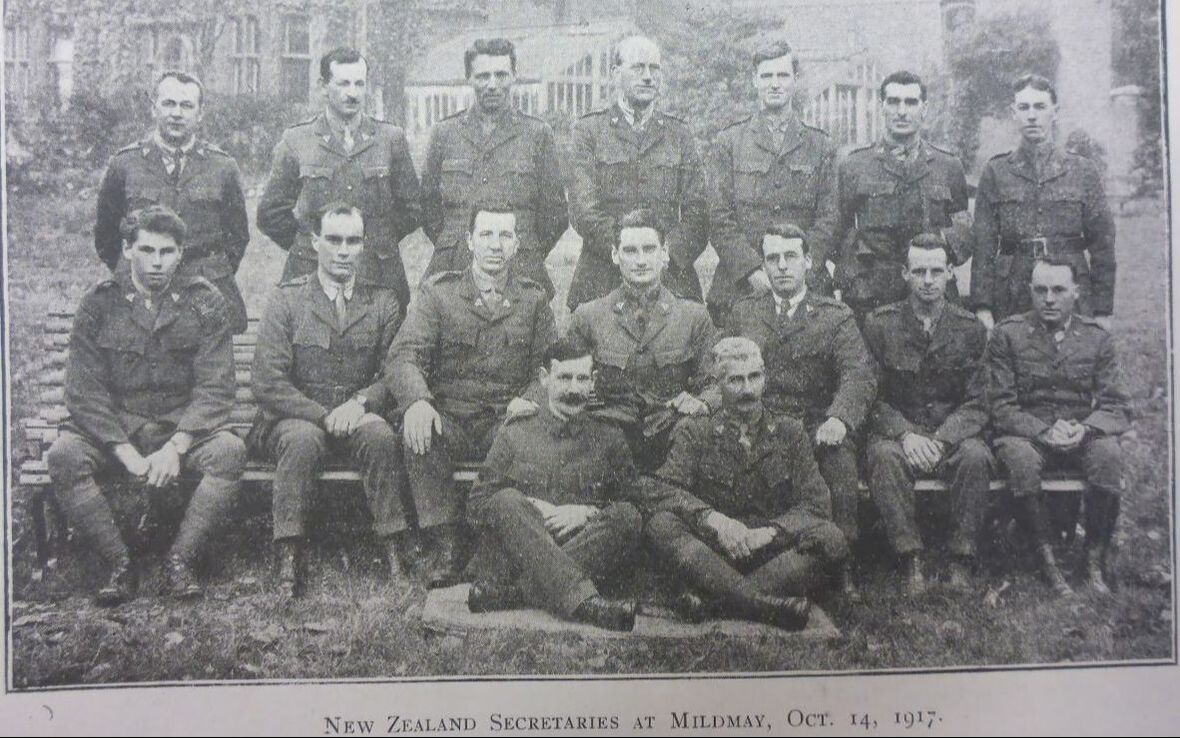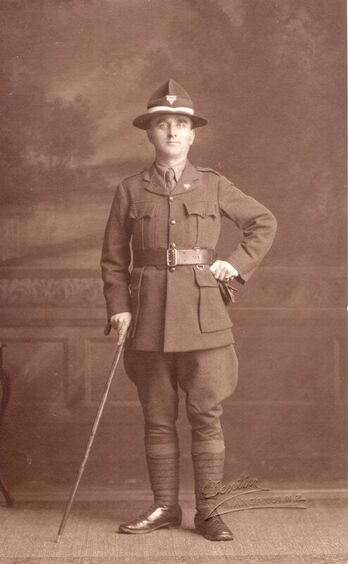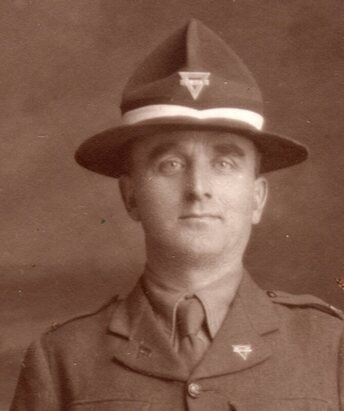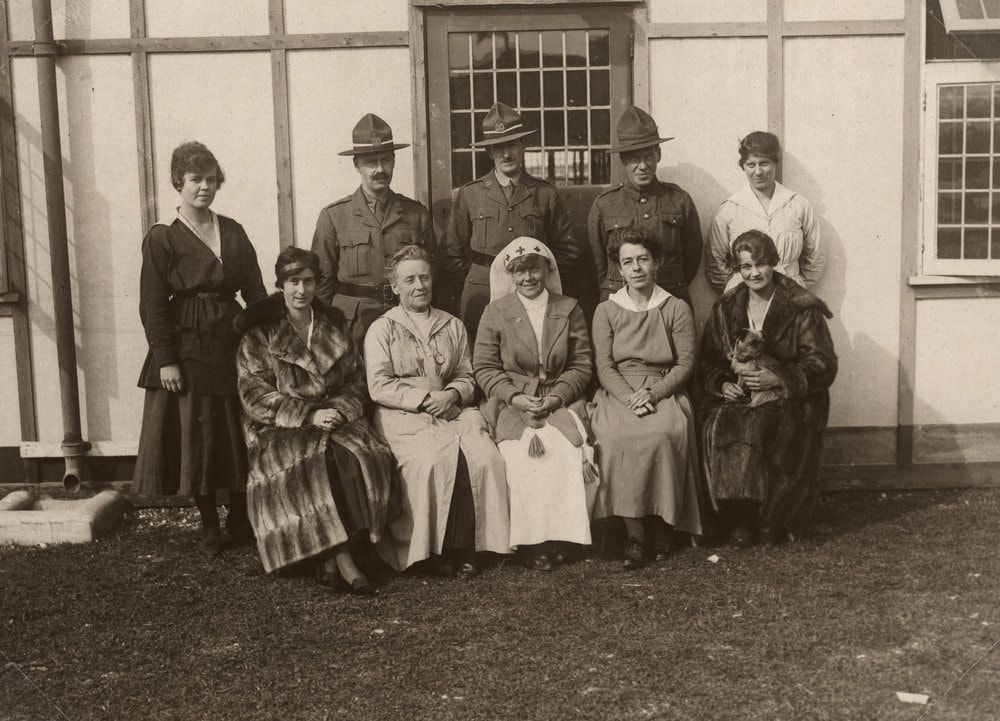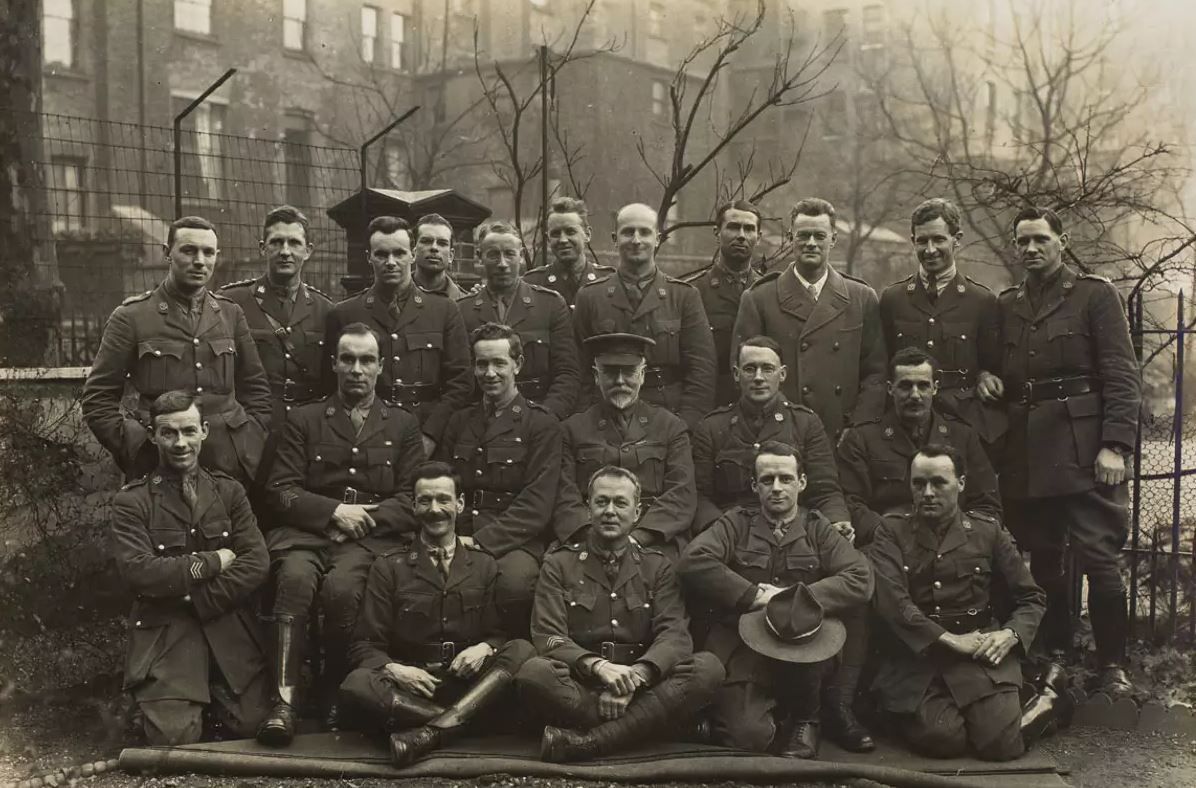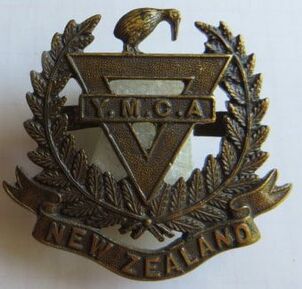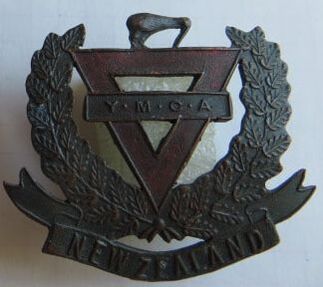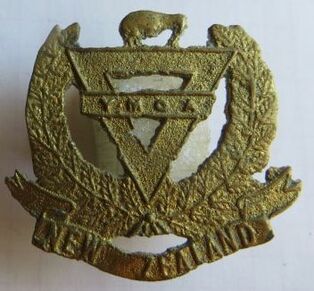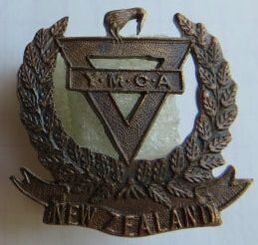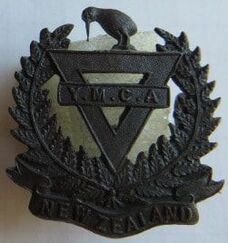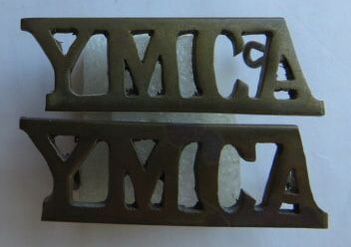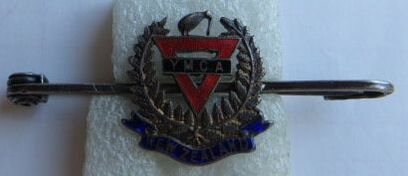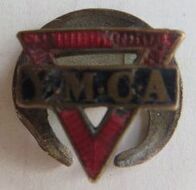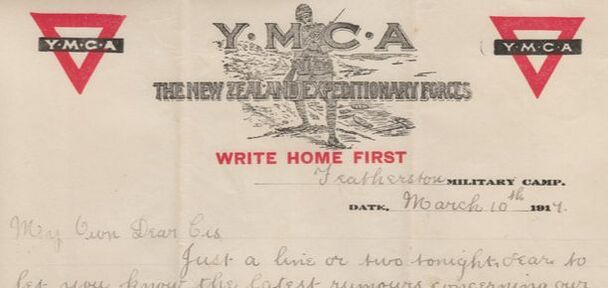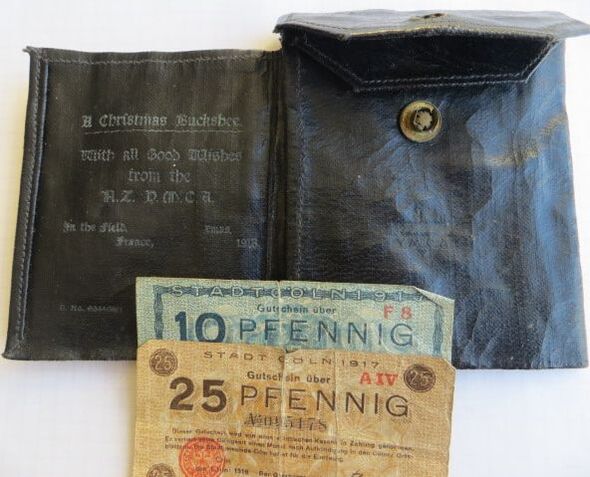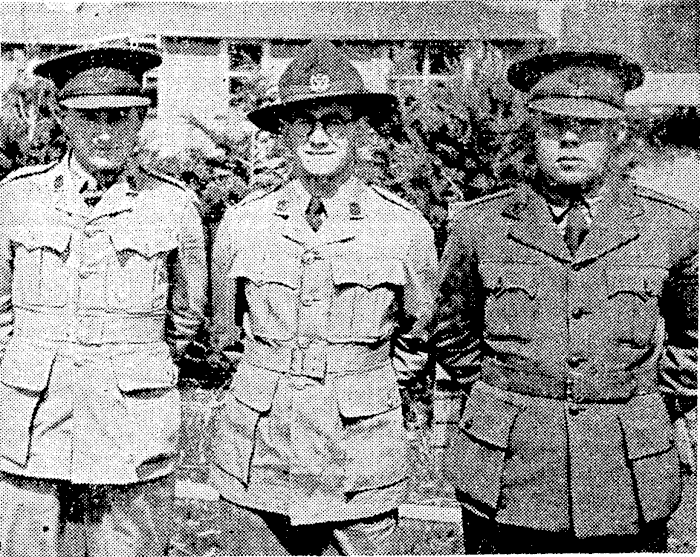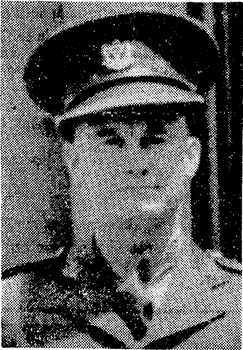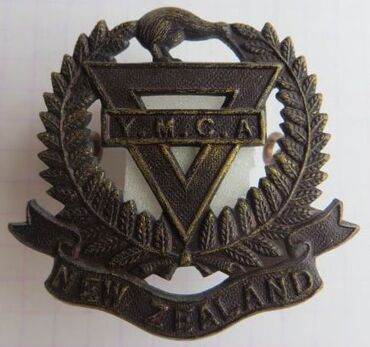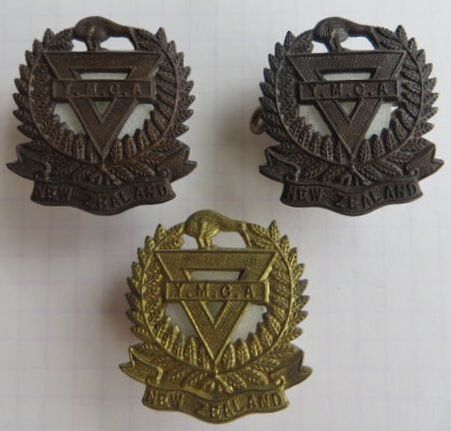New Zealand Corps 2
Royal New Zealand Army Ordnance Corps
The need for a separate New Zealand Ordnance organisation was identified as far back as 1907, but tentative steps were only taken in 1913 by training individuals at Territorial Camps with the required skills.
With the outbreak of WW1, these individuals were deployed within the 1st NZEF at Ordnance Depots, and later they became the founding members of the New Zealand Army Ordnance Corps, which was established from March 1915.
At home, in New Zealand, a New Zealand Army Ordnance Department (consisting of Commissioned Officers) and the New Zealand Army Ordnance Corps (consisting of Warrant Officers, NCO's and Men) existed from early 1917.
They wore different Cap and Collar badges from their overseas serving comrades.
Motto: (none in the 1st NZEF - as noted in R17187868 AALI W3508 7291 Archives NZ)
Also SUA TELA TONANTI (To the warrior his arms).
With the outbreak of WW1, these individuals were deployed within the 1st NZEF at Ordnance Depots, and later they became the founding members of the New Zealand Army Ordnance Corps, which was established from March 1915.
At home, in New Zealand, a New Zealand Army Ordnance Department (consisting of Commissioned Officers) and the New Zealand Army Ordnance Corps (consisting of Warrant Officers, NCO's and Men) existed from early 1917.
They wore different Cap and Collar badges from their overseas serving comrades.
Motto: (none in the 1st NZEF - as noted in R17187868 AALI W3508 7291 Archives NZ)
Also SUA TELA TONANTI (To the warrior his arms).
New Zealand Army Ordnance Corps Overseas Worn Badge - 1st N.Z.E.F.
|
- Above: A early New Zealand Army Ordnance Corps Cap badge worn oversea by members of the 1st NZEF from 1917. It has a separate "NZ" brazed to top. No maker mark, but with D shaped copper looped lugs. Size 42mm by 34mm.
|
- Above: A gilt brass Cap badge to the New Zealand Army Ordnance Corps . Again a separate "NZ" brazed to top, with maker plaque of "J R GAUNT LONDON". Two round copper lugs to back and size 42mm by 34mm.
|
- Above: A cast brass Cap badge to the New Zealand Army Ordnance Corps. One piece, it has two integrated lugs cast into the back. Size 41mm by 33mm
|
|
- Above: A well worn, single piece, gilt brass Cap badge to the New Zealand Army Ordnance Corps . No maker mark, and two short looped copper lugs to back. Size 41mm by 33mm.
|
- Above: A gilt brass Cap badge to the New Zealand Army Ordnance Corps . Single piece, with two long copper wire loops. Maker marked to base banner to "M & K, W" or Mayer & Kean, Wellington. Size 41mm by 33mm.
|
- Above: A roughly made brass Cap badge to the New Zealand Army Ordnance Corps . Single piece, it lacks detail and shape. Two piece of wire have been soldered to back. No maker mark and size 41mm by 31mm.
|
|
- Above: A pair of gilt brass Collar badges to the New Zealand Army Ordnance Corps . Note they are opposing, worn with cannon facing inwards. Single piece, with maker plaque of "J R GAUNT LONDON". Two D shaped copper lugs to back and size 31mm by 26mm.
|
- Above: A single gilt brass Collar badge to the New Zealand Army Ordnance Corps . Two piece, with separate "NZ" to top. No maker mark and two D shaped copper lugs to back. Size 31mm by 25mm.
|
- Above: A pair of darkened/bronzed Collar badges to the New Zealand Army Ordnance Corps . Two piece, with separate "NZ" to top. No maker mark and with two D shaped copper lugs to back Size 31mm by 26mm.
|
New Zealand Army Ordnance Department - Officers - New Zealand Only.
|
- Above: A scarce, 1917 pattern, New Zealand worn only, Officers Cap badge to the New Zealand Army Ordnance Department. Its maker mark to "C M Bay" and has two wire looped lugs to back. Size 38mm by 43mm.
|
- Above: A similar Cap badge in copper to the New Zealand Army Ordnance Department. No maker, with two hex type copper lugs to back. This badge is thinly struck. Size 38mm by 42mm.
|
- Above: A Officers Cap and Collar badge set to the New Zealand Army Ordnance Department (Ian Hamilton Collection).
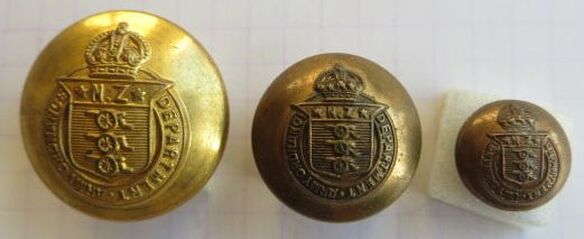
- Opposite Left: A gilt brass, fixed shank, 25mm button to the New Zealand Army Ordnance Department. It has a maker mark of "Hobson & Sons, London".
- Opposite Center: A gilt brass, fixed shank, 18mm button to the New Zealand Army Ordnance Department. It has a maker mark of "Extra Superb".
- Opposite Right: A gilt brass, fixed shank 12mm hat button to the New Zealand Army Ordnance Department. No maker mark to back.
Other Size & Maker marks (B Jones Collection): 20mm "EXTRA SUPERIOR"
- Opposite Center: A gilt brass, fixed shank, 18mm button to the New Zealand Army Ordnance Department. It has a maker mark of "Extra Superb".
- Opposite Right: A gilt brass, fixed shank 12mm hat button to the New Zealand Army Ordnance Department. No maker mark to back.
Other Size & Maker marks (B Jones Collection): 20mm "EXTRA SUPERIOR"
The New Zealand Army Ordnance Department was absorbed into the New Zealand Army Ordnance Corps in 1924.
New Zealand Army Ordnance Corps - Other Ranks - New Zealand Only.
- Above: A 1917 pattern, other ranks Cap and Collar badge set, manufactured, and worn in New Zealand only for home service. Two brass hex type lugs to back of each, with no maker mark. Note the collars are the same for the Officers which were part of the New Zealand Army ordnance Department. I have yet to find a distinction between the collars for the two units. Size of Cap 33mm by 35mm, size of Collar 28mm by 33mm.
- Above: A similar set again of badge to the New Zealand Army Ordnance Corps (Ian Hamilton Collection).
This other ranks, 1917 patterned badge, continued to be worn well after WW1 and until 1937 within New Zealand. In that year, it was reported that apparently all stocks of the Cap badge had been used, and permission was sort for the men to wear the overseas 1st NZEF version of the badge (top of page) until a new 1937 pattern of the badge became available.
|
- Above: A pair of locally made shoulder titles to the New Zealand Army Ordnance Corps. Thin hex type brass lugs to back. Not maker marked with size being 17mm by 57mm.
|
|
- Above Left: A 24mm, gilt brass button to the New Zealand Army Ordnance Corps. Maker marked to back to "Firmin, London".
- Above Center: A 17mm, gilt brass button to the New Zealand Army Ordnance Corps. Maker marked to back to "Firmin, London". - Above Right: A 12mm, gilt brass button to the New Zealand Army Ordnance Corps. Maker marked to back to "Firmin, London". |
- Above: A rare 1937 patt gilt brass and enamel Officers collar badge to the New Zealand Army Ordnance Corps in 1937. Note the fretting to circular banner. Two copper looped lugs to back, with the maker mark stamped to back of banner to "FIRMIN LONDON" Right collar, when worn (note the direction of cannon to center). Size 34mm by 26mm.
|
|
- Above and Above Right: A Cap and Collar badge set in gilt brass in the pattern adopted by the New Zealand Army Ordnance Corps in 1937. During WW2, all overseas serving personnel wore the generic New Zealand "Onwards" badge, with the NZ Army Ordnance
|
(continued) Corps being no exception.
The design is based on the British style badge at the time, but with "New Zealand" and "Army Ordnance Corps" in the circular central wreath. This badge was short-lived and is rare, as in 1947, the Corps was awarded the prefix "Royal" to their Corps' title, and bought another change in their badge. All have looped lugs to back and are not maker marked. Note the collars are opposing, with the Cannon worn facing in. Size of Cap badge is 49.5mm by 40mm. Size of Collars are 34mm by 25mm. |
- Above: A variation to this rare badge, with a slider to the back of this Cap badge to the New Zealand Army Ordnance Corps. Size is 49.5mm by 40mm.
|
|
- Opposite & Above: A post 1947, 3 piece, gilt fired brass, enamel and Silver (marked S to back) Cap and Collar set to the Royal New Zealand Army Ordnance Corps. Note the addition of the Latin motto to center wreath, and the move of "N" and "Z" to above the bottom banner. All are impressed to "J R GAUNT LONDON" to back.
|
(continued) Note the collars are opposing, with Cannons worn to center.
- Above: Markings to the back of the bottom of the Cap badge to show the "S" for Silver used and the maker mark of "J R GAUNT LONDON" Size of Cap 50mm by 40mm, Collars are 33mm by 26mm. |
|
- Above & Above Right: A gilt brass Cap and Collar badge other ranks set to the Royal New Zealand Army Ordnance Corps. Note the collars
|
(continued) are opposing, worn with cannon facing to center. No maker mark, with pressed type brass lugs to the Cap in a North/South configuration. The Collars have copper wire lugs. No maker mark and size of Cap is 50mm by 40mm while Collars are 34mm by 26mm.
|
- Above: A variation to this Cap badge, with a brass slider to the Royal New Zealand Army Ordnance Corps. No maker mark and size 50mm by 40mm.
|
|
- Above: A 19mm, gilt bass shoulder strap button, with sew in footing, and screw bolt to back to the Royal New Zealand Army Ordnance Corps with Kings crown. Maker marked to back of button to "GAUNT, LONDON". Note this also comes in a 19mm fixed shank button by Gaunt (B Jones collection).
|
300079 Corporal Peter Richard Henry was a Driver, who served with the Royal New Zealand Army Ordnance Corps as part of K Force, sent in 1950 to 53 as part of New Zealand's contribution to the Korean War.
|
- Above: Three more modern versions of the Artificer Trade sleeve badge in embroidered cloth or wool. No maker marks to back.
|
- Above Left: A Artificer Trade sleeve badge in brass. Two looped lugs to backs in brass on the Hammer. No maker mark.
- Above Middle: A Staff Sergeant who was also a Armourer and therefore wore his Artificers badge above his rank chevrons, but below his Staff Sergeants rank Crown. Someone has attached the crown to the badge, via wires to back. Two looped lugs to the the back of the Artificer. - Above Right: A Artificer Trade sleeve badge in copper. Four looped lugs to backs in copper on the four ends. No maker mark. |
This badge was worn by both NZ Artillery and Army Ordnance Corps early on.
By 1929 all Artificers were part of the NZ Army Ordnance Corps.
By 1929 all Artificers were part of the NZ Army Ordnance Corps.
|
- Opposite & Above: These are the first type Cap and Collars of the Royal New Zealand Army Ordnance Corps with updated Queens crown, in single piece two tone anodised aluminium. Though approved in 1955, they were not issued until May 1962. The Kings Crown brass badge continued to be worn until then. All have pins to back to be used with clutches. Note the Cannons on the Collars are opposing, and worn with them facing to center. No maker mark and Cap is 51mm by 40mm, while Collars are 33mm by 27mm.
|
|
- Opposite & Above: In 1964, the Royal New Zealand Army Ordnance Corps moved to a coloured, anodised aluminium Cap and Collar badge.
|
(continued) These were issued in October 1965. Three domed rivets hold a enameled brass backing plate, which have two pins to back (to be used with cluthes) and the letter "T" stamped. Note the collars are opposing, with cannons worn facing to center. Size of Cap is 51mm by 40mm, while Collars are 33mm by 28mm.
|
- Above: A similar Cap badge to the Royal New Zealand Army Ordnance Corps. Two long copper lugs attached. No maker mark other than a "T" stamped to back and size 51mm by 40mm.
|
|
- Above: The above set was made avaliable to Officers and Warrant Officers to wear. Three piece, gilt fired brass and silver plate (not marked) Cap and Collar set to the Royal New Zealand Army Ordnance Corps. Note the collars are opposing, with cannons worn facing in to center. Two looped lugs to back, with size of Cap being 51mm by 40mm, and Collars 33mm by 27mm .
|
|
- Above: A more modern strike of the 3 piece, gilt fired brass and silver plate or white metal (not marked) Cap badge to the Royal New Zealand Army Ordnance Corps. Note the blue enameling to the garter to center, which is complete. Two thread posts to back, with brass nuts. No maker mark and size 51mm by 40mm.
|
- Above: Same again, a 3 piece, gilt fired brass and silver plate or white metal (not mark) Cap badge to the Royal New Zealand Army Ordnance Corps. Note this time the blue enameling stops at the buckle. No reason for this other than a manufactures variation . Two thread posts to back, with brass nuts. No maker mark and size 51mm by 40mm.
|
|
- Above Left: A silver tone, fixed shank, 26mm anodised aluminium button to the R.N.Z.A.O.C. Brass backed, with the maker marked of "FIRMIN LONDON".
- Above Right: A gold tone, fixed shank 17mm anodised aluminium button to the R.N.Z.A.O.C. Brass backed, with the maker marked of "FIRMIN LONDON". |
- Above: A pair of Silver tone, fixed shank 14mm anodised aluminium button to the R.N.Z.A.O.C. Brass backed, with the maker marked of "GAUNT LONDON".
|
|
- Above: A Queens Crown, other ranks Belt buckle to the Royal New Zealand Army Ordnance Corps. A separate Cap badge sized badge to center, made from gilt metal and resin. To back are two looped lugs, held to buckle plate by a pin and leather washers. No maker mark.
|
- Above: Cloth shoulder title to the Royal New Zealand Army Ordnance Corps. The bottom is a a later style shoulder title with embroidered border.
|
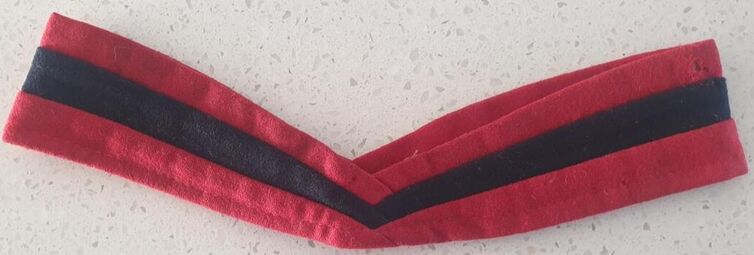
- Opposite: A Red/Dark Blue/Red Puggaree, introduced 1923 and worn by the New Zealand Ordnance Corps.
The R.N.Z.A.O.C. was absorbed into the Royal New Zealand Logistics Regiment on 9th December 1996.
Fakes and Forgeries
This is by no means the definitive list, and there will, I'm sure be other fakes, but this one is not a bad attempt of to copy/deceive.
- Detail is OK to front, and the fact that many of the original badges were polished with pride, means this might pass at a glance.
- Colour again is a orangey-yellow, and not a brass colour.
- Back lacks detail and is pitted, but note only a very small flat area to one edge to show where it was cast, and what had to be removed/filed down.
- Lugs are again copper and brazed to back, but they are a small, thin type, not normally found on a badge like this.
- Detail is OK to front, and the fact that many of the original badges were polished with pride, means this might pass at a glance.
- Colour again is a orangey-yellow, and not a brass colour.
- Back lacks detail and is pitted, but note only a very small flat area to one edge to show where it was cast, and what had to be removed/filed down.
- Lugs are again copper and brazed to back, but they are a small, thin type, not normally found on a badge like this.
NZ School of Musketry
During WW1, a specialised School of Musketry was set up to establish a standard in Rifle Expertise amongst the Reinforcements.
|
- Opposite: A Officers gilt brass Cap badge to the NZ School of Musketry. This is the void type of Cap badge, with a non-void variation also seen. Copper wire looped lugs to back.
- Above: A Officers gilt Collar badge pair to the NZ School of Musketry. Either wire looped lugs or flat brass hex type to back. |
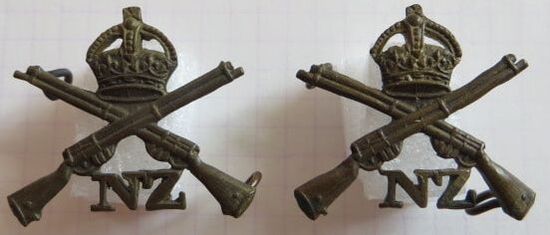
- Opposite: A pair of Collar badges worn by ordinary ranks in the NZ School of Musketry. The Cap badge is just a larger version of these two badges.
All are single piece, gilt brass, with two copper wire looped lugs to back.
No maker mark.
All are single piece, gilt brass, with two copper wire looped lugs to back.
No maker mark.
New Zealand Maori Pioneer Battalion
At the outbreak of WW1, there were calls for the Maori and Pacific Island communities to join the New Zealand Expeditionary Force. Some were opposed, and refused to enlist, while others joined enthusiastically, and enlisted in the call to arms.
Discussions around the badge to be worn by the unit began around October 1914, with a dated memo of the 2nd of Nov 1914, between Lieut-Col Gibbon and a Dr Pomare, where they discussed on whether the initials N.Z.M.C - New Zealand Maori Contingent, or N.Z.N.C - New Zealand Native Contingent be used. It was decided on the latter, for obvious reasons, otherwise this would clash with the New Zealand Medical Corps who already used N.Z.M.C.
Discussions around the badge to be worn by the unit began around October 1914, with a dated memo of the 2nd of Nov 1914, between Lieut-Col Gibbon and a Dr Pomare, where they discussed on whether the initials N.Z.M.C - New Zealand Maori Contingent, or N.Z.N.C - New Zealand Native Contingent be used. It was decided on the latter, for obvious reasons, otherwise this would clash with the New Zealand Medical Corps who already used N.Z.M.C.
|
- Opposite & Above: A superbly important letter from a Mr Laurenson of G T White, dated 29th of Oct 1914. Laurenson was a Jeweler, based in Wellington, who confirms that he could supply 750 examples of the badge in both Gilt and Bronze, for the Maori Contingent Expeditionary Force, at a cost of "2/6".
He goes on to comment that the initial design (above right), needs simplification, which sadly also sees the letters "NZ MC" around the crown removed. He also asks, that all Maori weapons be within the oval edges on the badge. This seems to reduce the cost to "2/-" and he includes a picture of his proposed design (above center). We can only presume that it meets approval, as this is produced as the 1st type of badge discussed below (taken from the album of Shaun Aumua British Badge Forum). |
Upon arrival in March 1915, in Egypt, the battalion were not deployed for the initial Gallipoli campaign, instead they were moved to Malta, where they took up garrison duties and underwent further training. However, due to the high casualties experienced by the NZEF at Gallipoli, the battalion was transferred in July 1915 to the conflict, to fight alongside the New Zealand Mounted Rifles, which were fighting as dismounted Infantry.
With the withdrawal of New Zealand troops from the peninsular in early 1916, the Maori Battalion was designated to be broken up, and its members disbursed as general reinforcements through the newly formed divisions which were then readying for their move to France and the Western Front.
But on the 20th of Feb 1916, its members re-formed into the New Zealand Maori Pioneer Battalion (with members of the Otago Mounted Rifles also augmenting their numbers) and in April 1916 they left for France.
The Battalion was the only unit from the New Zealand Expeditionary Force to disband in New Zealand in April 1919.
There are 3 types or styles of badge the Battalion wore from 1916 to 1919.
Motto: TE HOKO WHITU A TU (The one hundred and forty of Tu. Tu is the God of war, while 140 was the standard strength of a war party).
With the withdrawal of New Zealand troops from the peninsular in early 1916, the Maori Battalion was designated to be broken up, and its members disbursed as general reinforcements through the newly formed divisions which were then readying for their move to France and the Western Front.
But on the 20th of Feb 1916, its members re-formed into the New Zealand Maori Pioneer Battalion (with members of the Otago Mounted Rifles also augmenting their numbers) and in April 1916 they left for France.
The Battalion was the only unit from the New Zealand Expeditionary Force to disband in New Zealand in April 1919.
There are 3 types or styles of badge the Battalion wore from 1916 to 1919.
Motto: TE HOKO WHITU A TU (The one hundred and forty of Tu. Tu is the God of war, while 140 was the standard strength of a war party).
N.Z.N.C Badges Worn in NZ & Overseas - 1st Type
The following is considered the "1st type" worn by the unit, and resembles White's above design. These badges were worn in New Zealand and overseas, and we are told till Feb 1916 (Corbett - page 236), though photo's show this to be longer.
There are variations, made by Ruben Watts of Auckland. Sadly G E White (Laurenson) did not maker mark his badges.
Initially these badges were for the Sunhat only, with only a coloured patch to be worn to front of peaked cap (Black over Red), but eventually they were also worn on the Cap and Collars.
There are variations, made by Ruben Watts of Auckland. Sadly G E White (Laurenson) did not maker mark his badges.
Initially these badges were for the Sunhat only, with only a coloured patch to be worn to front of peaked cap (Black over Red), but eventually they were also worn on the Cap and Collars.
|
- Above: A 1st type, bronze badge to the New Zealand Native Contingent, with N.Z.N.C to base. Two wire looped lugs to back, with no maker mark. Size 35.5mm by 26mm.
|
- Above: A 1st type, gilt brass badge to the New Zealand Native Contingent, with N.Z.N.C to base. Two wire looped lugs to back (though one is missing), with no maker mark. Size 35.5mm by 26mm.
|
- Above: A 1st type, gilt brass badge to the New Zealand Native Contingent, with N.Z.N.C to base. Brooched to back, with no maker mark. Size 35mm by 26mm.
|
|
- Above: A 1st type, cast gilt brass badge to the New Zealand Native Contingent, with N.Z.N.C to base. Two copper looped lugs to back, with no maker mark. Size 35mm by 25mm.
|
- Above: A variation in design to the 1st type, gilt brass badge to the New Zealand Native Contingent Note the small "N.Z.N.C" to lower front. This badge is impressed to back in two places to "WATT" and "AUCK". Two short copper looped lugs to back. Size 37mm by 28mm.
|
- Above: A variation in design to the 1st type, gilt brass Collar badge to the New Zealand Native Contingent Note the small "N.Z.N.C" to lower front. No maker mark, but known to be made by Watts of Auckland. Some are found to be marked to this Jeweler. Size 25mm diameter.
|
|
The following gives the numbers of main body and reinforcements to the unit, which left New Zealand.
Note with reorganisation of the NZEF in April 1916, a number of men joined the unit from other formations already in Egypt, notably men from the Otago Mounted Rifles. - 1st Maori Draft - sailed 14th Feb 1915 with 3rd Inf Reio's - 16 Officers & 502 Men - 2nd Maori Draft - sailed 19th Sept 1915 with balance of 6th Inf Reio's - 10 Officers & 301 Men - 3rd Maori Draft - sailed 6th Feb 1916 with 2nd & 4th Batt of NZRB - 3 Officers & 108 Men - 4th Maori Draft - sailed 6th May 1916 with the 12th inf Reio's - 2 Officers & 72 Men - 5th Maori Draft - sailed 26th June 1916 with the 14th Inf Reio's - 1 Officer & 57 Men - 6th Maori Draft - sailed 29th July 1916 with the 15th Inf Reio's - 2 Officers & 87 Men - 7th Maori Draft - sailed 20th Aug 1916 with the 16th Inf Reio's - 1 Officer & 71 Men - 8th Maori Draft - sailed 24th Sept 1916 with the 17th Inf Reio's - 1 Officer & 63 Men - 9th Maori Draft - sailed 14th Oct 1916 with the 18th Inf Reio's - 1 Officer & 61 Men - 10th Maori Draft - sailed 16th Nov 1916 with the 19th Inf Reio's - 1 Officer & 70 Men - 11th Maori Draft - sailed 2nd Jan 1917 with the balance of the 20th Inf Reio's - 70 Men - 12th Maori Draft - sailed 19th Jan 1917 with 21st Inf Reio's- 1 Officer & 60 Men - 13th Maori Draft - sailed 16th Feb 1917 with 22nd Inf Reio's - 1 Officer & 60 Men - 14th Maori Draft - sailed 3rd April 1917 with balance of 23rd Inf Reio's - 1 Officer & 39 Men - 15th Maori Draft - sailed 26th April 1917 with 25th Inf Reio's - 29 Men - 16th Maori Draft - sailed 26th April 1917 with 25th Inf Reio's - 30 Men - 17th Maori Draft - sailed 12th June 1917 with balance of 26th & 1st part of 27th Inf Reio's - 1 Officer & 30 Men - 18th Maori Draft - sailed 16th July 1917 with balance of 27th Inf Reio's - 1 Officer & 49 Men - 19th Maori Draft - sailed 26th July 1917 with balance of 28th Inf Reio,s - 1 Officer & 50 Men - 20th Maori Draft - sailed 15th Aug 1917 with 1st part of 29th Inf Reio's - 1 Officer & 49 Men - 21st Maori Draft - sailed 13th Oct 1917 with balance of 29th and the 30th Inf Reio's - 30 Men - 22nd Maori Draft - sailed 17th & 22nd Nov 1917 with 31st & 32nd Inf Reio's - 2 Officers & 60 Men - 23rd Maori Draft - sailed 31st Dec 1917 with 33rd Inf Reio's - 30 Men - 24th Maori Draft - sailed 8th Feb 1918 with 34th Inf Reio's - 1 Officer & 54 Men - 25th Maori Draft - sailed 3rd Mar 1918 with 35th Inf Reio's - 14 Men - 26th Maori Draft - sailed 23rd April 1918 with 36th Inf, 37th MR, 28th Artillery Reio's - 12 Men - 27th Maori Draft - sailed 9th May 1918 with 1st part of 37th Inf Reio's - 7 Men - 28th Maori Draft - sailed 13th June 1918 with 39th Inf Reio's - 16 Men - 29th Maori Draft - sailed 18th Aug 1918 with 1st part of 43rd Inf Reio's - 1 Officer & 57 Men - 30th Maori Draft - sailed 3rd Oct 1918 with balance of 43rd Inf Reio's - 40 Men - 1st Rarotongan Draft - sailed 6th Feb 1916 with 2nd & 4th Batt of NZRB - 5 Officers & 198 Men (included 148 Niue Islanders) - 2nd Rarotongan Draft - sailed 16th Nov 1916 with the 19th Inf Reio's - 3 Officers & 110 Men - 3rd Rarotongan Draft - sailed 13th June 1918 with 39th Inf Reio's - 3 Officers & 142 Men Total was 60 Officers and 2,628 Men While still training in New Zealand on the 12th of Nov 1918 were - Maori - 3 Officers & 173 Men - Rarotongans - 1 Officer & 92 Men - Gilbert Islanders - 1 Officer & 22 Men - Fijians - 1 Officer & 53 Men. |
- Above: A 1st type, gilt brass badge to the New Zealand Native Contingent, with N.Z.N.C to base. Note the rounded crown. I believe this version was made later, and worn as a Reinforcement badge in New Zealand. It has two hex type brass lugs to back, but no maker mark. It appears to be issued blackened, and there are traces of this finish to the back of the badge. I have also sighted a gilt brass version. Size 36mm by 26mm.
- Above: A unfinished 1st type, C. M. Bay made New Zealand Native Contingent badge. This came from a group of items purchased from his son by a fellow collector. Note the rounded crown to center.
|
N.Z. Pioneer Badges Worn Overseas by the N.Z.E.F - 2nd Type
Like most other serving overseas New Zealand units in WW1, J R Gaunt got involved in providing badges to the unit while they served in France.
Corbett states in his book that the following badge was worn after Feb 1916 to Sept 1917.
The UK manufacturer "Firmin & Sons" of Birmingham also made a version of the below badges, but in smaller quantities. It is their dies which sadly now provide us with so many fakes of this badge.
Corbett states in his book that the following badge was worn after Feb 1916 to Sept 1917.
The UK manufacturer "Firmin & Sons" of Birmingham also made a version of the below badges, but in smaller quantities. It is their dies which sadly now provide us with so many fakes of this badge.
|
- Opposite and Above: The 2nd type of Cap and Collar badge to the New Zealand Pioneer Battalion. The three have either copper looped lugs (to the Cap) or D shaped Copper lugs (to the collars). All have a maker plaque to "J R GAUNT LONDON". Size of Cap 50mm by 36mm, while Collars are 37.5mm by 26.5mm.
|
|
- Opposite and Above: The 2nd Type of Cap and Collar badge to the New Zealand Pioneer Battalion. Note the necklace has been removed. Maori tradition does not permit a Warrior to wear jewellery into battle, so they modified the badge in the field by removing the necklace just below the Warriors head. All have a maker plaque to "J R GAUNT LONDON". Size of Cap 50mm by 36mm, while Collars are 37.5mm by 26.5mm.
|
|
- Above: A gilt brass Collar badge pair to the New Zealand Pioneer Battalion. Both have had their necklaces removed and are not maker marked. Both have two copper D shaped looped lugs to back. Possible Gaunt made. Size 37mm by 26mm.
|
- Above: A cast bronze collar badge in the form of the 2nd type of badge to the New Zealand Pioneer Battalion, with necklace removed. Note this badge has two tangs or blades to its solid back. No maker mark and size 37mm by 26mm.
|
N.Z. Pioneer Badges Worn Overseas and on the Return Home to NZ - 3rd Type
Corbett states in his book that the following badge was worn after Sept 1917 to the units disbandment in April 1919.
|
- Above: The 3rd type of Cap or Collar (worn as either) to the New Zealand Pioneer Battalion in gilt brass. This was the last type, and worn home to NZ when the Battalion was disbanded in 1919. Note the base of the badge just has the large letters "N.Z." to base. D shaped copper looped lugs to back and no maker mark. Size 35.5mm by 26.5mm.
|
- Above: During WW1 the Cook Island Company was formed and sailed for service in the middle East. There has yet to be any recorded pictures that the above badge was worn at the time. Its felt that this badge was issued to WW2 Raratongan Home Guard Units. It comes with matching collars, though they are very rare. Note the banner with "Cook Is Coy". Two copper looped lugs to back, but no maker mark. Size 51mm by 36.5mm.
|
|
- Above: A set of shoulder titles to the New Zealand Native Corps (N.Z.N.C.). Both are gilt brass and are impressed to back to "J R GAUNT LONDON". Size 15mm by 52mm.
|
- Above: A brass trade sleeve badge for a Pioneer. Crossed Axes. This badge also has its circular backing plate.
|
- Above: A embroidered thread and khaki wool backed trade sleeve badge for a Pioneer (Ian Hamilton Collection).
|
Fakes and Forgeries
The 2nd type of badge has been widely faked, as the Firmin dies were purchased in the UK and numerous badges were struck from the original dies. They tend to be non-void on the necklace below the Warriors head, giving the impression that he (the Warrior) has a beard, but also have a slider to back, which on at least the Gaunt made originals, they never had. To confuse things, Firmin did of course make original examples of this 2nd type New Zealand Pioneers badge.
Below is a fake or cast copy of the badge.
- OK detail to front, note that the Warrior is missing the feather to the back, top of his head.
- Colour is orangey-yellow, which is wrong for a gilt brass badge.
- To back the detail is shallow, which on a die-stamped example, would be crisp and deep. There are also three flat, filed area's, where the extra brass from the casting process has been filed back/removed.
- The lugs though copper and brazed to back, are small and ribbon like, which is wrong for this badge.
- Size 48mm by 37mm (remember, missing feather to top).
Below is a fake or cast copy of the badge.
- OK detail to front, note that the Warrior is missing the feather to the back, top of his head.
- Colour is orangey-yellow, which is wrong for a gilt brass badge.
- To back the detail is shallow, which on a die-stamped example, would be crisp and deep. There are also three flat, filed area's, where the extra brass from the casting process has been filed back/removed.
- The lugs though copper and brazed to back, are small and ribbon like, which is wrong for this badge.
- Size 48mm by 37mm (remember, missing feather to top).
The below is a bit of a worry, as with time, the finish will dull to this fake 3rd type New Zealand Pioneers badge, and it will start to look more "real".
- OK detail to front, but some faults with the ridges on the wreath, around the outside of the badge.
- Colour is orangey-yellow, which is wrong for a gilt brass badge.
- To back the detail is OK, and not far off the originals. But note the stippling and rough surface. Originals are smooth.
- The lugs though copper and brazed to back, are small and ribbon like, which is wrong for this badge.
- Size 35mm by 25mm.
- OK detail to front, but some faults with the ridges on the wreath, around the outside of the badge.
- Colour is orangey-yellow, which is wrong for a gilt brass badge.
- To back the detail is OK, and not far off the originals. But note the stippling and rough surface. Originals are smooth.
- The lugs though copper and brazed to back, are small and ribbon like, which is wrong for this badge.
- Size 35mm by 25mm.
Royal New Zealand Military Police
The New Zealand Military Police was first formed in 1915, but was disbanded at the conclusion of WW1. It then reformed again at the start of WW2, but was replaced by Provost Companies in 1946.
The New Zealand Provost Corps was then formed on the 18th of Feb 1949, with the Corps gaining the prefix "Royal" on the 18th of July 1952.
Motto: KO TATOU HEI TAUIRA (We serve as examples).
The New Zealand Provost Corps was then formed on the 18th of Feb 1949, with the Corps gaining the prefix "Royal" on the 18th of July 1952.
Motto: KO TATOU HEI TAUIRA (We serve as examples).
|
- Above: A single piece, gilt brass Cap badge to the New Zealand Military Police. Not marked, but thin twisted copper wire lugs to back, which are found on a number of other WW1 New Zealand made badges.
|
- Above: A matching pair of Collar badges to the New Zealand Military Police. These are the same design as the Cap badge, but with the lower banner removed or cut off. Both have two hex type brass flat lugs to back. No maker mark and likely WW1.
|
During WW1, two of the largest Army training camps had their own Camp Military Police (CMP) force.
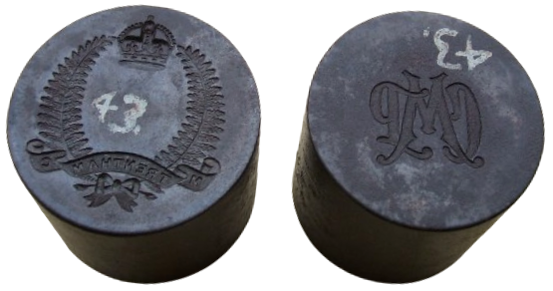
- Opposite: A rare image, this shows the two front dies which were used to likely construct the above Trentham Collar badges. One for the frame struck in brass, and the other for the white metal "CMP" center. Both have a manufacturers reference painted on for "43.".
Apparently they are a combined weight of 1.5kgs and are 54mm in diameter and 40mm tall.
No maker mark (image from the internet).
Apparently they are a combined weight of 1.5kgs and are 54mm in diameter and 40mm tall.
No maker mark (image from the internet).
|
- Opposite Left: A gilt brass Cap badge to the New Zealand Military Police. Two thick copper looped lugs to back and a mark mark of "M & K, W" for Mayer & Kean, Wellington. This would likely be the WW2 version of the badge.
- Opposite Right: A chromed Cap badge to the New Zealand Military Police. Like the Gilt brass version, it has a maker mark of "M & K, W" and two copper looped lugs. |
- Above Right: A brass shoulder titles to the New Zealand Military Police. Like the below curved examples, this is just a modified N.Z.M.R (New Zealand Mounted Rifles) title, with the foot of the "R" removed. It has two D shaped copper loops to back, with no maker mark. Size 14mm by 51mm.
|
- Above: A pair of brass shoulder titles to the New Zealand Military Police. These are just modified N.Z.M.R (New Zealand Mounted Rifles) titles, with the foot of the "R" removed.
Both have hex type brass lugs to back and are maker impressed to "J R Gaunt, London" to the back of the "Z". Size 14mm by 48mm (roughly). |
- Above Top: A single brass shoulder titles to the New Zealand Military Police. Hex type lugs to back, but no maker mark Size 14mm by 48mm (roughly).
- Above Base: A single brass shoulder titles to the New Zealand Military Police. Copper looped lugs to back, with maker mark of "Stokes & Sons impressed. Size 15mm by 48mm (roughly). |
Note: The above version of the New Zealand Military Police Badges are widely faked, and has been for a number of years, both the Cap and Collar.
A commemorative box set of badges were also produced by the Corps which can confuse what its original and what is not.
A commemorative box set of badges were also produced by the Corps which can confuse what its original and what is not.
|
- Above: A early post 1952 Cap badge in Silver or Silver plate (not marked) to the Royal New Zealand Provost Corps. Not maker marked, and with two long looped lugs to back. Size 44mm by 47mm.
|
- Above: A anodised aluminium Cap badge to the Royal New Zealand Provost Corps. Not maker marked, and with two long pins to back to be used with clutches. Size 43mm by 47mm.
|
- Above: A anodised aluminium Cap badge to the Royal New Zealand Provost Corps. Not maker marked, and with two long looped lugs to back. Size 44mm by 48mm.
|
|
- Above: A early post 1952 Collar badges in Silver or Silver plate (not marked) to the Royal New Zealand Provost Corps. Not maker marked, and with two D shaped lugs to back of each. Size 30mm by 33mm.
|
- Above: A anodised aluminium Collar badge pair to the Royal New Zealand Provost Corps. Not maker marked, and with two pins to back to be used with clutches. Size 30mm by 33mm.
|
|
This is the current version of the cap badge now worn. The title was changed again in the 1980's to Royal New Zealand Military Police.
- Center A chromed metal and blue resin Cap badge with two screw fittings to back and the maker mark of "Mayer Toye Ltd, Wellington". - Left & Right: Two chromed metal and blue resin Collar badges to the Royal New Zealand Military Police. No maker mark. |
- Above Left: A belt buckle center to the Royal New Zealand Military Police. No maker mark.
- Above Right: A chromed metal and blue resin Cap badge with a bar fitting to back and the maker mark of "Mayer & Toye WGTN NZ" and their phone number. |
|
- Above: A Royal Blue, with black headband Beret to the Royal New Zealand Military Police. A small size, it doesn't look like it has ever been used. Introduced in 1983, it is still worn today.
|
- Above: The same Beret to the Royal New Zealand Military Police. Someone has pealed off the label on the packaging and stuck it on the inside of the Beret. Its has the following on the label "1BERERNZMP 98-107-9138, RNZMP beret 54 BDR". Size 54cm or 6 5/8 inches.
|

- Opposite: An earlier puggaree to fit the Lemon Squeezer hat to the Royal New Zealand Provost Corps. Dark Blue/Dark Blue/Dark Blue.
|
- Above: A 25mm, anodised aluminium or stybright button to the Royal New Zealand Provost Corps. Brass backed, with fixed shank, it is maker marked to "Buttons Ltd, Birmingham" and with crossed swords.
|
Fakes and Forgeries
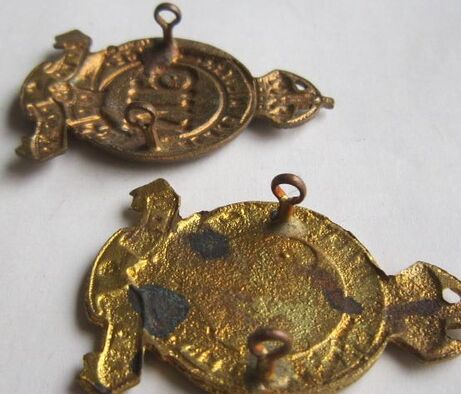
This is another badge which is widely faked, but they follow what I am showing in the surrounding pictures. Slightly confusing, but there are also official restrikes of this badge, done as part of a set for an anniversary of the Royal New Zealand Provost Corps.
- Detail is good to front, note the above left badge, which shows age, also originals can be very worn, as in the badge was polished to a high standard, which also works in favour of the fakes.
- Colour is orangey-yellow, on at least the above right example, which is wrong for a gilt brass badge.
- To back the detail on the left badge is good, but shallow on the right, and stippled/pitted. Note there are flat, filed area's, on both, where the extra brass from the mold has been filed back/removed.
- The lugs though copper and brazed to back, are small and ribbon like, which is wrong for this badge.
- Size 45mm by 32mm.
The Collar badge in this type, is just a Cap badge, with the bottom banner cut off, and I can imagine that they are easily made from the above examples and of course removing all evidence of the file brass areas from the molding process.
- Detail is good to front, note the above left badge, which shows age, also originals can be very worn, as in the badge was polished to a high standard, which also works in favour of the fakes.
- Colour is orangey-yellow, on at least the above right example, which is wrong for a gilt brass badge.
- To back the detail on the left badge is good, but shallow on the right, and stippled/pitted. Note there are flat, filed area's, on both, where the extra brass from the mold has been filed back/removed.
- The lugs though copper and brazed to back, are small and ribbon like, which is wrong for this badge.
- Size 45mm by 32mm.
The Collar badge in this type, is just a Cap badge, with the bottom banner cut off, and I can imagine that they are easily made from the above examples and of course removing all evidence of the file brass areas from the molding process.
The below Royal NZ Provost Corps badge, though not a bad example, is an obvious fake in gilt brass, as the badge was only issued in Silver, Silver plate, or silver tone anodised aluminium.
Detail is good as usual to front to this fake, but bad to back, with pitting and cracking. The small copper lugs are the wrong shape, but are in copper and brazed on.
Detail is good as usual to front to this fake, but bad to back, with pitting and cracking. The small copper lugs are the wrong shape, but are in copper and brazed on.
New Zealand Women's National Service Corps
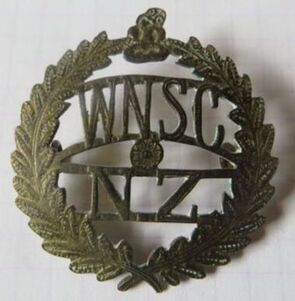
Formed during WW2 in 1941, the New Zealand Women's National Service Corps was set up to assist and provide recruitment to the New Zealand Army of typists, drivers and cooks. It became part of the New Zealand Army Service corps in 1942.
- Opposite: A scarce gilt brass cap badge to the New Zealand Women's National Service Corps (W.N.S.C).
No maker mark and with two copper loops to back.
- Opposite: A scarce gilt brass cap badge to the New Zealand Women's National Service Corps (W.N.S.C).
No maker mark and with two copper loops to back.
New Zealand Women's Land Corps/Service
In 1941 the New Zealand Women's Land Corps was formed by the New Zealand Women's War Service Auxiliary. They changed their title to New Zealand Women's Land Service in late 1942.
The service was disbanded at the end of WW2.
The service was disbanded at the end of WW2.
- Opposite: Early Land Service titles in light blue embroidered letters on a brown background, with a lighter brown border.
New Zealand Women's Royal Army Corps
The New Zealand Women's Auxiliary Army Corps formed in July 1942, and became a Corps of the regular New Zealand Army in 1947.
Motto: Pro Patria (For our country).
Motto: Pro Patria (For our country).
|
- Above: A gilt brass cap badge to the New Zealand Women's Auxiliary Army Corps (W.A.A.C). Maker marked to lower back, left to "M & K, W" or Mayer & Kean, Wellington. No collars appear to be issued with this badge.
Size 41mm by 35.5mm. |
- Above: In 1952, the Corps was awarded the prefix "Royal" to their title, and at some stage the commissioned badge from Stokes & Sons of Melbourne. This is the two piece, other ranks Cap badge to the New Zealand Women's Royal Army Corps. Maker marked to "Stokes Melb" to back.
|
|
- Above: A rare Officers gilt fired brass, Silver and enamel Cap badge to the New Zealand Women's Royal Army Corps. It is maker marked to "Stokes Melb" to back.
|
- Above: A rare Officers opposing gilt fired brass, Silver and enamel Collar set to the New Zealand Women's Royal Army Corps. Both are not maker marked, and have lugs in a North/South config, with the loops twisted so that the openings are to the side. A feature more common on a Australian Army Cap/Collar.
|
|
- Above: A anodised aluminium staybrite Cap badge, note only 2 tone, with the green missing from central wreath. Separate Tui is again attached to center. No maker mark and pins and clutches to back.
|
- Above: A pair of opposing anodised aluminium staybrite Collar badges to the New Zealand Women's Royal Army Corps. They are both single piece, three tone, with pins and clutches to back. Both are maker marked to "J R Gaunt London".
|
|
- Above: A anodised aluminium staybrite Cap and Collar badge to the New Zealand Women's Royal Army Corps. Both are three tone, with the Collar a single piece, and Cap 2 piece, with separate Tui applied to center.
Both have looped lugs to back, and the collar is maker marked to "J R Gaunt London. |
- Above: A gilt tone, anodised aluminium 26mm button to the New Zealand Women's Royal Army Corps. Queens crown, it is maker marked to "Gaunt, London" to back, with fixed shank.
|
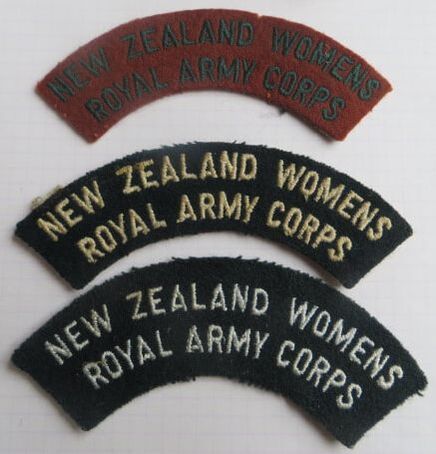
- Opposite Top: A early cloth shoulder title to the New Zealand Womens Royal Army Corps. Tartan Green letters on a Beech Brown felt background.
- Opposite Middle and Bottom: Two cloth shoulder title to the New Zealand Womens Royal Army Corps. Just slight variation in lettering size between them, with white letters on a Tartan green/black felt background.
In July 1977, the corps was disbanded and all personnel were transferred to other parts of the New Zealand Defense Force.
- Opposite Middle and Bottom: Two cloth shoulder title to the New Zealand Womens Royal Army Corps. Just slight variation in lettering size between them, with white letters on a Tartan green/black felt background.
In July 1977, the corps was disbanded and all personnel were transferred to other parts of the New Zealand Defense Force.
Fakes and Forgeries
Below is a fake or reproduction of the New Zealand Women Army Auxilary Corps Cap badge.
Care needs to be take, as this is not bad example, and often originals are very worn anyway, having been polished with pride.
- Good detail to front, but note there are holes and faults to the Tui's back, in the center right of the badge.
- The back shows some stippling, but again a not bad effort. The tell tale sign this is a cast badge is the flat, filed area to the bottom left, circled in red, and shows where the excess brass from the casting process has been filed down, flat.
- Two ribbon like copper looped lugs are to back.
- Size 40.5mm by 35mm.
Care needs to be take, as this is not bad example, and often originals are very worn anyway, having been polished with pride.
- Good detail to front, but note there are holes and faults to the Tui's back, in the center right of the badge.
- The back shows some stippling, but again a not bad effort. The tell tale sign this is a cast badge is the flat, filed area to the bottom left, circled in red, and shows where the excess brass from the casting process has been filed down, flat.
- Two ribbon like copper looped lugs are to back.
- Size 40.5mm by 35mm.
Services Vegetable Production
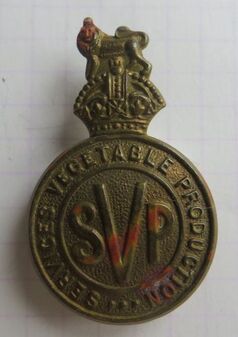
The New Zealand Government recognised by early 1942 that vegetables would have to be grown on a massive scale if the American and New Zealand troops serving in the Pacific war were to be properly fed.
When the government's Services' Vegetable Production Scheme came into force in July 1942, growers undertook to produce huge quantities of vegetables, with State farms also being established to meet any shortfall.
The scheme was shut down in 1945 as hostilities ceased.
- Opposite: A gilt brass badge to the Services Vegetable Production (SVP). This badge is brooched to back, but the one or two other examples I have seen of this badge, also have copper looped lugs, in a North/South config, which begs the question whether they came in two types, brooched or lugged.
Maker marked to back to "M & K, W" or Mayer and Kean, Wellington.
When the government's Services' Vegetable Production Scheme came into force in July 1942, growers undertook to produce huge quantities of vegetables, with State farms also being established to meet any shortfall.
The scheme was shut down in 1945 as hostilities ceased.
- Opposite: A gilt brass badge to the Services Vegetable Production (SVP). This badge is brooched to back, but the one or two other examples I have seen of this badge, also have copper looped lugs, in a North/South config, which begs the question whether they came in two types, brooched or lugged.
Maker marked to back to "M & K, W" or Mayer and Kean, Wellington.
Royal New Zealand Corps of Signals
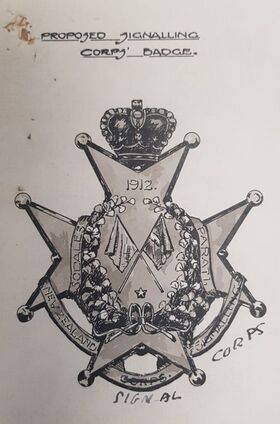
The New Zealand Corps of Signals form in 1912 from companies within the New Zealand Engineers. It amalgamated with the New Zealand Post and Telegraph Corps on the 1st of June 1921.
Motto: SODALES PARATI (Prepared as comrades together).
- Opposite: A superb drawing from the New Zealand Archives, attached to a letter written on the 17th of May 1917.
"Memorandum for the
P.M.O.
Trentham
Regimental Badges
With reference to the attached request can you kindly supply these badges.
Lt A Hills (Lieut for the D.G.M.S)"
Note on the 27th of Feb 1912, the badge was approved, with the amendment to the banner to read "New Zealand Signal Corps".
It was then approved for wear for all Companies of the NZ Signal Corps on the 2nd March 1912.
Motto: SODALES PARATI (Prepared as comrades together).
- Opposite: A superb drawing from the New Zealand Archives, attached to a letter written on the 17th of May 1917.
"Memorandum for the
P.M.O.
Trentham
Regimental Badges
With reference to the attached request can you kindly supply these badges.
Lt A Hills (Lieut for the D.G.M.S)"
Note on the 27th of Feb 1912, the badge was approved, with the amendment to the banner to read "New Zealand Signal Corps".
It was then approved for wear for all Companies of the NZ Signal Corps on the 2nd March 1912.
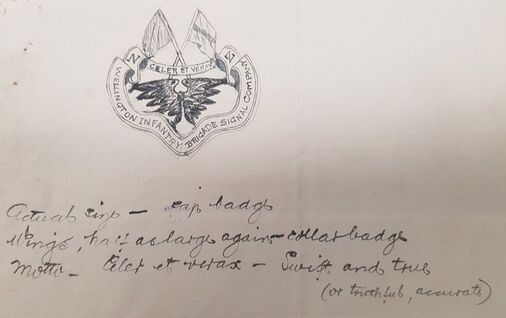
Up to this point there has been considerable push-back by individual Signal Companies, all wanting their own bespoke badge representing their Military District. They were overruled by the General Officer Commanding as per memo dated 30th of Aug 1911.
- Opposite: A hand drawn design for the Wellington Infantry Brigade Signal Company badge, which was submitted by its CO on the 28th of Aug 1911.
The design was not approved.
(Badges - Regimental - Territorial Force, R23534556 AD1 AAYS 13-13 Archives NZ).
- Opposite: A hand drawn design for the Wellington Infantry Brigade Signal Company badge, which was submitted by its CO on the 28th of Aug 1911.
The design was not approved.
(Badges - Regimental - Territorial Force, R23534556 AD1 AAYS 13-13 Archives NZ).
|
- Opposite and Above: Prior to WW1 a large, die stamped oversized badge was worn by some Mounted Rifles signal companies of the New Zealand Corps of Signals. Opposite is the oversize Cap badge in gilt brass. Note the ball missing to lower right, which seems to be a die fault, and I have seen a handful of these badges with the same missing tip. Above are what are termed as "rough" type Collar badges (which are actually the later Cap badge in size). All three badges are not maker marked. All have thin copper loops to back.
|
|
- Opposite and Above: A gilt set of Cap and Collar badges to the New Zealand Corps of Signals. All are semi-solid to back and maker marked to back. The Cap has "Stokes & Sons Melbourne", while the Collars just have "Stokes & Sons Melb". They all have rounded copper loops to back. Cap size 43mm by 34mm.
|
|
- Above: A study in size of the New Zealand Corps of Signals Badges. Left is the oversized, pre-WW1 Cap badge roughly 51mm by 42mm. Center is a standard Cap badge roughly 41mm by 32mm. Right is a standard Collar badge roughly 31mm by 25mm.
|
- Above: A unmarked gilt brass Collar badge set to the New Zealand Corps of Signals. D shaped copper looped lugs to back, so likely a unmarked Gaunt made pair.
|
|
- Above: A pair of matching gilt brass grenade collar badges. Two round copper looped lugs to back in a North/South configuration. No maker mark, and size 31mm by 19mm.
|
- Above: A pair of matching coppery brass grenade collar badges. Two copper looped lugs with feet to back in a North/South configuration. No maker mark, and size 31mm by 19mm.
|
- Above Left: A gilt brass grenade collar badge. Two brass looped lugs to back in a North/South configuration. No maker mark, and size 30mm by 18mm.
- Above Right : A gilt brass grenade collar badge. Two hex type brass lugs to back in a North/South configuration. No maker mark, and size 33mm by 20mm. |
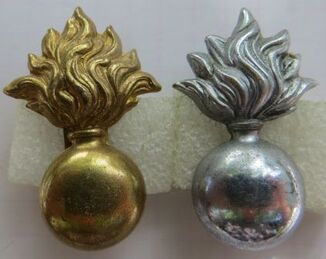
- Opposite Left: A gilt brass grenade collar badge. A brass lug bar to back in a North/South configuration. No maker mark, and size 32mm by 21mm.
- Opposite Right : A chromed brass grenade collar badge. Two copper looped lugs to back in a North/South configuration. No maker mark, and size 32mm by 20mm.
- Opposite Right : A chromed brass grenade collar badge. Two copper looped lugs to back in a North/South configuration. No maker mark, and size 32mm by 20mm.
|
In 1938, New Zealand adopted the British pattern of Signals Corps Cap and Collar badge.
- Above: A scarce gilt fired, solid backed and silver center (not marked) Cap and Collar badge to the New Zealand Corps of Signals. Copper looped lugs to back, no maker mark. |
|
|
- Above: A variation on the New Zealand Corps of Signals Cap and Collar badge in darkened finish. Note the Cap has a slider to back. No maker marks to either.
- Opposite: A striking image of a Captain in the New Zealand Corps of Signals. He wears a darkened "Onwards" Cap badge to his hat, but has a darkened New Zealand Corps of Signals Collar. He also appears to wear a ribbon for the Military Cross. Sadly image is not named or dated. |
In 1947, the Corps was awarded the prefix "Royal", and this meant a change in title and badge. Again, the UK pattern of badge was adopted by the Corps.
Motto: CERTA CITO (Fast and sure).
Motto: CERTA CITO (Fast and sure).
|
- Opposite & Above: A gilt fired Brass & Silver (marked) Cap and Collar badge set to the Royal New Zealand Signals. Most of these badges are British, with a separate lower scroll attached, and brazed to middle and either end. Impressed to back to "J R Gaunt London" and "S" for Silver. All have looped lugs to back. The Cap badge crown, is tanged to back. Size of Crown 10mm by 10mm, size of Cap and Collars 40mm by 26mm.
|
|
- Above: A back image to show the difference between a Cap badge (left) and a Collar badge (right). Its all in the length of the lugs, with the longer being the Cap badge, and shorter being the Collar. Both these badges are pictured above, and are impress to "J R Gaunt London" and "S" for Silver.
|
- Above: A gilt Brass & white metal Cap badge to the Royal New Zealand Signals. Long looped lugs to back, with the crown, having a single hex lug. Size of Crown 11mm by 11mm, size of Cap 40mm by 26mm.
|
- Above: A gilt Brass & white metal Collar badge to the Royal New Zealand Signals. D shaped copper lugs to back, and maker impressed to "J R Gaunt London". Size 40mm by 26mm.
|
|
- Opposite: A rare image of a design drawing for the Cap Badge to the Royal NZ Corps of Signals. Dated 8th June 1964 (Clothing - Badges - RNZ Corps of Signals R22441673 AAYS 213-12-31).
|
- Opposite & Above: A gilt Brass & white metal Cap and Collar badge set to the Royal New Zealand Signals. All have looped lugs to back. The Cap badge crown, has a hex lug to back. Size of Crown 11mm by 11mm, size of Cap and Collars 40mm by 26mm.
|
|
- Above: A set of anodised aluminium staybrite Cap badge and collars to the Royal New Zealand Corps of Signals. No maker mark to back and come either with lugs or pins. Not a great badge in terms of wear or to collect as they are rather fragile and break either on the pins to back or on the leg in the center.
|
- Above: A Officers bullion and dark green cloth Beret badge to the Royal New Zealand Corps of Signals.
No maker mark to back. Size 58mm by 37mm roughly. |
|
- Opposite: The current version of the Cap badge to the Royal New Zealand Signals Corps in gilt and white metal. This badge has screw posts to back, but no maker mark.
- Above: Cloth Shoulder titles to the Royal New Zealand Signals Corps. White letters on a Spectrum Blue background. The top title is smaller, but a little grubby through wear. |
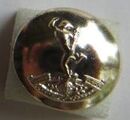
- Opposite: A hard to get, silver tone, fixed shank 14mm anodised aluminium button to the Royal New Zealand Signals Corps. Note the front of the button resembles the Cap badge above, including the round banner at the base of the badge. This differs to the UK and other Commonwealth ones. Brass backed, with the maker marked of "GAUNT LONDON".
I have seen these go for huge sums in terms of modern anodised aluminium button prices.
I have seen these go for huge sums in terms of modern anodised aluminium button prices.

- Opposite: A puggaree to fit the Lemon Squeezer hat to the Royal New Zealand Signal Corps. This is the 3rd type.
1st type: - Pre - 1920 - Khaki/Light Blue/Khaki.
2nd type: - 1935 - Khaki/Half White - Half Light Blue/Khaki.
3rd Type: - Light Blue/Dark Blue/Light Blue.
Slightly fade in colour. Marked to inside with size only, in purple ink to "7". Note the puggaree has been folded side-on.
1st type: - Pre - 1920 - Khaki/Light Blue/Khaki.
2nd type: - 1935 - Khaki/Half White - Half Light Blue/Khaki.
3rd Type: - Light Blue/Dark Blue/Light Blue.
Slightly fade in colour. Marked to inside with size only, in purple ink to "7". Note the puggaree has been folded side-on.
New Zealand Post & Telegraph Corps
The New Zealand Post & Telegraph Corps was formed on the 7th of October 1911 as part of the New Zealand Engineers.
Their badge was described on the 11th of May, 1912 as:
"Winged foot surmounted by a scroll inscribed "Celeritas" and a crown.
- scroll with "N.Z.P & T.C." below."
(Cadets, Regimental Badges and Uniforms R21078962 Box 19 AD37 24 c1912 Archives N.Z.).
They amalgamated on the 1st of June 1921 and became part of the New Zealand Corps of Signals, and their badges were ceased to be worn.
Motto: CELERITAS (Swiftly).
Motto: (NZ Army Postal Service - none in the 1st NZEF - as noted in R17187868 AALI W3508 7291 Archives NZ)
Their badge was described on the 11th of May, 1912 as:
"Winged foot surmounted by a scroll inscribed "Celeritas" and a crown.
- scroll with "N.Z.P & T.C." below."
(Cadets, Regimental Badges and Uniforms R21078962 Box 19 AD37 24 c1912 Archives N.Z.).
They amalgamated on the 1st of June 1921 and became part of the New Zealand Corps of Signals, and their badges were ceased to be worn.
Motto: CELERITAS (Swiftly).
Motto: (NZ Army Postal Service - none in the 1st NZEF - as noted in R17187868 AALI W3508 7291 Archives NZ)
|
- Opposite and Above: A solid Bronze Officers Cap and Collar badge set to the New Zealand Post & Telegraph Corps. All are maker mark impressed to the back of the foot (vertical) to "J R Gaunt London". The Cap badge has two blades or tangs to back, while the Collars have two D shaped copper looped lugs. Note the above left Collar has been polished to front.
|
|
- Opposite & Above: A gilt brass Cap and Collar badge pair to the New Zealand Post & Telegraph Corps. Note the Collars are opposing, with "Big Toes" to center. All have two copper looped lugs to back, with the Collars having D-shaped, while the Cap, large round. All have a maker plaque to "J R Gaunt London". Size of Cap is 42mm by 46mm, Collar size is 31mm by 33mm.
|
|
- Above: A silver washed cap badge to the New Zealand Post & Telegraph Corps. Purpose is unknown, but marked to back with plaque to "J R Gaunt London.
|
- Above Left: A gilt brass variation in the Cap badge to the New Zealand Post & Telegraph Corps. Wide crown and a sharper curve to the lower banner. Not maker marked and has two thick copper wire loops to back.
- Above Right: A gilt brass Cap badge to the New Zealand Post & Telegraph Corps. Two thin wire lugs to back, with maker stamped mark to back of banner to "Bock Wellington". It also has a "WB" to lower right of the banner swirl to front. |
|
- Above: A gilt brass Cap badge to the New Zealand Post & Telegraph Corps. Marked to front again to "WB" to the right in the lower banner swirl. Two brass hex type lugs to back. Not much detail to back.
|
- Above: A matching pair of gilt brass Collar badges to the New Zealand Post & Telegraph Corps. Both have the "WB" to the lower right in the banner swirl. Note the big toes, as they are opposing. No one side is harder to get, its more its hard to get a matching set!!!
Both have two hex type brass lugs to back. |

Opposite are four buttons to the New Zealand Postal & Telegraph. General consensus among collectors is that the white metal version (seen here on the right) are worn by Civilians working for the NZ Government in New Zealand. The brass versions are still an anomaly and could be military, yet no photo has yet been found which shows their wear.
- Left: A brass 21mm button with Kings Crown and "P. & T., N.Z" to front. Maker marked to back to "Stokes & Sons, Melb"
- Above 2nd from Left: A brass 21mm button with Kings Crown and "P. & T., N.Z" to front. Maker marked to back to "Ross & Glenning Ltd"
- Above 2nd from Right: A white metal, 19mm button, with Kings Crown and "P. & T., N.Z" to front. Maker marked to back to "J. R. Gaunt & Son Ltd, London"
- Above Right: A white metal, 16mm button, with Kings Crown and "P. & T., N.Z" to front. Maker marked to back to "Buttons Ltd, Bham", with crossed swords.
- Left: A brass 21mm button with Kings Crown and "P. & T., N.Z" to front. Maker marked to back to "Stokes & Sons, Melb"
- Above 2nd from Left: A brass 21mm button with Kings Crown and "P. & T., N.Z" to front. Maker marked to back to "Ross & Glenning Ltd"
- Above 2nd from Right: A white metal, 19mm button, with Kings Crown and "P. & T., N.Z" to front. Maker marked to back to "J. R. Gaunt & Son Ltd, London"
- Above Right: A white metal, 16mm button, with Kings Crown and "P. & T., N.Z" to front. Maker marked to back to "Buttons Ltd, Bham", with crossed swords.
|
- Above: A pair of gilt brass shoulder titles to the New Zealand Army Postal Service. The top one is maker marked to "J R GAUNT LONDON" to back. Both have a pair of thick hex type lugs. Size 16mm by 54mm.
- Opposite: A image probably of 45259 Arthur Orr of the New Zealand Army Postal Service. Arthur was part of of the 22nd Reinforcements, but was posted as part of the NZAPS as soon as he joined (he had previously work for the NZ Govnt as a Telegraphist), starting on the 11th of Jan 1917. He would then go on and serve in France as part of the service. Arthur is wearing a set of Cap and Collars badge to the New Zealand Post & Telegraph Corps. He has on his shoulder board a curved brass NZAPS (Waitaki Archive. Id 168459). |
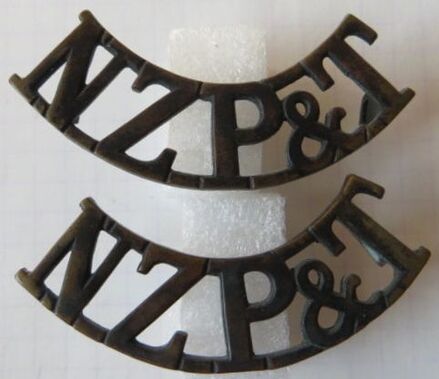
- Opposite: A pair of darkened shoulder titles to the New Zealand Post & Telegraph Corps. Both are maker marked to "J R Gaunt, London" to back, and have hex type, brass lugs.
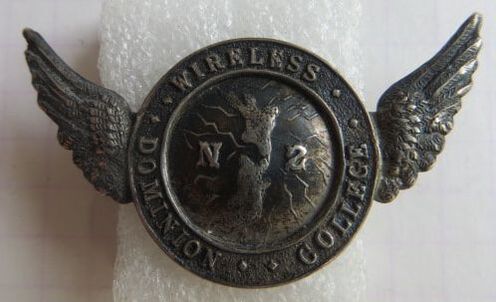
New Zealand got the wireless "bug" just prior to WW1, with a number of commercial enterprises offering courses. Dominion Collage seem to have offer a course in 1916 in the "Great Wireless Way", and a 1920 advert indicated you could "See the World" if becoming a "ships Wireless Operator".
Many of New Zealand Defense Forces I'm sure passed through its doors. They seem to have had Offices in Auckland, Wellington, Christchurch and Dunedin.
- Opposite: A small Stirling Silver badge to the Dominion Collage of Wireless of New Zealand. Brooch fitting to back, with a small separate plaque with "Stg Sil" for Stirling Silver.
Many of New Zealand Defense Forces I'm sure passed through its doors. They seem to have had Offices in Auckland, Wellington, Christchurch and Dunedin.
- Opposite: A small Stirling Silver badge to the Dominion Collage of Wireless of New Zealand. Brooch fitting to back, with a small separate plaque with "Stg Sil" for Stirling Silver.
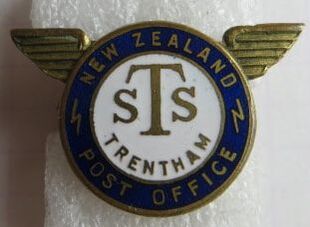
Just prior to WW2, the New Zealand Post Office moved its training facilities from Wellington, to the old Army base at Trentham in 1939. Students lived in the old WW1 Army huts while attending the course.
It seems to have operated until at least 1965 (founds from information on-line).
- Opposite - A enamel and gilt metal badge to the "New Zealand Post Office, Signals Training School, Trentham". Brooch fitting to back, with the maker mark of "Mayer & Kean, Wellington".
It seems to have operated until at least 1965 (founds from information on-line).
- Opposite - A enamel and gilt metal badge to the "New Zealand Post Office, Signals Training School, Trentham". Brooch fitting to back, with the maker mark of "Mayer & Kean, Wellington".
Fakes & Forgeries
A fake or reproduction Cap badge to the New Zealand Post & Telegraph Corps.
- Not well done to front, with pitting on the ankle and that orangey-yellow colour.
- To back is no detail, with pitting and stippling to surface. Note the large flat area at base, where the excess brass from the mold has been filed flat from the casting process.
- Two small copper looped lugs to back, which are not found on originals. They look to be soldered on.
- Size 42mm by 45mm.
- Not well done to front, with pitting on the ankle and that orangey-yellow colour.
- To back is no detail, with pitting and stippling to surface. Note the large flat area at base, where the excess brass from the mold has been filed flat from the casting process.
- Two small copper looped lugs to back, which are not found on originals. They look to be soldered on.
- Size 42mm by 45mm.
New Zealand Army Pay Corps
The corps formed as a unit in WW1, and seems to have had two branches, similar to that of the NZAOD/NZAOC discussed at the top of the page
- The New Zealand Army Pay Corps - Foreign Service branch, and part of the 1st NZEF serving overseas
- The New Zealand Pay Department - Home Service branch, based in New Zealand
Both came into existence on the 1st of April 1917.
During WW1, the two units wore different insignia.
Motto: (none in the 1st NZEF - as noted in R17187868 AALI W3508 7291 Archives NZ)
- The New Zealand Army Pay Corps - Foreign Service branch, and part of the 1st NZEF serving overseas
- The New Zealand Pay Department - Home Service branch, based in New Zealand
Both came into existence on the 1st of April 1917.
During WW1, the two units wore different insignia.
Motto: (none in the 1st NZEF - as noted in R17187868 AALI W3508 7291 Archives NZ)
New Zealand Army Pay Corps Overseas Worn Badge - 1st N.Z.E.F.
|
- Above: A gilt brass Collar badge pair to the New Zealand Army Pay Corps. D shaped copper looped lugs to back, and with the maker plaque of "J R GAUNT LONDON". Size of Collar is 31mm by 25mm.
- Opposite: A rare image of a New Zealand Soldier, 50123 Walter Thomas Roots wearing the above type NZAPC Cap badge with two British friends. Walter was a Clerk by profession, haling from Palmerston North, with his wife listed as next of kin. Upon call up (23rd April 1917), he was meant to join the 30th Infantry Reinforcements, but was assigned to the New Zealand Army Pay Corps based in Camp, reaching the rank of Staff Sergeant by the 3rd of Oct 1917. When he arrived in the UK and Sling Camp on the 10th of Dec 1917, he was reduced to ranks, i.e. a Private, like all reinforcements were upon arriving at Sling. On the 14th of Dec 1917, he was detailed or attached to Command Pay Corps in London, with the rank of Acting Sergeant. I wonder if it was then that this picture was taken (due to swagger sticks, but no rank to his sleeves). His records show that he was transferred on the 18th of Feb 1918 to the Wellington Regiment, in the field, and proceeded to France in June that year, where sadly he caught Influenza, and was hospitalised. He looks to have been attached to regimental headquarters after, with his unit, until a spell of leave in the UK in April 1919, and then his departure for New Zealand to return home on |
(continued) the 29th of May 1919. He was discharged from the NZ army on the 3rd of Aug 1919, with the rank of Corporal (though had been Acting Sergeant for some months before).
Walter went on to also serve in WW2, as part of 12th Coy, National Military Reserve, based at Palmerston North from 31st of Jan 1941 to 8th of June 1942. His service number then was 2/19a/342 (Matt Pomeroy Collection). |
WW1 New Zealand Army Pay Department - New Zealand Only.
Pictorial evidence has yet to be found of this badge being worn, but there is a mention that permission was granted for the badge to be worn by personnel attached to the training camps in New Zealand during WW1.
|
- Above: A matching pair of New Zealand Army Pay Corps (NZAPC) shoulder titles in thick gilt brass, with the maker mark of "J R Gaunt London" impressed to back.
|
- Above: A near matching pair of New Zealand Army Pay Corps (NZAPC) shoulder titles in thin, die stamped gilt brass with no maker mark, and thin Reinforcement like hex brass lugs to back.
|
One the 21st of July 1920, the New Zealand Army Pay Corps was formed in New Zealand. This would likely be an amalgamation of the existing Home Service branch with the returning personnel from the NZAPC of 1stNZEF.
It is presumed that a mixture of both badges would have been worn.
In 1930 the corps was disbanded and it is thought that it existed on paper only.
Its function would have been dispersed within the regiments and formations of the New Zealand Army at the time.
During WW2, the Corps was again reactivated and personnel assigned with the 1st NZEF badge being worn again, this time for home service personnel in New Zealand (the Onwards badge would have been worn by all overseas serving NZAPC),
Like WW1, it was reduced in strength and disbanded again after WW2, with the Corps just existing as a unit on paper.
Corbett indicates that in 1969, the corps was re-activated and the Kings crown badge continued to be worn.
In October 1978, approval was given to update the Corps badge with St Edwards Crown.
It is presumed that a mixture of both badges would have been worn.
In 1930 the corps was disbanded and it is thought that it existed on paper only.
Its function would have been dispersed within the regiments and formations of the New Zealand Army at the time.
During WW2, the Corps was again reactivated and personnel assigned with the 1st NZEF badge being worn again, this time for home service personnel in New Zealand (the Onwards badge would have been worn by all overseas serving NZAPC),
Like WW1, it was reduced in strength and disbanded again after WW2, with the Corps just existing as a unit on paper.
Corbett indicates that in 1969, the corps was re-activated and the Kings crown badge continued to be worn.
In October 1978, approval was given to update the Corps badge with St Edwards Crown.
|
- Above: A gilt metal Cap badge to the New Zealand Army Pay Corps. Two screw posts to back, no maker mark.
|
- Opposite and Above: A gilt metal Cap and Collar badge set to the New Zealand Army Pay Corps. Better made, and solid to back. All have looped lugs in a East/West configuration. None are maker marked. Size of Cap 45mm by 33mm.
|
- Above: A pair of right (when worn - note how the Lion to top faces) gilt metal Collar badges to the New Zealand Army Pay Corps. They are on their original Master and Sample cards. The NATO NSN of 8455-98-202-0751 does come back with a part number of "HC2/247/1-COLLAR-R" and details of
Codification Country: New Zealand
Item Name Code: 10024
NATO Supply Group: Clothing, Individual Equipment, and Insignia
NATO Supply Class: Badges & Insignia
National Item Identification Number: NIIN 982020751
Interestingly the Master tag also shows the acceptance date of the 20th of Oct 1993.
8455-98-202-0750 may be the left Collar badge to the NZAPC as it has a part number of HC2/247/1-COLLAR-L.
Codification Country: New Zealand
Item Name Code: 10024
NATO Supply Group: Clothing, Individual Equipment, and Insignia
NATO Supply Class: Badges & Insignia
National Item Identification Number: NIIN 982020751
Interestingly the Master tag also shows the acceptance date of the 20th of Oct 1993.
8455-98-202-0750 may be the left Collar badge to the NZAPC as it has a part number of HC2/247/1-COLLAR-L.
|
- Above: A puggaree to fit the Lemon Squeezer hat to the New Zealand Army Pay Corps. Khaki/Yellow/Khaki. Marked to inside with size only, in purple ink to "6 7/8". It is thought that these were first issued during WW2.
- Opposite: More variation in the shoulder title for the New Zealand Army Pay Corps. Note the bottom is a more modern version, with the embroidered border/edge. |
The corps was finally disbanded on the 31st of July 1993.
Fakes and Forgeries
Hopefully you don't come across this one. This is a rare badge to find in any state, but rather soul destroying when you discover its a copy. I know of one other collector who had a similar badge as this. He said he cut the lugs off his one and chucked it in the bin. One less!!!
- Detail to front is good, with just some fretting to center left not there.
- Colour is again wrong, and is a orangey-yellow, but I imagine you give it a few years and this will dull.
- To back is semi-solid, where-as the originals are die stamped, so have the reverse detail. There is some, but clearly it shows a cast badge.
- Lugs are small, and not the correct type. They are though copper and brazed on.
- Size 41mm by 39mm.
- Detail to front is good, with just some fretting to center left not there.
- Colour is again wrong, and is a orangey-yellow, but I imagine you give it a few years and this will dull.
- To back is semi-solid, where-as the originals are die stamped, so have the reverse detail. There is some, but clearly it shows a cast badge.
- Lugs are small, and not the correct type. They are though copper and brazed on.
- Size 41mm by 39mm.
New Zealand Permanent Staff
The New Zealand Permanent Staff was form in 1911, along with the New Zealand Army. Initially they took their badges from the British Staff Corps, with the Lion over the Crown as being their badge.
|
- Above: A Staff Corps Cap Badge still on part of a J R Gaunt or London Sample board. In bronze, with tangs to back in a North/South Config. Gaunts code of "F2607" is hand written to lower right corner on the cardboard. Size 41mm by 23mm.
|
- Above: Another variation of a Officers Staff Cap badge. Note a number of British regiments also wore this badge as both a Cap and Collars, and there are just variation on the tail and how many support it has. Two tangs to back, but no maker mark. Size 39mm by 26mm.
|
As WW1 progressed, New Zealand Staff Officers did personalise their uniforms with the additions of Fern Leaf Collars.

- Opposite: A darkened copper pair of Collar badges to the New Zealand Permanent Staff. Two D shaped copper looped lugs to back on each. No maker mark. Size 20mm by 45mm.

- Opposite: A gilt brass pair of Collar badges to the New Zealand Permanent Staff. In 1937, with the coronation of George VI, the NZ Army Coronation Contingent wore these same shaped Collars with a special Cap badge to the Kings Coronation ceremony. Two copper looped lugs to back. No maker mark. Size 20mm by 45mm.

- Opposite: With the Corps also deployed in the middle east during WW1, these sand cast brass Collar badges also appeared and have been associated with the New Zealand Permanent Staff Corps. Size (approx as they vary) 22.5mm by 45mm.
The following are miss-matched pairs, like everything, it is hard to find a matching set!!!

- Opposite Left: A darkened brass Collar badge to the New Zealand Permanent Staff. Wider, it has thin copper wire lugs to back. No maker mark. Size 21mm by 45mm.
- Opposite Right: Same as above, a sand cast brass Collar badge associated with the New Zealand Permanent Staff Corps. Two copper looped lugs cast into the back of the badge. Size (approx as they vary) 23mm by 46mm.
- Opposite Right: Same as above, a sand cast brass Collar badge associated with the New Zealand Permanent Staff Corps. Two copper looped lugs cast into the back of the badge. Size (approx as they vary) 23mm by 46mm.

- Opposite Left: A sand cast gilt brass Collar badge to the New Zealand Permanent Staff. Two thick copper wire loops to back. No maker mark. Size 20mm by 42mm.
- Opposite Right: A die stamped, solid backed Collar badge in gilt brass to the New Zealand Permanent Staff. Two copper looped lugs to back of the badge. No maker mark. Size 21mm by 46mm.
- Opposite Right: A die stamped, solid backed Collar badge in gilt brass to the New Zealand Permanent Staff. Two copper looped lugs to back of the badge. No maker mark. Size 21mm by 46mm.
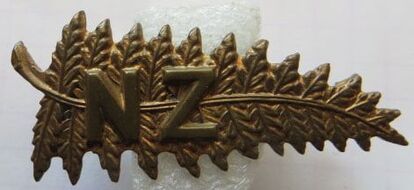
- Opposite: A coppery gilt Collar badge to the New Zealand Permanent Staff. D shaped copper looped lugs to back. No maker mark. Size 20mm by 45mm.
In 1921, approval was given to the New Zealand Permanent Staff to have their own distinctive Cap badge and Collars.
|
- Opposite: A darkened bronze Cap badge to the New Zealand Permanent Staff. Two thick looped lugs to back, but no maker mark. Size 49mm by 43mm.
- Above: Two darkened Bronze Collar badge to the New Zealand Permanent Staff. Two looped lugs to back to each, both are impressed to back to "FIRMIN LONDON". Size 31mm by 25mm. |
|
The Kings Crown New Zealand Permanent Staff Cap Badge and Collars are still worn today.
- Opposite and Above: A modern darkened copper Cap and Collar badge set to the New Zealand Permanent Staff. The Cap badge has two screw threads to be used with nuts to back, while the Collars have pins and clutches. None are maker marked. Cap size 49mm by 41mm, Collar size 30mm by 27mm. |
|
- Above Left: A darkened brass Collar badge (right when worn) to the New Zealand Permanent Staff. Two D shaped looped lugs to back, and maker impress to "DOWLER BIRMINGHAM". Size 30mm by 26mm.
- Above Right: A darkened copper Collar badge to the New Zealand Permanent Staff. Two thick copper wire lugs to back, with no maker mark. Size 32mm by 26mm. |
-Above: A pair of small Officers shoulder titles to the New Zealand Permanent Staff Corps. No maker mark to back, with two D shaped copper loops. Size 11mm by 46mm.
|
|
- Above Left: A 24mm Gilt brass button to the New Zealand Permanent Staff. Maker marked to back to "Buttons Ltd, Birmingham".
(Made in the same size by "Smith & Wright Ltd, Birmingham" with fixed shank). - Above Center: A 20mm Gilt brass button to the New Zealand Permanent Staff. Maker marked to back to "Buttons Limited, Birmingham". - Above Right: A 16mm Gilt brass button to the New Zealand Permanent Staff. Maker marked to back to "Buttons Ltd, B'ham". |
- Above: A darkened 24mm, fixed shank brass button to the New Zealand Permanent Staff. Maker marked to back to "Smith & Wright Ltd, Birmingham".
|
Other sizes and makers of NZ Permanent Staff Buttons (B Jones collection);
13mm "Buttons Limited" (has crossed swords emblem), 15.5mm "Buttons Ltd B"Ham", 16.3mm "Buttons B"Ham", 16.5mm "Buttons B"Ham" (blackened brass), 16.5mm "Buttons Ltd" (gilt), 20mm "Buttons Limited Birmingham",20.4mm "Buttons Limited Birmingham" (gilt), 24mm "Buttons Birmingham Limited", 24mm "Smith & Wright Ltd Birmingham" (blackened brass)
13mm "Buttons Limited" (has crossed swords emblem), 15.5mm "Buttons Ltd B"Ham", 16.3mm "Buttons B"Ham", 16.5mm "Buttons B"Ham" (blackened brass), 16.5mm "Buttons Ltd" (gilt), 20mm "Buttons Limited Birmingham",20.4mm "Buttons Limited Birmingham" (gilt), 24mm "Buttons Birmingham Limited", 24mm "Smith & Wright Ltd Birmingham" (blackened brass)

- Opposite: A puggaree to fit the Lemon Squeezer hat to the New Zealand Permanent Staff Corps. Red/Red/Red. Marked to inside with size only, in purple ink to "7".
Note this puggaree colour combination has also be used by:
- Ceremonial or Honor Guard.
- EIIR Coronation Contingent
Note this puggaree colour combination has also be used by:
- Ceremonial or Honor Guard.
- EIIR Coronation Contingent
Fakes & Forgeries
|
- Above & Opposite: I don't like showing the backs of original badges, but it is impossible to describe which is original and which is fake without showing the two side by side for this badge.
Left is the original badge, Right is the fake or reproduction. - The front of the fake lacks the detail, and note the finish which is a duller tone to the original compared to the shiny fake. - But the most distinguishing sign of a fake is the back, which if you see on the original has a maltese cross like shape, impressed to back. The fake is incomplete to the edges due to the casting process. - Note the lugs are smaller on the fake compared to the original. - Size of fake 49mm by 41mm. |
New Zealand Staff Corps
The New Zealand Staff formed in 1911, and was the Staff Corps for the New Zealand Territorial Forces.
In times of war, it merged with the New Zealand Permanent Staff Corps, as it did so during WW1 and WW2.
In times of war, it merged with the New Zealand Permanent Staff Corps, as it did so during WW1 and WW2.
|
- Above: A darkened semi-solid bronze Officers Cap badge to the New Zealand Staff Corps. Two blades or tangs to back, with maker mark impressed to "J R Gaunt London".
|
- Above: A matching pair of semi-solid bronze Collar badges to the New Zealand Staff Corps. Both have two D shaped copper loops to back and a maker impressed mark to "J R Gaunt London".
|
|
- Above: A gilt fired Collar to the New Zealand Staff Corps. Semi-solid, with two D shaped looped lugs to back and the maker mark impressed to "Firmin London"
|
- Above: A darkened semi-solid bronze Collar badge to the New Zealand Staff Corps. Two copper D shaped lugs to back and the impressed details to Dowler Birmingham".
|
During WW2, the New Zealand Temporary Staff was set up to augment the Permanent and NZ Staff Corps. It existed from 1939 to 1945.
The badges themselves were also worn (unofficially) by other units, as the fern is New Zealand national symbol.
The badges themselves were also worn (unofficially) by other units, as the fern is New Zealand national symbol.
- Above: A Cap and Collar badge set to the New Zealand Temporary Staff. Note you can find these in Brass or darkened copper, with some having longer lugs to back than others, maybe indicating a Cap badge opposed to a Collar. The two pointing to the right are maker marked to back to "M & K Ltd", for Mayer & Keane Limited, who were based in Wellington. All have thick copper looped lugs, and size is 18mm by 42mm.
- Above: A group of mainly 3rd (Auckland) Infantry NCO's on some steps in New Zealand at some stage during WW2. Note the chap on the left, back, who is also a WW1 veteran, with ribbons to his chest. He is also wearing the New Zealand Temporary Staff Cap and collars. The Staff Sergeant on the far right, front row is also wearing a crossed rifles Marksman sleeve badge on his right sleeve in cloth.
|
- Above: A Cap or Collar badge in darkened copper to the New Zealand Temporary Staff. Two hex type copper lugs to back. No maker mark and 18mm by 42mm in size.
|
- Above: A Cap or Collar badge in gilt brass to the New Zealand Temporary Staff. Two pressed type brass lugs to back. No maker mark and 19mm by 42mm in size.
|
- Above: A Cap or Collar badge in gilt brass to the New Zealand Temporary Staff. Two thin wire copper lugs to back. No maker mark and 19mm by 41.5mm in size.
|
|
- Above: Three gilt brass shoulder titles to the New Zealand Staff Corps. All are one piece, but have different shaped hex brass lugs to back. One is maker marked to back to "J R GAUNT LONDON"
- Opposite: A image of a pre-WW1 or WW1 Officer in the New Zealand Engineers. He is wearing his Sam Brown cross-strap over his shoulder. Note his shoulder strap, which has a "NZ STAFF" shoulder title in gilt brass. I presume he is "attached" to the Staff Corps. Also what is unusual is his collar badges, which are a large flaming grenade, which you would expect to have a "banner" to base, but they don't (Auckland Libraries Heritage Collections 7003-543). |
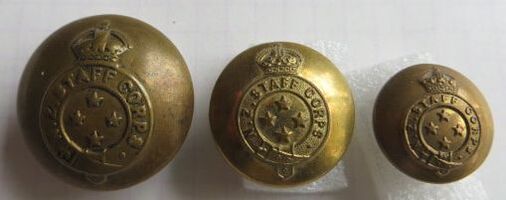
- Opposite Left: A 25mm gilt brass button to the New Zealand Staff Corps. Maker marked to "J R Gaunt & Son Ltd. London, Engld."
- Opposite Center: A 19mm gilt brass button to the New Zealand Staff Corps. Maker marked to "J R Gaunt & Son Ltd. London, Engd."
- Opposite Left: A 16mm gilt brass button to the New Zealand Staff Corps. Maker marked to "J R Gaunt & Son Ltd. London, Engd."
- Opposite Center: A 19mm gilt brass button to the New Zealand Staff Corps. Maker marked to "J R Gaunt & Son Ltd. London, Engd."
- Opposite Left: A 16mm gilt brass button to the New Zealand Staff Corps. Maker marked to "J R Gaunt & Son Ltd. London, Engd."
Fakes & Forgeries
Below is a fake or reproduction Temporary Staff Cap or Collar badge.
- Detail to front is OK, but the colour is wrong and a orangey-yellow.
- To back, it lacks all reverse detail, with pitting and holes in the metal.
- Two small copper lugs to back, which are not found on the originals.
- Size is 18mm by 41.5mm.
- Detail to front is OK, but the colour is wrong and a orangey-yellow.
- To back, it lacks all reverse detail, with pitting and holes in the metal.
- Two small copper lugs to back, which are not found on the originals.
- Size is 18mm by 41.5mm.
New Zealand Veterinarian Corps
New Zealand Army Veterinarian Service was formed in 1906 from Volunteer Officers.
The Corps was formed in 1907, and at was not only responsible for selecting the Horses which were to accompany the NZ Soldiers overseas, but also the health and well-being once the animals arrived in the Middle East.
Three Veterinarians were initially sent with the Main Body, which left NZ in October 1914.
Subsequently two "Mobile Veterinarian Section"s of 28 men were formed in NZ, and then sent onto Egypt, to assist. One for the New Zealand Mounted Rifles, and one for the New Zealand Infantry.
After the withdrawal from Gallipoli and the formation of the New Zealand and ANZAC Divisions in April 1916. these two New Zealand Mobile Veterinarian Section were initially disbanded and then reformed into larger units, with one based in the Milddle East, while the other seeing action in France and the Western Front.
Cap Badge - On the 10th of July 1911, their badge was approved and described as a "Badge of the A.V.C substituting the monogram "N.Z.V.C" i.e. monogram of N.Z.V.C. surmounted by an oak-leaf wreath & surmounted by a crown".
Collar Badge - "Smaller".
(Badges - Regimental - Territorial Force, R23534556 AD1 AAYS 13-13 Archives NZ).
Further to the above, another file indicates
"Badge - Within a oak wreath, surmounted by a crown the monogram "N.Z.V.C".
Dress Badge - Similar design in gilt with monogram in white metal.
Crest - Crown surmounting an eight point star bearing the words "New Zealand Veterinary Corps" and Royal Cypher".
(Cadets, Regimental Badges and Uniforms R21078962 Box 19 AD37 24 c1912 Archives N.Z.).
Motto: (none in the 1st NZEF - as noted in R17187868 AALI W3508 7291 Archives NZ)
The Corps was formed in 1907, and at was not only responsible for selecting the Horses which were to accompany the NZ Soldiers overseas, but also the health and well-being once the animals arrived in the Middle East.
Three Veterinarians were initially sent with the Main Body, which left NZ in October 1914.
Subsequently two "Mobile Veterinarian Section"s of 28 men were formed in NZ, and then sent onto Egypt, to assist. One for the New Zealand Mounted Rifles, and one for the New Zealand Infantry.
After the withdrawal from Gallipoli and the formation of the New Zealand and ANZAC Divisions in April 1916. these two New Zealand Mobile Veterinarian Section were initially disbanded and then reformed into larger units, with one based in the Milddle East, while the other seeing action in France and the Western Front.
Cap Badge - On the 10th of July 1911, their badge was approved and described as a "Badge of the A.V.C substituting the monogram "N.Z.V.C" i.e. monogram of N.Z.V.C. surmounted by an oak-leaf wreath & surmounted by a crown".
Collar Badge - "Smaller".
(Badges - Regimental - Territorial Force, R23534556 AD1 AAYS 13-13 Archives NZ).
Further to the above, another file indicates
"Badge - Within a oak wreath, surmounted by a crown the monogram "N.Z.V.C".
Dress Badge - Similar design in gilt with monogram in white metal.
Crest - Crown surmounting an eight point star bearing the words "New Zealand Veterinary Corps" and Royal Cypher".
(Cadets, Regimental Badges and Uniforms R21078962 Box 19 AD37 24 c1912 Archives N.Z.).
Motto: (none in the 1st NZEF - as noted in R17187868 AALI W3508 7291 Archives NZ)
|
- Above: An early, darkened Bronze Officers Cap Badge to New Zealand Veterinarian Corps, with Laurel Boarder. Two blades or tangs to back (though one is missing), with maker plaque for "FIRMIN, LONDON" to back of crown.
|
- Opposite and Above: A darkened Bronze Officers Cap and Collar badge pair to the New Zealand Veterinarian Corps.
|
(continued) Note the Fern leaf wreath. The Cap has two tangs to back, while the Collars have D shaped copper looped lugs. No maker mark to either. The Collars are also quiet a rough cast to back.
|
I do not have a example of a gilt with white metal overlay as per the description of the "Dress badge". Both types are extremely rare.
Initially when the Other Ranks arrived in Egypt for the New Zealand Veterinarian Corps, they worn no badge. Unofficially they approached local Egyptian manufacturers who made the below for the men sometime in 1915.
Initially when the Other Ranks arrived in Egypt for the New Zealand Veterinarian Corps, they worn no badge. Unofficially they approached local Egyptian manufacturers who made the below for the men sometime in 1915.
|
- Opposite and Above: A pair of Cap badges to the New Zealand Veterinarian Corps. The "17" is the Corps number,, and is beneath the crown on the opposing badge. It has a long brass slider cast into the back. The above badge is a "cut-down version", with wreath and crown removed. Two wire loops have been soldered to back, behind the lower bottom scroll.
|
|
- Above: The Collar badges for the above Cap badge in Cast brass to the New Zealand Veterinarian Corps. The right collar was also worn as a Cap badge. They have brass ribbon like lugs cast into the back of the badge. The left has a replaced copper wire lug, just seen in the back of the picture.
|
- Above: A similar pair of cast brass collar badges to the New Zealand Veterinarian Corps. Note the right has a brooch fitting to back (Ian Hamilton Collection).
|
|
- Above: A Pair of gilt brass Cap badges to the New Zealand Veterinarian Corps. Both are maker marked to back with a small plaque to crown to "J R GAUNT LONDON". Note the right has a non-void crown. Both have copper looped lugs.
|
- Above: A pair of other ranks, gilt brass Collar badge to the New Zealand Veterinarian Corps. Both have maker plaques to back to "J R GAUNT LONDON", along with two D shaped copper looped lugs.
|
|
- Opposite: A single piece, gilt brass cap badge to the New Zealand Veterinarian Corps. No maker mark, with two copper looped lugs. This badge has been heavily lacquered, which preserves the gilt, but yellows with age.
- Above: A selection of shoulder titles to the New Zealand Veterinarian Corps (N.Z.V.C). - Top Pair: A die stamped gilt brass shoulder title pair to the New Zealand Veterinarian Corps. Maker impressed to back of the "Z" to "J R Gaunt, London". - Bottom Pair: A pair of thin gilt brass shoulder title with hex type lugs to back to the New Zealand Veterinarian Corps. No maker mark, and these look hand made. |
|
- Above: A cast brass shoulder title to the New Zealand Veterinarian Corps. Hex lugs to back, with no maker mark.
|
|
In 1947, the New Zealand Veterinarian Service was disbanded.
Fakes and Forgeries
Below is a fake or reproduction New Zealand Veterinarian Corps Cap badge
- Colour to front is wrong, and a orangey-yellow, but detail is also lacking.
- To back is some detail, but the bottom edge, right, has a flat area, which shows the badge is cast, and this is here the excess brass has been filed off. The Gaunt maker plaque, which is on the original, and has been cast to the back of the crown, also has no detail or maker mark.
- Two ribbon copper looped lugs are to back.
- Size 43mm by 32.5mm.
- Colour to front is wrong, and a orangey-yellow, but detail is also lacking.
- To back is some detail, but the bottom edge, right, has a flat area, which shows the badge is cast, and this is here the excess brass has been filed off. The Gaunt maker plaque, which is on the original, and has been cast to the back of the crown, also has no detail or maker mark.
- Two ribbon copper looped lugs are to back.
- Size 43mm by 32.5mm.
New Zealand Special Air Service
The New Zealand Special Air Service started out as part of the British 22nd Special Air Service Regiment in 1955. in 1959, it became a separate Corps of the New Zealand Army.
In 1963 its title changed to the 1st Ranger Squadron, New Zealand Special Air Service.
In April 1978, its title reverted back to 1 New Zealand Special Air Service Squadron.
Motto: WHO DARES WINS.
In 1963 its title changed to the 1st Ranger Squadron, New Zealand Special Air Service.
In April 1978, its title reverted back to 1 New Zealand Special Air Service Squadron.
Motto: WHO DARES WINS.
|
- Above : A Silver bullion and thread Beret badge to the 1 New Zealand Special Air Service Squadron. No maker mark to back.
|
- Above: A well worn other ranks woven Beret badge to the 1 New Zealand Special Air Service Squadron. No maker mark to back.
|
- Above: A pair of Gilt fired brass and Silver collar badges to the 1 New Zealand Special Air Service Squadron. Two looped lugs to back, but no maker mark to back.
|
|
- Above: A 25mm, anodised aluminium or staybrite silver toned button to the New Zealand Special Air Service Squadron. Brass backed, it has a fixed shank and is marker marked to "Firmin London".
- Opposite: A pair of non-matching cloth shoulder titles to the 1 New Zealand Special Air Service Squadron. The top set is a older style, with paper backing and maybe faded lettering. The bottom set has a cloth backing material and feels a more modern manufacture. |
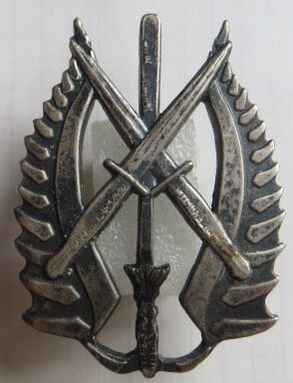
The Counter Terrorist Tactical Assault Group (CTTAG) was set up in December 2005 to augment the Counter Terrorist (CT) role the 1st NZ Special Air Service Group already maintained. The opposite is the 1st patterned badge, adopted in 2008, and represents the trinity or "tri-service" capability.
2nd Pattern appears to be non-void to center. There is also apparently a cloth version.
- Opposite: A 1st pattern Cap badge to the New Zealand Counter Terrorist Tactical Assault Group. Made from a silver metal, solid to back, it has two screw posts to back and a maker mark, which sadly I can't make out.
Smaller versions are worn as collar badges in the same design.
2nd Pattern appears to be non-void to center. There is also apparently a cloth version.
- Opposite: A 1st pattern Cap badge to the New Zealand Counter Terrorist Tactical Assault Group. Made from a silver metal, solid to back, it has two screw posts to back and a maker mark, which sadly I can't make out.
Smaller versions are worn as collar badges in the same design.
New Zealand Physical Training Corps
The New Zealand Physical Training Corps formed initially during WW1 as the NZ Physical Training Staff. This would last until June 1987, when it finally became a Corps.
|
- Opposite & Above: A WW1 era Cap and Collars to the New Zealand Physical Training Staff. All three badges are in gilt brass, though one of my Collars is tarnished/toned to front. Note the slight variation in die between the two Collars, with a void area below the crown. All have thin Copper wire lugs to back, and not maker marked. Cap size is 46mm by 58mm, Collar size is 33mm by 40mm.
|
In 1995 a distinctive New Zealand badge was again re-introduced for wear.
|
- Above: Two types of Physical Training Corps Sleeve Trade badges in Brass. Worn by both the Kiwi's and British Corps. Top is a Cast brass example with three looped lugs to back. Bottom is a die stamped brass type, with two copper looped lugs to back.
|
- Above: A silver finished, metal Cap badge to the New Zealand Physical Training Corps. It has 4 pins and clutches to back, and is not maker marked.
Cap size 35mm by 39mm. |
|
- Above: Modern shoulder titles to the New Zealand Army Physical Training Corps. Note the raised edge to all, but just differing sizes.
|
- Above Left: A 19mm, silver tone, anodised aluminium fixed shank button to the Royal NZ Physical Training Corps. Maker marked to back to "LONDON BADGE & BUTTON".
- Above Middle: A 17mm, silver tone, anodised aluminium fixed shank button to the Royal NZ Physical Training Corps. Maker marked to back to "LONDON BADGE & BUTTON". - Above Right: A 14mm, silver tone, anodised aluminium fixed shank button to the Royal NZ Physical Training Corps. Maker marked to back to "GAUNT LONDON". |
New Zealand Defence Security Guards.
The following are badges worn by civilian personnel deployed for security after WW2, around certain New Zealand Defence buildings.
|
- Opposite and Above: Two examples of the Tudor Crown which was approved for wear in 1949. Red enamel on gilt brass. The left has a slider attachment, with the maker mark of "MAYER & KEAN WELLINGTON" stamped to the slider. Size 31mm by 30mm. Above is slightly smaller, and looks to have had a slider at one stage to back, but now replaced with two wire lugs. Size 28mm by 28mm.
|
|
- Above: In 1954 the St Edwards crown was adopted. Above is a gilt brass and red enamel Cap badge. Two looped lugs to back, in a East/West configuration. No maker mark and size 31mm by 35mm.
|
- Above: A rare Collar badge with Queens crown, worn by NZ Defence Security Guards. Red Enamel, Gilt brass and Sterling Silver backing. Two copper looped lugs to back. Maker marked to "BOCK" and "STG. SIL". Size 31mm by 42mm. They don't appear to be opposing, so two of the same were worn.
|
Corps of Commissionaires
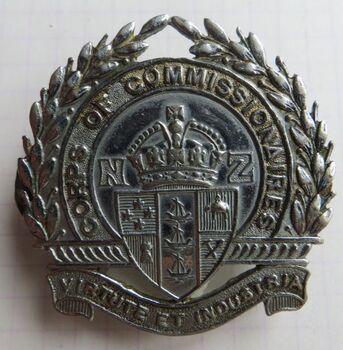
The Corps of Commissionaires was a global movement in Commonwealth countries which established societies or organisations who's role was to created and provide meaningful employment for veterans of the armed services.
It traces its origins to 1859, when Captain Sir Edward Walter KCB organised seven disabled veterans of the Crimean War and Indian Mutiny to act as nightwatchmen.
Countries like Canada and the United Kingdom still have these organisations working as private security firms today.
Motto: VIRTUTE ET INDUSTRIA (Virtue and industry).
- Opposite: A New Zealand, Kings crowned badge to the Corps of Commissionaires. Heavy, chromed metal, with two thread posts and nuts to back. No maker mark.
It traces its origins to 1859, when Captain Sir Edward Walter KCB organised seven disabled veterans of the Crimean War and Indian Mutiny to act as nightwatchmen.
Countries like Canada and the United Kingdom still have these organisations working as private security firms today.
Motto: VIRTUTE ET INDUSTRIA (Virtue and industry).
- Opposite: A New Zealand, Kings crowned badge to the Corps of Commissionaires. Heavy, chromed metal, with two thread posts and nuts to back. No maker mark.
New Zealand Officers Training Corps
|
- Above: A darkened bronze Cap badge to the Otago University Medical Company (OTC). Two copper looped lugs to back in a North/South configuration. No maker mark.
|
- Above: A darkened brass Cap badge to the Otago University Medical Company (OTC). Two small copper looped wire lugs to back in a East/West configuration. No maker mark.
|
- Above: A gilt brass Cap badge to the Otago University Medical Company (OTC). Two copper looped lugs to back in a North/South configuration. No maker mark.
|
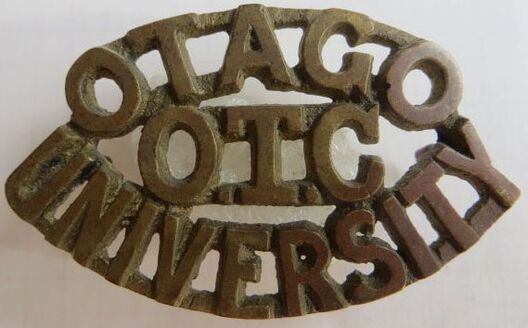
Throughout New Zealand Defence Force history, New Zealand Universities have provided places to recruit, train and promote training for Officers and Enlistedmen. Over the years a number of Universities have had their own Officer Training Corps' (OTC's). Shoulder titles exist for Canterbury University OTC, Victoria Collage (Now Victoria University - Wellington) and opposite, Otago University OTC (Dunedin).
Formed in 1915 to supply Medical and Dental Officers during WW1. It was absorbed into the New Zealand Medical Corps in October 1927.
- Opposite: A cast brass shoulder title to the Otago University Officer Training Corps (O.T.C). No maker mark, and with two copper looped lugs to back.
Formed in 1915 to supply Medical and Dental Officers during WW1. It was absorbed into the New Zealand Medical Corps in October 1927.
- Opposite: A cast brass shoulder title to the Otago University Officer Training Corps (O.T.C). No maker mark, and with two copper looped lugs to back.
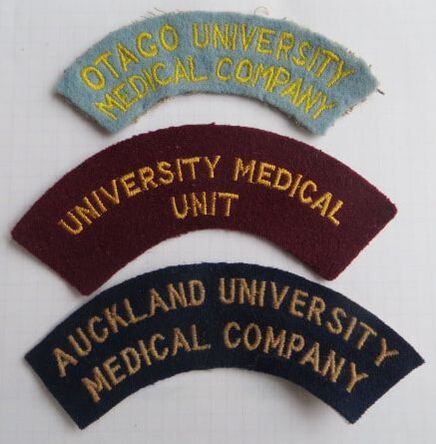
Opposite are a section of University medical Company shoulder titles.
- Top: A yellow thread on light blue shoulder title to the Otago University Medical Company, based in Dunedin.
- Center: A unknown shoulder title to a University Medical unit. Gold embroidered thread on a maroon background.
- Bottom: A cloth shoulder title to Auckland University Medical Company. Yellow threads on a purple background.
- Top: A yellow thread on light blue shoulder title to the Otago University Medical Company, based in Dunedin.
- Center: A unknown shoulder title to a University Medical unit. Gold embroidered thread on a maroon background.
- Bottom: A cloth shoulder title to Auckland University Medical Company. Yellow threads on a purple background.
Sergeant-Major of the Army/Regimental Sergeant Major
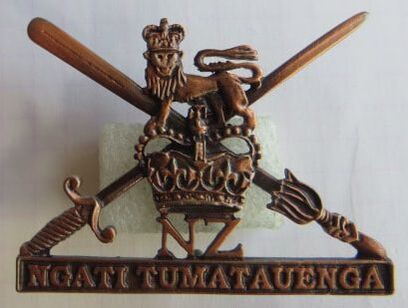
In the 1990's there was a move to create a universal Cap and Collar badge for the New Zealand Army. This would have been along the lines of the WW2 and J Force "ONWARDS" cap badge, and would replace all the regimental and corps badges.
The move was deeply unpopular and eventually abandoned.
The proposed badge opposite was instead adopted by the Sergeant-Major of the Army, and Regimental Sergeant Majors.
Motto: NGATI TUMATAUENGA (Tribe of the God of War).
- Opposite: Initially the badge was produced with a straight scroll. Shown here is a Cap badge, in copper coloured metal. No maker mark to back, and with two screw posts to back in a North/South config. Collars were also produced and have the same straight scroll, but I have yet to obtain. Size 35mm by 46mm.
The move was deeply unpopular and eventually abandoned.
The proposed badge opposite was instead adopted by the Sergeant-Major of the Army, and Regimental Sergeant Majors.
Motto: NGATI TUMATAUENGA (Tribe of the God of War).
- Opposite: Initially the badge was produced with a straight scroll. Shown here is a Cap badge, in copper coloured metal. No maker mark to back, and with two screw posts to back in a North/South config. Collars were also produced and have the same straight scroll, but I have yet to obtain. Size 35mm by 46mm.
New Zealand War Correspondents

New Zealander reporters have been with New Zealand troops, reporting on all conflicts they served in. They mainly wore the British badges on their uniform as War Correspondents, but there are some slight exceptions.
- Opposite: A superb image of 9532 Graham Evenson Beamish in the Libyan desert during World War 2. He left with the 3rd Echelon, as a 2nd Lieutenant, attached to the 27th (Machine Gun) Battalion. Presumably he went back to his pre-war profession, which was a reporter in Christchurch.
Photo was taken in 1941, and note his shoulder boards which have separate metal "NZ" above a "WAR/CORRESPONDENT" title, on a dark green background.
Below is a cloth, white on black "NEW ZEALAND" title sewn onto the top of the sleeve. Note also the side-hat to table top, with a "ONWARDS" cap badge, and a British Steel Helmet, upside down, beside it (New Zealand war correspondent G E Beamish in the Libyan desert during World War 2. New Zealand. Department of Internal Affairs. War History Branch :Photographs relating to World War 1914-1918, World War 1939-1945, occupation of Japan, Korean War, and Malayan Emergency. Ref: DA-02203-F. Alexander Turnbull Library, Wellington, New Zealand. /records/23101159).
- Opposite: A superb image of 9532 Graham Evenson Beamish in the Libyan desert during World War 2. He left with the 3rd Echelon, as a 2nd Lieutenant, attached to the 27th (Machine Gun) Battalion. Presumably he went back to his pre-war profession, which was a reporter in Christchurch.
Photo was taken in 1941, and note his shoulder boards which have separate metal "NZ" above a "WAR/CORRESPONDENT" title, on a dark green background.
Below is a cloth, white on black "NEW ZEALAND" title sewn onto the top of the sleeve. Note also the side-hat to table top, with a "ONWARDS" cap badge, and a British Steel Helmet, upside down, beside it (New Zealand war correspondent G E Beamish in the Libyan desert during World War 2. New Zealand. Department of Internal Affairs. War History Branch :Photographs relating to World War 1914-1918, World War 1939-1945, occupation of Japan, Korean War, and Malayan Emergency. Ref: DA-02203-F. Alexander Turnbull Library, Wellington, New Zealand. /records/23101159).
|
- Above: A large, and likely British, single piece, gilt brass shoulder title for a "WAR CORRESPONDENT". Maybe for greatcoat? No maker mark, with two copper looped lugs to back and size 33mm by 78mm.
|
- Above: A Lemon Squeezer with the pugaree of Green/Green/Green. Introduced in 1941 and worn by New Zealand War Correspondents.. It has a New Zealand "ONWARDS" Cap badge to front (Image from the internet).
|
Public Relations Officer
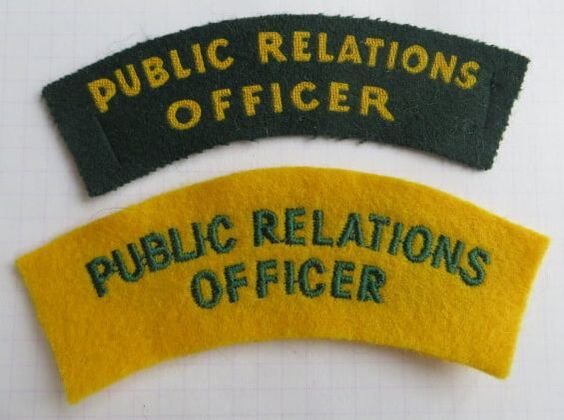
Like any modern day organisation, the New Zealand Army also needs to deal with the Public and media. I know little about the unit, but when collecting I have come across these two titles.
- Top: A Public Relations Officers title, with printed Indian yellow letters on a Rifle Green background.
Bottom: A Public Relations Officers title, but reverse colours, with Rifle Green embroidered letters on a Indian yellow background.
- Top: A Public Relations Officers title, with printed Indian yellow letters on a Rifle Green background.
Bottom: A Public Relations Officers title, but reverse colours, with Rifle Green embroidered letters on a Indian yellow background.
Young Men's Christian Association (Y.M.C.A)
The Young Men's Christian Association or Y.M.C.A. played a major role in WW1 (and WW2) for New Zealand Soldiers, both near the fronts in France, Belgium and around the camps in the Middle East, but also while the men trained in New Zealand or convalesced in the UK .
The Y.M.C.A "Huts" were run by Field Secretaries, who were basically lay preachers of various non-denominational faiths not represented by the official Chaplains, Baptists, and the likes. They worked in the huts in the NZ Camps, accompanied the troops on the troopships and then in the huts in the UK camps and also served in the field in France and in the Middle East.
They would dole out tea and biscuits at the front, provide a place to sit, write (even the stationary to do so) in France and Belgium, to the point where several were wounded. They were granted permission to wear a uniform, and then in around late 1916 the hierarchy of the New Zealand Expeditionary Force decided to attest them into the New Zealand Army, purely from a logistical point of view, so that they had control over them and their movements.
Approximately a force of some 45 Field Secretaries served overseas during WW1.
The Y.M.C.A "Huts" were run by Field Secretaries, who were basically lay preachers of various non-denominational faiths not represented by the official Chaplains, Baptists, and the likes. They worked in the huts in the NZ Camps, accompanied the troops on the troopships and then in the huts in the UK camps and also served in the field in France and in the Middle East.
They would dole out tea and biscuits at the front, provide a place to sit, write (even the stationary to do so) in France and Belgium, to the point where several were wounded. They were granted permission to wear a uniform, and then in around late 1916 the hierarchy of the New Zealand Expeditionary Force decided to attest them into the New Zealand Army, purely from a logistical point of view, so that they had control over them and their movements.
Approximately a force of some 45 Field Secretaries served overseas during WW1.
|
- Above & Opposite: Two images of Montague William Percy Lascelles (Left in both images) and his son, 52765 Arthur Montague Lascelles (Right in both images). Both are wearing all brass YMCA Cap badges to their hats. Note both also have a YMCA cloth patch on their right sleeve only. I presume a Red triangle on a dark background (blue or black), and letters in white of "Y.M.C.A". The top image was taken by Crown Studio's of Auckland, and I presume is pre June 1917. Arthur looks to have left NZ for England from July 1917 to August 1918, and then France. In France he then volunteered to stay on (without pay) from August 1918 to June 1919 as Y.M.C.A Field Secretary.
|
(continued) His father, Montague was a Special YMCA Commissioner, touring and giving talks on the war and its progress (images from the Auckland Cenotaph website).
|
- Above: A image taken from the NZ YMCA produced “The Triangle Trail”, what is now an extremely rare monthly magazine from 1918/19. The image states that it is of the "New Zealand Secretaries at Midmay, Oct 14, 1917.". Sadly no head gear being worn, but note the Collar badges, which are the Triangle of the Y.M.C.A. (Matt Pomeroy Collection).
|
- Above and opposite: Sadly a unknown and undated photograph of a New Zealand Y.M.C.A. Field Secretary in uniform with Lemon Squeezer, with a Dark Blue/White/Dark Blue Puggaree. Note the Cap badge and Collars, which appear to be a simple brass Triangles, with the word "Y.M.C.A" through the top (Matt Pomeroy Collection).
|
An article appeared in the Evening Post on 15th of March 1918, page 8, indicating the "Approval" for the uniform of the New Zealand Y.M.C.A's Field Secretaries as follows:
"APPROVED FOR "Y.M." FIELD SECRETARIES.
The existing service dress regulations for field secretaries of the Y.M.C.A. serving with the New Zealand Expeditionary Force have been cancelled, and the following substituted:
- Hat (or cap): Field service dress with triangle badge of Y.M.C.A. worn on the puggaree. The puggaree to be dark blue with white center. Cap, service dress with badge of Y.M.C.A. worn in front.
- Jacket: Service dress open-breasted pattern as for officers with "New Zealand" on shoulder straps and with triangle badges of Y.M.C.A. on the lower lapels of the jacket.
- Trousers: Service dress.
- Great coat: Service dress khaki as for rank and file.
- Putties: Service dress.
- Waist belt:, Brown .leather "Sam. Brown" but without shoulder straps.
The above uniform will not be provided by the Defence Department, but caps, hats, jackets, trousers, great coat, and putties may be obtained from Ordnance Stores on pre-payment.
The effect of the new regulations is to give Y.M.C.A. field secretaries practically the same dress as that for officers of the N.Z.E.F., with, however special distinguishing Y.M.C.A. marks in order that they may not be mistaken for officers."
"APPROVED FOR "Y.M." FIELD SECRETARIES.
The existing service dress regulations for field secretaries of the Y.M.C.A. serving with the New Zealand Expeditionary Force have been cancelled, and the following substituted:
- Hat (or cap): Field service dress with triangle badge of Y.M.C.A. worn on the puggaree. The puggaree to be dark blue with white center. Cap, service dress with badge of Y.M.C.A. worn in front.
- Jacket: Service dress open-breasted pattern as for officers with "New Zealand" on shoulder straps and with triangle badges of Y.M.C.A. on the lower lapels of the jacket.
- Trousers: Service dress.
- Great coat: Service dress khaki as for rank and file.
- Putties: Service dress.
- Waist belt:, Brown .leather "Sam. Brown" but without shoulder straps.
The above uniform will not be provided by the Defence Department, but caps, hats, jackets, trousers, great coat, and putties may be obtained from Ordnance Stores on pre-payment.
The effect of the new regulations is to give Y.M.C.A. field secretaries practically the same dress as that for officers of the N.Z.E.F., with, however special distinguishing Y.M.C.A. marks in order that they may not be mistaken for officers."
- Above: This is a very rare image indeed. It comes from a Y.M.C.A album which is held by New Zealand National Army Museum. The album is WW1, but sadly the images contained within, are not dated. This above image shows two Field Secretaries (back row, 2nd and 3rd from the left) wearing their Dark Blue/White/Dark Blue Puggarees and the type 2 New Zealand Y.M.C.A. Cap and Collar badges (shown further below). Location is possibly Sling Camp in the UK, late 1918. (National Army Museum of New Zealand collection)
- Above: An image of a group of Y.M.C.A Field Secretaries, taken in the UK in July 1919. Note they are all wearing the type 2, New Zealand Y.M.C.A Collar badges, and though we can't quite see the Cap badge on the Lemon Squeezer held in the front row, it has the Dark Blue/White/Dark Blue Puggaree band to it (Matt Pomeroy collection).
|
- Above: A type 2, solid backed, bronze NZ YMCA Field Secretaries Cap badge with tangs or blades to back. Maker impressed to lower back to "J R GAUNT LONDON". The badge has been lacquered to front, which has turned yellow with age. Size 41.5mm by 44mm.
|
- Above: A type 2 single piece, darkened copper and red painted Cap badge to the NZ YMCA. Copper looped wire lugs to back, though this is missing one. No maker mark. Collars also appear to have been made, and painted red to the triangle. Size 40mm by 44mm.
|
- Above: A type 2 sand cast NZ YMCA Cap badge, probably made in the Middle East, which YMCA personnel were stationed during WW2. Two copper looped lugs cast into the back. Size 39mm by 42mm.
|
|
- Above: A type 2 solid backed, bronze collar badge to the NZ YMCA. Right when worn, with two copper looped lugs. No maker mark. Size 29.5mm by 30.5mm.
|
- Above: A darkened type 2, bronze NZ YMCA Collar badge. Left when worn. Impressed to lower back to "J R Gaunt London". Two D shaped copper looped lugs to back. Size 32mm by 29mm.
|
- Above: A pair of hand-cut Shoulder titles in sheet brass to the YMCA. Two copper looped lugs to back, but no maker mark. Size 15mm by 44mm.
|
Note a Young & Co marked Cap and Collar badge set in type 2 have also been sighted, they have red enamel triangles to front, with blue enamel to the backing of the "Y.M.C.A". The set also came with a "NZ" over "Y.M.C.A" title.
|
- Above: A small Silver (hallmarked - Anchor & Lion for Birmingham and U for 1919) and enamel brooch to the New Zealand Y.M.C.A. Type 2 style badge to front, with the red triangle and "Y.M.C.A" on a black enamel background. Note the Blue to "NEW ZEALAND" to base. Maker marked to "W.J.D" to back. Size of badge 20mm by 18mm.
|
- Above: A small brass and enamel button-hole badge to the Y.M.C.A. Some damage to the enamel to front, and sadly no maker mark to back. Size of badge 14mm by 15mm.
|
|
- Above: A example of YMCA writing paper provide to troops. Here its to Arthur, who was writing home on the 10th of March 1917 from Featherston Military Camp in NZ to girlfriend Gris, who was in Christchurch.
- Opposite: A small waterproof material wallet given out or purchased at the NZ YMCA Huts in France. It has a date of 1918 impressed, and contained two small German paper note coins, both dated 1917. |
|
- Above: A image and caption from the Wanganui Chronical, dated the 18th of March 1940 with the following:
"Y.M.C.A. field secretaries who are going overseas with the Second Echelon. From left, Messrs. J. Kennedy. G. Briggs, and I. Mclver. Mr. Kennedy has been in charge of the Y.M.C.A. Hut at the Central District Mobilisation Camp, Trentham, since the outbreak of war." Note the center image of Mr G Briggs shows a clear outline of a type 2 NZ Y.M.C.A Cap badge. According to references, during WW2 the Puggaree changed to Black/White/Black, but this isn't apparent on his Lemon Squeezer, which looks more Infantry in colours (Khaki/Red/Khaki). |
- Above: A image taken from the Evening Post, 10th of October, 1942 with caption:
"Mr. H. A. Tankersley, of Carterton, who has been awarded the M.B.E. He is one of the New Zealand secretaries serving with the Y.M.CA. in the Middle East, and ran the canteen in Tobruk almost unaided from the time the town was captured from Rommel until its recapture by the enemy. He is now in charge of the Western Desert service of the Y.M.CA." Though grainy, the image shows Mr Tankersley wearing a type 2 NZ Y.M.C.A badge. |
|
- Above: A type 3, darkened darkened brass Cap badge to the NZ YMCA. This pattern appears to just have been made by Mayer and Kean of Wellington only. I have yet to find a clear photo of it being worn. It has been described as a WW2 pattern, with the Kiwi to top, touching both tips of the Ferns on either side. Certainly it fits their WW2 manufacture, with two copper looped lugs and a maker mark of "M & K, W" for Mayer and Kean, Wellington.
Size 42mm by 45mm. |
- Above: Three type 3 Collar badges to the NZ YMCA in ether darkened or gilt finished brass. Note all Kiwi's are pointing in the same direction as the Cap Badge. I have yet to see an opposing Collar. All have copper wire loops to back and the maker mark of "M & K, W" for for Mayer and Kean, Wellington. Size 32mm by 30mm.
|

The Y.M.C.A wore two different coloured pugarees over their unit history
- 1st Type - Dark Blue/White/Dark Blue - Introduced in March 1918.
- 2nd Type - Black/White/Black - Introduced in 1941.
- Opposite: A New Zealand Y.M.C.A Lemon Squeezer, with the 2nd type pugaree of Black/White/Black. It has a type 2 Cap badge to front (Image from the internet).
- 1st Type - Dark Blue/White/Dark Blue - Introduced in March 1918.
- 2nd Type - Black/White/Black - Introduced in 1941.
- Opposite: A New Zealand Y.M.C.A Lemon Squeezer, with the 2nd type pugaree of Black/White/Black. It has a type 2 Cap badge to front (Image from the internet).
